
How to Write The Perfect Resume in 2024 (With Examples)
The ultimate guide to learn how to quickly create a resume utilizing best practices to help you land your next job.

Introduction to writing a resume
We’ve all been there. You’re ready to apply for a new job or looking for a career change, and you haven’t updated your resume in quite some time. Or it’s your first job, and you’re not sure where to start. Resumes are a standard part of the job application process. Not having one - a good one - makes it very difficult to near impossible to land your dream job.
Unless you have some incredible connections that can help you bypass the interview stage, which is pretty rare, we highly recommend you give your resume a second look (or first!).
Beautiful resume templates to land your dream job

Why do you need a good resume?
Your resume is a way for you to market yourself and promote your career experience. Creating a resume lets hiring managers see how you'll bring value to their company.
It's important to know that your resume doesn't need to present all there is to know about you. It should summarize the most important aspects of your professional experience. As well as your education, interests and activities - when applicable. We recommend you tailor your resume to the position you're seeking. This means highlighting specific accomplishments and skills to the job you're applying for.
In this guide, we'll walk you through the following sections to help you craft the perfect resume:
- Understanding the basics of creating a resume
- Breaking down the resume layout and formats
- Maximizing information on your resume to provide the most value
What tools should you use to build your resume?
Tip: Use an online resume builder . Don't use Microsoft Word. Always use an online resume builder. You'll never have to worry about finding files and you can export your resume as a PDF.
So you’re ready to get started on your resume. The most obvious of choices is to open up Microsoft Word, create a new document and get writing. If you haven’t already done this before, formatting in Microsoft Word is a painful experience.
You'll end up with an ugly resume template that has poor legibility and incorrect margins. Or due to the lack of design options, you’ll end up with a resume that looks standard and boring. In both cases, the chances of potential employers overlooking your resume are pretty high!
Crazy isn’t it? You've spent years building job experience but have to use Microsoft Word to tell that story. And if you can’t navigate around complicated tools, it'll lead to poor results. You might miss the opportunity to land your dream job. That doesn’t sound fair, and it isn’t.
Why should you use a resume builder?
Luckily, there are other options that exist. We’ve created the fastest and easiest resume builder available online. With a variety of pre-existing templates that are professional and field-tested. And there’s no messing around with font sizes, margins or colors. We’ve taken care of all that for you.
The benefits of using an online resume builder like the one we’ve created are much higher. Here are some of the top reasons to use a resume builder:
- Hosting your resume online (in the cloud)
- This means you can access your resume at any time and anywhere. Your resume will always be available through our website. You'll never worry about having the right computer programs installed. Or finding files on a messy desktop.
- Creating unlimited resumes at no cost
- We manage it for you and make finding your resumes super easy, so you never have to worry about things getting lost. Go ahead and create unlimited versions of your resumes!
- High-quality resume designs
- This is where we specialize. Our design team has tested the exact elements required for perfecting resume templates. We sweat the details so you never have to. We’ve spent countless hours choosing the most appropriate font and color combinations. Including ones that pass the stress tests of relentless Applicant Tracking Systems (ATS).
The other benefits of using Easy Resume’s online resume builder are:
- Download your resume as a PDF. We recommend this file format so your resume always looks consistent.
- Share a direct link to your resume. We’ll even host it for you at no cost.
- Get exclusive access to guides, tutorials, and tips from career and industry professionals.
Understanding the 3 types of resume formats
Let’s break down the different types of resumes that employers generally look for.
- Reverse Chronological
- Combination
Tip: When in doubt, use a reverse chronological resume format. - About 95% of resumes use the reverse chronological format. Hiring managers are used to this as it lets employers see how your career has progressed.
1. Reverse Chronological Format
The most common is the Reverse Chronological format. It’s the most used and formatted to tell the story of your work experience in a chronological way. Employers prefer this format, as it gives them a historical overview of your career. Including the different job titles and responsibilities that you’ve had.
When should you use a reverse chronological resume template?
- You have had a lot of prior work experience. This means either the number of jobs or the amount of work experience you’ve had.
- You want to show how your career has progressed. For example, if you started as an associate and worked your way up to a senior-level position. The reverse-chronological format is a great way of showing your progression.
What if you have gaps between your work experience?
This is a very common question that we often receive. It’s usually in the form of:
“I’ve been out of work for 6-7 years after a certain life situation (i.e. having kids). The last job I had was in 2012, but recently I'm starting to apply for jobs again in 2019. What’s the right resume format for someone like me?”
First of all, no worries. This is a very common situation and happens with many people. As a hiring manager, having a gap like this can lead to questions and uncertainty about your resume. Which is why we recommend that you use a combination format.
2. Functional Format
The second type of resume format is the Functional or Skills-Based resume. This can be common for students and recent graduates starting to apply for their first job.
When should you use a functional / skills-based resume template?
- You’re a student or recent graduate applying for jobs for the first time with no prior work experience.
- You’re looking to make a career change.
Reasons why this is common for students and recent grads is due to their lack of prior experience. Given the fact that they’re starting to enter the workforce and apply for their first job. It’s well understood amongst employers that students won’t have a huge depth of work experience. There are other ways to let them know what you can help bring to the role you’re applying for by showcase the list of skills that you excel at.
It usually depends on the role you’re applying for. But there are some common ones that you can try to focus on like: Communication, Organization, Customer Driven, Effective Listener, Teamwork, etc.
What else can you add to your resume besides skills?
We recommend adding some extra activities for your career. Even if you haven’t attained any professional work experience yet. The few ways you can do that as a student is:
- Find internships
- Help volunteer at student-led or non-profit organizations
- Participate in extracurricular activities
- Take on side-projects
Not only will you have more examples of experience to show on your resume. You can show employers how much initiative and leadership you’ve performed on your own. This helps you stand out much better than a candidate who only lists generic skills.
For example, instead of only listing skills like:
- Communication
- Collaborative
An employer might prefer to move forward with a resume that looks like this:
- Summer Intern at XYZ
- Volunteered for non-profit at XYZ
- Ran student organization for XYZ
What if you’re unable to get any kind of experience?
Fear not, your chances towards landing your first job can still be within grasp. We recommend taking an approach that explains the skills you’ve acquired. And how you’ve applied them in real-world settings.
Here’s an example of adding depth to your skill sets:
- Demonstrated effective teamwork and leadership in various class projects by taking the initiative to organize group’s goals, objectives, and tasks.
- Received consistent praise and admiration from course professors and team members as being highly collaborative, an effective communicator and group leader with clear presentation skills and abilities.
- Organization
- Meticulous about even the smallest of details. Always taking the extra effort towards making sure that filenames, folder hierarchy and labeling are descriptive, versioned, tagged and easily discoverable.
- Received constant praise from past and present team members who were able to jump into any collaborative project and accurately trace back previous versions to see how decisions were made.
Do you see how this can be more effective than listing out a set of skills? Taking this approach will let employers know that you’re not only listing skills. But have also demonstrated how you were able to apply these skills and put them into action.
3. Combination Format
The final type of resume that we mentioned earlier is the Combination or Hybrid format. This combines concepts from both reverse chronological and functional/skills-based formats.
We recommend this format for jobs that expect relevant experience and technical skills. An example might be a Graphic Designer who has experience working in design agencies. As well as necessary skills like Branding, Sketching, Illustration, and Adobe Creative Suite.
Take a look at our in-depth guide on how to select the right resume format .

Choosing the best resume template
Now that we know which software to use and the most common resume formats, let’s break down the actual template. This is the make-or-break deal. Picking the right resume template can be the deciding factor if a hiring manager gives you a call. Or if they skip past your resume and never bother to read it.
Our mission here at Easy Resume is to make sure that never happens to you! We’re working hard to make sure your resume is high quality and presented in a way that will impress recruiters.
When speaking with hiring managers, we found that 78% of the time they skip your resume is because of the design. Again, we don’t think that’s fair.
Here’s a checklist to use for your resume
We always use this checklist whenever creating any new resume template.
Use a clear heading structure
Incorrect : Don’t make all headings and body copy the same size.
Correct: Do use typographic hierarchy by using varying heading sizes and font weights.
Use legible, friendly and professional font combinations
Incorrect : Don’t use quirky and eccentric fonts like comic sans or papyrus.
Correct : Do use professional fonts that are easy to read and familiar. Fonts like Georgia, Helvetica, Calibri, and Cambia.
Use an ample amount of spacing
Incorrect : Don’t go overboard with spacing. Using a lot of white-space might spark joy, but not when your resume becomes three pages long because of it.
Correct: Do keep your margins tight but spaced even enough that your text isn’t hugging the borders of the page.
Incorrect : Don’t try to write your entire life story with every single job responsibility you’ve ever had. Recruiters on average spend about 7-8 seconds skimming through resumes. If it's two pages, the chances of them not spending even more than 2-3 seconds reading the second page is pretty low.
Correct: Do keep your information brief, relevant, and clear. If you REALLY need another page, make sure it’s valuable information. Otherwise, choose the right template that can fit the most words on a single page.
Use bullet points
Incorrect : Don’t write very long paragraphs about your work experience. Remember, your resume is a summary and a brief overview of your career. Your resume is not an autobiography of everything you’ve ever done.
Correct: Do use 3-4 bullet points to briefly describe your responsibilities. Feel free to add more bullet points if you have worked at only one or two jobs to fill up some more space.
Overview for writing a resume
Whew, that was a lot of information. Let's quickly summarize what we've learned.
1) Always use an online resume builder, instead of Microsoft Word
- It’s always better to use an online tool instead of Microsoft Word.
- Creating a resume template on Easy Resume will allow you to access your resume at any time. And access to unlimited resumes and a great selection of professional design templates.
2) There are 3 types of resume formats
- Reverse Chronological -This is the most common. Use it if you have a lot of work experience and want to show your career progression over the years.
- Functional - If you lack work experience, use this format to emphasize your skill set. It’s great for students or recent graduates entering the workforce for the first time.
- Combination - If you have a lot of experience and a diverse skill set that is relevant to your job, use this advanced technique. For example, a web developer who has worked at a few technology startups. And has programming skills in languages like Python, PHP, and Javascript.
3) Follow our resume design guidelines
- Utilize clear heading hierarchy, don’t make all fonts the same size. This will help your resume be easy to parse. Remember, recruiters spend an average of 6 seconds scanning your resume. Highlight the most important sections!
- Use legible fonts that are easy to read . Using professional fonts will make your resume more legible. Choose from fonts like Georgia, Calibri, Garamond, Arial, Helvetica, Cambria, Times New Roman, Verdana, Trebuchet, Gill Sans, and Tahoma
- Use white-space conservatively . If you rely too much on white-space, you might end up with a 2-3 page resume. Keep your margins tight but spaced evenly to make it easy on the eyes for the reader.
- Use 1 page . As previously mentioned, hiring managers and recruiters spend an average of 6 seconds. They might look at hundreds of resumes and applications every week. The chances of them reading every single page from top to bottom is pretty slim.
- Use limited amount of color depending on your industry. Hiring managers need to notice the right parts of your resume. Using the right amount of color on your resume can help.
- se bullet points . As previously mentioned, hiring managers and recruiters spend an average of 6 seconds. They might look at hundreds of resumes and applications every week. The chances of them reading every single page from top to bottom is pretty slim.
Resume sections and details
Let’s take a closer look at the resume itself now. Resumes are typically broken down into the common sections:
Common sections to add on your resume
Resumes tend to have some common sections that employers are used to seeing. Here's a list of what's generally expected as best practice:
- Heading / Name
- Additional Contact Info
- Your Objective
- Your Education
- York Work Experiences
- Your Skills
Of course not all people are alike. There’s no one-size-fits-all model for resumes. Depending on your job, you might want to include more unique sections. Remember any information you include on your resume should have valuable insight into your experience. Employers want to know why you would be a great hire.
Other sections to include on your resume
If you don't have enough information for the sections described above, you can try to add some of these sections below. Keep in mind that you should only add it if it's relevant to the position you're applying for.
- Volunteering
- Achievements
- Organizations
- Certificates
- Publications
As you can see, there are many sections to add depth to your resume. So don’t be alarmed if you’re lacking skills or experiences, there are other ways to let employers learn of your potential.
Tip: Only add information that’s relevant to the job you’re applying for. As a best practice, always remember that the most valuable details is the information that recruiters are specifically looking for in the job description that you’re applying to.
Let’s break down each of these sections and how to add the most value to them.
Adding contact information
Information about yourself is a critical element for your resume. It provides a brief description of who you are, where you're based and how to get in touch with you.
The most necessary contact information to add on your resume
There are quite a few ways to add your contact details, but here's what's most necessary.
- Your First & Last Name . You may use a preferred name if that's what you'd rather go by. So for example, someone named "Robert" might prefer to go by a nickname like "Bob". You may also optionally include your middle name or initial.
- Your Email Address. Your email address is necessary if employers want to be able to reach you. Email is generally the most common way that recruiters use to get in contact with applicants.
Always use a professional email address.
Incorrect : Don't use an email address that sounds like you're still in grade school. Something like [email protected] will not look professional on your resume.
Correct : If you don't already have one, create a professional email address with your name on a service like Gmail. An email like [email protected] sounds much more professional.
- Your Phone Number. Adding a phone number will let recruiters know that they can also reach you via phone call if that proves to be more convenient for them. If possible, use your work or cellphone number instead of your home number.
- Your Location. Adding your location lets employers know that you'll be able to physically make it to work. It's preferred that you list your city and state. Some people like to add their full mailing address. However, based on our research, we learned that it's not always important to add in your entire street address.
Let employers know where you're based, not your exact address.
Incorrect : Don't list your entire mailing address like 305 Main St, Apt#25. It's not always necessary. If an employer needs to know your mailing address, ask them and only provide if required.
Correct : You can simply list your city state and sometimes zip code, for example: New York, NY 10010. This will let employers know that you live and work in this geographic location. If you need a work visa or are looking to relocate, be sure to call that out.
Secondary contact information to add on your resume
- Your Website or Blog. If you have a website or a blog, feel free to add it on your resume. Having a website can add to the professionalism of your experience.
Unnecessary contact information for your resume
- Your Photo or Headshot. Adding a photo to your resume is a bit of a controversial topic. While it's not always recommended, and most ATS (Applicant Tracking Systems) will ignore it - some countries like South Korea may prefer it. However, in most cases, it's not necessary.
- Your Date of Birth. To avoid any kind of age-based discrimination, it's best to leave your birthday out of your resume.
Adding social media profiles
If you have accounts on social networks, you might want to include them depending on how relevant it is. This will let employers know that you're active and knowledgeable about commonly used platforms online.
- Linkedin is the most popular platform for networking amongst professionals. We recommend that you create a Linkedin profile if you don't already have one.
- If you use Twitter for professional reasons, adding your Twitter handle can be a good way to show off your personality and interests for topics that you like to talk about. However, if you use it purely for personal reasons, you shouldn't add it.
Tip: Only add social media profiles if they showcase your professional experience. Normally, you shouldn't add your personal social media profiles on your resume. Unless you're using social media networks like Facebook, Instagram, Pinterest to demonstrate your expertise and interests, there's no reason to include them on your resume. For example, if you're a web developer, you might want to include your Github or if you're a designer, you can include a link to your Behance portfolio.
Writing the perfect resume objective
Your resume summary or objective gives employers a very brief overview of your goal and what kind of position you're looking for. It should always be at the very top of the resume. Usually placed directly below your name and contact information. It's always important to leave a great first impression. Remember, hiring managers are spending only 6 seconds scanning your resume.
Here are the key pieces of information that your resume objective should include:
- Your Job Title = e.g. Server
- Your Experience (in years) = e.g. 10+ Years
- Your Achievements = e.g. Managed parties and events upwards of 250+ guests and maintained customer satisfaction rate above 98%
- Your Desired Goal = e.g. Looking for new opportunities to bring expertise to fine-dining establishments
- Your Desired Goal (Personalized) = e.g. Looking to gain new skills and further develop fine-dining expertise at an upscale establishment like Janes Riverside Restaurant
Personalizing your resume objective to the specific company you're applying for can be a great way to make a first impression. We highly recommend tailoring each resume objective to the specific job and company you're applying to.
Follow these tips to write a great resume objective
This checklist will help summarize your experience into a resume objective that leaves a good first impression.
Avoid writing your resume objective in first person.
Incorrect : I am a server and have lots of experience working in various restaurants. I love working with customers.
Correct : Dynamic and engaged server with over 10+ years of experience who loves to provide warm and friendly customer service.
Quantify your achievements.
Incorrect : I worked many catering events and parties, and provided good customer service.
Correct : Managed parties and events upwards of 250+ guests and maintained customer satisfaction rate above 98%.
Be clear about your desired goal.
Incorrect : I'm looking for a new job to get better at managing people and stores.
Correct : Looking for new opportunities to further develop hospitality and personnel management experience at fine-dining restaurants.
Putting all this together, a bad example of a resume objective might be the following:
Bad example of a Registered Nurse's objective
I am an experienced registered nurse, that has worked at large hospitals with experience taking care of patients and providing medical expertise. I'm looking for a position to help grow my nursing career.
Let's turn that into a better example of a resume objective, based on our guidelines:
Good example of a Registered Nurse's objective
Experienced and veteran RN with 12+ years of experience taking care of patient health. Skilled in providing high quality patient care in ER situations under intense pressure. Hired and trained a staff of 27 nurses and nurse assistants. Looking for a new role to bring empathetic care to the patients at Lincoln Hospital.
Take a look at our guide on how to write a killer resume summary or resume objective to learn more.

Summarizing your job experience
Your resume experience section is the most important aspect of your entire resume. It's a summary of your career experience and progression that outlines your responsibilities and achievements.
This is the section that you'll most likely spend most of your time on. It's good practice to make sure you consistently jot down any new experiences you've had, even if you're not looking for a job.
For example, if you recently landed a $200,000 deal by bringing on a new client at your firm, write that down somewhere you can remember. Over time, you'll have dozens of bullet points you can copy over to your resume when you are ready for a new job.
Here's a simple example of work experience
Server, red lobster.
November 2018 - Present • New York, NY
- Greeted incoming guests and directed them to comfortable seating.
- Memorized and informed guests of daily menu specials.
- Made recommendations about food and beverages as well as other services provided by the restaurant.
- Provided exceptional and friendly customer service by taking food and beverage orders and entering them in our PoS system.
- Job Title = e.g. Server
- Company Name = e.g. Red Lobster
- Start & End Dates = e.g. November 2018 - Present
- Location = e.g. New York, NY
- Responsibilities & Tasks = e.g. Made recommendations and answered questions about our food, beverages and other restaurant functions and services.
This is a simple example, but it can be improved by adding more detail.
Follow these guidelines to really maximize your career experience
These principles will make your resume look more professional, relevant and attractive to hiring managers. This is where most job-seekers have the toughest time when writing their resume.
We highly recommend emphasizing your experience section with these guidelines:
- Focus on achievements and outcomes. Instead of just writing about all of the tasks you did. Try your best to quantify some of the most key and impactful achievements you've made at the company. Using actionable verbs can help.
- Use keywords from the job description. If you're applying to multiple jobs, make sure you tailor each resume to the job description . A great way to tailor your resume is to use keywords from the job description itself. Not only will this feel more relevant to recruiters, but it significantly increases the chances of your resume passing an ATS which scans for common keywords.
- List only key responsibilities. Your experience section isn't meant to be a huge list of every single task you've ever done. Try to narrow your responsibilities to the ones that most relevant ones.
Here's a better example of work experience
- Implemented Happy Hour pre-dinner special that drove an extra $7,500 in weekly revenue.
- Trained and onboarded 6 servers to help increase waitstaff.
- Promoted to Team Lead after receiving exceptional feedback from repeat customers.
- Made food recommendations to customers that helped increase ordering by up to 15% for select items.
Adding skills to your resume
Showcasing skills on your resume lets employers understand the variety of your strengths. While skill sets can vary, the best approach is to use keywords from the job description to show how your skills are relevant.
In general, there are two types of skills you should consider adding to your resume.
- Soft or Transferable Skills
- Hard or Technical Skills
What are soft skills?
Soft skills (sometimes known as "transferable skills") are self-developed skills that will be valuable to employers to many different types of jobs. Some examples of these include communication, teamwork, organization and leadership. Listing soft skills is recommended if you're thinking about a career change where your skills would serve both industries.
For example, there might be a job that requires candidates to be very strong in teamwork skills. If you’ve worked in team settings, and enjoy collaborating with other group members, this is a skill that you might want to call out.
Here's a list of common soft skills:
- Taking Initiative
- Problem Solving
- Attention to Detail
- Collaboration
- Time Management
- Critical Thinking
- Decision Making
- Presentation
- Facilitation
What are hard skills?
Hard skills (also known as "technical skills") are specific skills that are learned to perform a certain task or master a craft. These skills are often completed during your job, and sometimes require specific education or training to learn and master. For example, some technical skills can include computers or hardware for jobs like a Web Developer or an IT person.
Adding technical skills to your resume will let employers know how you can solve different challenges using these skills you've acquired. We recommend using your career experience, as described above, to show real examples of how you applied your hard skills at your job. Make sure to keep them relevant to the job you're applying for.
Here's a list of hard skills for specific roles:
Web Developer
- Ruby on Rails
- HTML & CSS
- Cross Browser Testing
Graphic Designer
- Adobe Photoshop
- Adobe InDesign
- Adobe Illustrator
- Wireframing
Data Analyst
- Database Management
- Google Analytics
- Microsoft Excel
We have come up with a list of over 100 skills that you can include on your resume .

Listing your education
The education section of your resume is an important call-out for showing your school experience and the degree(s) you've received. It's important that the education section of your resume is relevant to fit the position you're applying for.
Here's an example of the information you should add for your education.
- School / University Name = e.g. Harvard University
- Degree & Major = e.g. B.F.A in Arts & Literature
- Minor = e.g. Minor in Spanish
- Years Attended = e.g. Fall 2004 to Spring 2008
- GPA ( optional ) = e.g. 3.8/4.0 GPA
- Honors ( optional ) = e.g. Magna Cum Laude
The most important information to include is your degree (multiple if you have more than one), the schools you attended and during which dates. If relevant, providing more specific pieces of information like your major and minor can also help.
Tip: Always be truthful on your resume. It's not worth lying on your resume. Employers will quickly find out whether you're telling the truth or lying during an interview if they ask specific questions that you are unable to answer. Same goes for your Education. Employers can request a transcript to verify that your school information is correct.
You'll notice we also added GPA and Honors as optional. For GPA, it's not necessary nor required, and should be generally avoided unless you have a high GPA (greater than 3.8). Adding honors and achievements is also likely to be ignored by recruiters. Only add it if you have plenty of extra space on your resume. Otherwise save that space for more important and relevant information.
Additional sections for your resume
Now that we've learned about the most important sections to add on your resume, let's explore some other ways to demonstrate your full potential to future employers.
Remember, there's no one-size-fits-all model. Every person, every situation and every job is different. Your resume should be tailored based on a variety of these circumstances.
Here are some sections you can include on your resume:
Keep in mind, that you should only add these sections if 1) you have extra space or 2) it's very relevant to the job you're applying for.
- Hobbies & Interests. This is a great way to show off your individual personality. Employers often care about maintaining company culture. Showcasing your different hobbies and interests can be a great way for them to get to know you, before even meeting you! Our advice on how to include hobbies on your resumes will be helpful.
- Languages. Do you speak multiple languages? This is a skill that can become useful, even if it isn't required for the job. When listing languages, you may also write a proficiency level (native, fluent, basic) to show how skilled you are at communicating in that language.
- Volunteering Experience. If you spend time volunteering at different organizations, this can demonstrate to future employers that you're mission-driven and passionate about solving problems for others. If you're a student, acquiring volunteer experience can be a great way to substitute (with real impact!) for any lack of work experience.
- Certifications & Awards. Have you received any certifications and awards that celebrates achievements you've made in your career? If it's relevant to the job you're applying to, then this could be a great way to level up your expertise and skills. Take a look at our guide on including achievements and awards on your resume as well as including certifications on your resumes.
Browse more resume templates that fit your role

Get inspired with more resume examples
Read our how-to guides on making your resume perfect, how to write a resume header.
Your resume header is the very first thing an employer will see. Not only does it need to contain the correct information, but it needs to stand out as well! In this guide, we will teach you how to write the ideal header for your resume.
How to Include Hobbies on Your Resume in 2024 (With Examples)
Learn when and how to professionally list your hobbies on your resume.
How to List References on a Resume in 2024 (with Examples & Tips)
In this guide, we will cover everything you need to know about including references on a resume, from how to format them to how to know when they should be included at all.
100+ Key Skills for a Resume in 2024 (Examples for any Job)
Learn how to professionally and efficiently list your skills on a resume.
More advice that will accelerate your career path
20+ key computer skills to list on your resume in 2024 (with examples).
With the world becoming more digitally focused, having strong computer skills is more important than ever. In this guide, we will cover what computer skills are and which ones are best to include on your resume.
What to Put on a Resume in 2024 (with Examples and Tips)
If you have ever written a resume, you have probably found yourself wondering whether or not you are including the right information. There are many elements that make up a strong resume and several formats to choose from. In this guide, we will help you determine exactly what to include on your resume in 2024!
15+ Key Interpersonal Skills to List on Your Resume in 2024 (With Examples)
How well you communicate and interact with people is a top priority to employers. In this guide, we will enlighten you on the importance of interpersonal skills. Plus, we will provide you with our top 15 examples to consider including on your resume!
See How This College Student Landed 5 Internships
Learn essential strategies to land your first, second, or even fifth internship as a college student.
Professional resume templates to help land your next dream job.

Facebook • Twitter • Linkedin • Pinterest • Crunchbase

How to Write a Resume for Today’s Job Market
To get more job interviews, you must create a resume that is optimized for applicant tracking systems (ATS). Learn how in this step-by-step guide.
Customers Interviewed by:
Learning how to write a resume is a crucial skill for job seekers—it’s how you market yourself to potential employers.
A well-crafted resume summarizes your professional experience, skills, and achievements. It should grab the hiring manager’s attention and show them them why:
- You’re the perfect match for the job.
- The skills you have will make the company money.
- You’re qualified to solve the company’s problems.
- You’ll be worth your salary.
- Your accomplishments can be measured and verified.
But in today’s job market, it’s not enough to write an effective resume. You must also tailor each one to the job you’re applying for. Why? Because most companies today use applicant tracking systems, or ATS, to sort and filter the large volume of resumes they receive.
If you’re resume doesn’t contain the specific keywords hiring managers are searching for, it won’t be found—even if you’re qualified for the job!
In this guide, you’ll learn how to write a resume that stands out in today’s job market. We’ll show you how to present yourself as the ideal candidate, highlight the skills that will benefit potential employers, and ensure your resume is compatible with ATS.

How to write a resume that gets interviews
Here’s a quick overview of the basic steps for writing a professional resume. Follow these steps to make your resume clear, concise, and appealing.
Gather all relevant data about your work experience, skills, achievements, and education.
Select a format that’s right for you, whether it’s chronological, functional, or hybrid., clearly list your name, phone number, email, and key social media profiles., create a compelling headline that includes the job title you’re applying for., write a brief statement that summarizes your key achievements and value you offer., list the skills you have that align closely with the job requirements., detail your past job roles, responsibilities, and accomplishments., include your educational degrees, certifications, and relevant training., showcase any relevant honors, awards, and volunteer work., tailor your resume by focusing on the experiences and skills that are most relevant to the job..
Before you start working on your resume, remember that your resume is not your biography. You’re not telling the story of your life. Instead, your resume should be a targeted document meant to showcase the skills and experiences that match the job you want .
This means that if something is not relevant to your targeted job, leave it out . With this in mind, let’s start building your resume!
1. Gather your essential information before you start
Before diving into the actual resume writing, it’s crucial to collect all the necessary information you’ll need. This preparatory step ensures that the resume writing process is smooth and that you don’t miss any important details.
- Significant achievements : List standout accomplishments from previous roles that demonstrate your contributions and successes.
- Skills : Compile a list of your soft, hard, and technical skills that align with those required by the job you’re targeting.
- Employment history : Provide detailed information about past employers, including their names, your dates of employment, locations, job titles, and a clear description of your duties.
- Education : Document your academic qualifications like college degrees, certifications, or licenses that prove your expertise in relevant fields.
- Volunteer work : Include any voluntary engagements where you developed skills pertinent to the job you are seeking.
- Awards and honors : Mention any notable recognitions you’ve received that underscore your exceptional talents and commitment.
When you gather your information, include everything you can think of. You can cut information that’s not relevant to a specific job later.
2. Choose a resume format that’s right for you
A resume format is the way you organize, or lay out, your information. There is no one-size fits all resume format. Instead, there are three different types of formats to choose from – chronological, functional, and hybrid. Which format you choose depends on your particular situation.
The chronological resume format
This is the most traditional resume format, especially for job seekers with lots of relevant experience.
The chronological resume format lists your work history in reverse chronological order , with your most recent jobs listed first. Your skills and education should come after your work history in this format.
- Have a strong work history showing steady career growth without significant employment gaps.
- Are staying in the same field and want to highlight your experience and advancements within that field.
- Want to highlight career progression and professional achievements over time.
The functional resume format
This resume format focuses on your skills rather than your work history. It helps you downplay your lack of experience in a particular field.
In this format, your skills and education should be emphasized over your work history.
- Are changing careers and want to emphasize transferable skills over past job titles.
- Have gaps in employment and want to focus on skills rather than work experience.
- Are new to the workforce and want to highlight skills, coursework, and internships.
NOTE : Generally speaking, we don’t recommend the functional resume format . Recruiters want to see some kind of work history. Instead of the functional format, try the next resume format—the hybrid.
The hybrid resume format
A hybrid resume is a combination of the chronological resume and the functional resume. It showcases both your work history and your skills.
In this format, your skills comes before your work history. But your work history is still the heart of your resume, just like in the chronological format.
- Have lots of skills that are relevant to the job you are targeting.
- Are climbing the career ladder within the same field.
- Are changing roles within the same industry and want to highlight your relevant skills.
We like the hybrid resume because it offers the best of both worlds, combining the strengths of the chronological and the functional resume formats.

3. Put your contact information at the top of your resume
This section might appear simple, but it’s important. If hiring managers can’t contact you, you won’t get an interview.
- Phone number
- Location (City, State, Zip Code)
- Email Address
- LinkedIn profile URL
It’s surprising how often job seekers forget a crucial piece of contact information. Double-check to make sure it’s as easy as possible for recruiters to contact you for a job interview.
Here’s an example:

Contact information do’s and don’ts
- Include your full name, including your middle initial.
- Include a link to your professional website or online portfolio.
- Create a strong LinkedIn profile and be sure to include the URL on your resume.
- Don’t write your full address; only your city, state, and zip code.
- Don’t include a work phone number; only your personal number.
- Don’t add a photo of yourself . This can lead to bias or discrimination.
4. Create a compelling resume headline
Your resume headline comes right after your contact information. At the very least, your headline should clearly identify the title of the job you’re applying for.
Is putting the job title in the headline necessary? Yes! “Think of your resume as a maze,” says resume expert Laura DeCarlo . “It has to have a visible entrance or no one would ever get started.” Without a headline, “the prospective employer won’t know for which position you are applying.”
Your headline can also include years of experience and key qualifications. Here’s an example:

Resume headline do’s and don’ts
- Tailor your headline to each job you apply for.
- Keep your headline under ten words to make sure it packs a punch.
- Position yourself as an expert in your field.
- Don’t use clichés such as “hard worker” or “team player.” Be specific.
- Don’t be too salesy. Focus on giving a snapshot of your skills and experience.
- Don’t make your headline too long. Cut to the chase.
5. Write your resume summary
A resume summary is a brief paragraph that provides an overview of your qualifications for the role you’re applying for. Most expert resume writers today highly recommend using a summary.
“One of the most common mistakes I see in resumes is the absence of a targeted introductory paragraph at the beginning of the resume,” says career coach Suzanne Berger . “Keep in mind that recruiters or hiring managers only spend 10 to 20 seconds reviewing your resume, so it is important to make an impact from the start.”
As you can see from the following example, your summary goes right under your resume headline:

Your resume summary should include a concise overview of your key qualifications, professional achievements, and skills that are relevant to the job you are applying for.
Here’s a formula you can use to write your summary, followed by an example:
[Your Professional Title] with [Years of Experience] years of experience. Proven track record in [Top Achievement 1] and [Top Achievement 2] . Skilled in [Skill 1] , [Skill 2] , and [Skill 3] . Known for [Unique Value or Strength] .
Marketing Manager with 8 years of experience . Proven track record in increasing online engagement by 40% and boosting lead generation by 30% . Skilled in content creation, data analysis, and strategic planning . Known for exceptional organizational skills and the ability to manage and inspire teams to exceed corporate objectives .
Resume summary do’s and don’ts
- Use numbers to show that you are able to produce tangible outcomes.
- Incorporate keywords from the job description whenever possible.
- Write your resume summary last because you’ll then have a fuller picture of your experiences and skills.
- Don’t just list your job duties; instead focus on your accomplishments.
- Don’t use personal pronouns (I, me, or my).
- Don’t make your summary too long; keep it to no more than 3-4 sentences.
6. Create your skills section
When we talk about keywords, we are mostly talking about skills .
There are two main types of skills— hard and soft . Hard skills are specific abilities you learn through education or training, like using certain software or speaking a foreign language. Soft skills are more about how you work and interact with others, such as teamwork, communication , and flexibility.

You should place your skills section under your resume summary. List your skill set using bullet points, either in columns or in a bullet-point format. Try to include 10 to 20 key skills in this section.

IMPORTANT! The way the same skill is worded in a job description can vary from company to company. This is why it’s crucial to tailor each resume to the job you’re applying to.
For example, here are three different ways of listing essentially the same skill:
- Customer Service
- Client Relations
- Customer Support
If the job description lists “customer support” and you have “customer service” on your resume, the hiring manager might not find your resume when searching through the ATS database — even though you do have that skill.
To make sure you’re using the right keyword skills, run your resume through Jobscan’s resume scanner . It compares your resume to the job description and tells you which skills to use.
You’ll also receive a resume score which tells you how closely your resume matches the job description. The higher your score the more likely you are to get an interview. Here’s an example of the report you’ll receive from the resume scanner:

The skills in red are missing from the resume. Add them to increase the resume score. You can read more about Jobscan’s resume scanner and how to try it for free here .
7. Create a compelling work history section
Now it’s time to get to the heart of your resume – the work experience section. This is the section employers will spend the most time looking at when they consider your resume.
Why is this section so critical? Because it’s where you provide the proof to support what you said about yourself in your resume headline, summary, and skills section.
Each job should include the following information and be listed in reverse-chronological order (latest job first).
- Company name and location – Include the full name of the company you worked for followed by the city and state of its location.
- Job title – Be as specific as possible to ensure that employers know exactly what your role was within the company.
- Start and end dates – Include the month and year for each position. If you only list the year, it may appear as though you are omitting information.
- Achievements and responsibilities – These can be listed using bullet points. Include hard numbers and metrics wherever possible.
One of the biggest mistakes people make when writing a resume is only listing their job responsibilities. These are tasks that you’re expected to perform as part of your job.
Listing your job responsibilities gives a potential employer an idea of what you did day-to-day. But it doesn’t reveal how well you did it.
This is why it’s important to highlight your specific accomplishments. For example, if you increased sales, reduced costs, or implemented new processes or technologies, be sure to mention these accomplishments.
Here’s an example of a work experience section with measurable achievements :

To write strong bullet points for your work experience section, use Jobscan’s AI-powered bullet point generator. It creates bullet points based on the skills in the job description, highlighting your relevant qualifications. Try it for free here .
Work experience do’s and don’ts
- Use numbers to quantify your achievements whenever possible.
- Use action verbs to describe how you did something.
- Use the mm/yyyy format for resume dates .
- Don’t list more than 10 years of work experience unless it’s highly relevant.
- Don’t use the passive phrase “responsible for.” Instead, use active voice.
- Don’t list every single task you worked on; include only the most relevant.
8. Create your education and certification section
Your education section should appear after your work experience. If you’re applying to a job that requires extensive education (like medicine, law, or academia), you’ll need to be more detailed. But most job seekers can get away with providing only the following information on their resume:
- Name of the degree/certification: Write the full name of the degree or certification. Use commonly accepted abbreviations (e.g., B.A. in English, MBA, PMP).
- Institution name: Include the name of the university or institution that awarded the degree or certification.
- Location (optional): List the city and state if the location is relevant to the job or if the institution is well-known.
- Graduation date: Mention the month and year of graduation. For certifications, you can also include an expiration date if applicable.
Here’s an example of an education section on a resume:

Education section do’s and don’ts
- Bold your degree so that it stands out.
- List your education in reverse-chronological order.
- Include any relevant coursework, skills training, licenses, and certifications .
- Don’t mention your high school if you have a college degree.
- Don’t disclose your GPA unless you graduated recently and had a very impressive academic career (3.5 GPA plus).
- Don’t list an advanced degree if the job doesn’t require it.
9. Showcase honors, awards, and volunteer work
The key to this section is to only include honors and awards that are relevant to the job you’re applying to.
This can get a little tricky because if you do have honors or awards that are highly relevant, consider including them in your summary section. Otherwise, hiring managers might miss them if you only list them at the bottom of your resume.
If you have any volunteer experience , it’s generally a good idea to add it to your resume.
According to a LinkedIn survey , 20% of employers say they have hired a candidate because of their volunteer experience. The survey also showed that job seekers who volunteer are 27% more likely to be hired than non-volunteers!
- The name of the organization.
- The dates of your service.
- A brief description of your duties and responsibilities.
Here’s an example of what this section of your resume can look like:

10. How can you tailor your resume to a specific job position?
Tailoring your resume to each specific job is not just recommended; it’s imperative . This is because most companies today use ATS computer software to manage and filter the enormous amount of resumes they receive.
When you submit your resume, it goes into an ATS database . Hiring managers search the ATS database for suitable resumes by typing keywords, or skills, into the ATS search bar. If your resume contains these keywords it will be found. If it doesn’t contain the right keywords, your resume will remain in the ATS database, unseen.

To tailor your resume, you must first read the job description. This is where you’ll find the keywords to add to your resume. Make sure you add those keywords exactly as they are written in the job description .
Unfortunately, tailoring each resume to the job description takes time and effort. The best way to speed up this process is to use an online tool like Jobscan’s resume scanner .
Just paste in your resume and the job description and click scan. You’ll receive a match report telling you how closely your resume matches the job ad. The report also tells you exactly which keywords to add to your resume to optimize it for the ATS. Try the scanner for free below:
Effective resume formatting tips
Properly formatting your resume makes it easy for hiring managers to find what they’re looking for. At the same time, good formatting helps the ATS understand your resume.
Remember, if the ATS can’t read your resume you won’t get the job!
Choose a professional, easy-to-read font like Arial, Calibri, or Times New Roman in size 10 to 12 for text and 14 to 16 for headings.
Clearly distinguish section headings with a larger font size, bold text, or underlining to guide the reader’s eye effectively through your resume., set your margins to at least 0.7 inches all around, ensuring that your resume looks balanced and does not appear overcrowded., avoid complex graphics, tables, headers, and footers, which can confuse ats software., break up blocks of text. a paragraph should never be longer than 5 lines., use standard headings like “work experience,” “education,” and “skills.” these are immediately recognizable to both hiring managers and ats., use the same style of bullets, text alignment, and line spacing throughout your document., align your text to the left. right-aligned or justified text can create irregular spacing between words, making your resume harder to read., save your resume file as a pdf to preserve your formatting across different platforms., proofread carefully one grammatical error can ruin your chances of getting a job., how to write a resume for students with no experience.
Creating a good resume without any work experience might seem tough, but you can still make a strong impression on employers by highlighting your skills and activities. Here’s how:
- Focus on your education : Put your education section at the top. Include details like your degree, major, relevant coursework, academic honors, and GPA if it’s above average.
- Include extracurricular activities : List any activities outside of class, like clubs, sports, or student government. Mention any leadership roles or responsibilities you’ve had.
- Add volunteer work and internships : Don’t forget to include volunteer positions, internships, or community service. These experiences show your willingness to work and learn.
- Highlight projects and academic achievements : Talk about any major projects or research you’ve done, especially if they relate to the job you want. Describe what you did and what you achieved.
- Skills section : Make a list of your skills, including technical skills (like computer software) and soft skills (like teamwork and communication).
- Professional summary : Start with a short summary that explains your career goals and your best qualities. Make it clear why you’d be a great fit for the job.
Here’s a sample of a resume for students with no experience:

How to match your cover letter to your resume
Matching your cover letter with your resume helps create a polished and cohesive application. Here’s how:
- Consistent formatting : Use the same font, header, and layout from your resume for your cover letter. This helps create a professional and unified appearance.
- Use similar language : Pick out key skills and phrases from your resume and include them in your cover letter. This reinforces your qualifications and aligns your application with the job requirements.
- Expand on key points : Choose one or two major achievements listed on your resume and elaborate on them in your cover letter. Explain how these experiences have equipped you for the job.
- Keep the tone the same : If your resume is formal, your cover letter should be too. If it’s more casual, your cover letter can be less formal as well.
- Address the job’s needs : Demonstrate how your experiences make you a good fit for the job. Show that you understand what the job involves and explain why you’re the right candidate.
- End with a call to action : Conclude by expressing your enthusiasm for the role and suggesting they look at your resume for more details. Ask them to contact you for an interview.
When you’re done writing your cover letter, run it through Jobscan’s cover letter checker . This tool will tell you how to improve your cover letter.
Hate writing cover letters? Use Jobscan’s cover letter builder . This tool uses AI technology to generate an ATS-friendly cover letter with just one click.
10 standout resume examples to inspire you
These samples showcase a variety of styles and formats suited for different industries and career stages, giving you ideas on how to write a resume.
1. Sales manager resume example

2. Accountant resume example

3. Recruiter resume example

4. Bookkeeper resume sample

5. Digital marketing resume example

6. Teacher resume example

7. Customer service resume example

8. Office assistant resume example

9. Operations manager resume example

10. Technical writer resume example

Key takeaways
- Optimize for ATS : Today’s resumes must be tailored to pass through Applicant Tracking Systems (ATS) by including specific keywords related to the job you’re applying for. This ensures your resume is seen by hiring managers.
- Tailored Resumes : Each resume should be customized to the job description, emphasizing relevant experiences and skills. This enhances your chances of standing out in a competitive job market.
- Resume Formats : Choose between chronological, functional, or hybrid formats based on your career history and the job requirements. Chronological is suitable for those with a strong, relevant job history; functional is best for career changers or those with gaps in employment; hybrid combines the strengths of both.
- Essential Elements : A resume should include a clear headline, a compelling summary, a detailed work history, relevant skills, and educational credentials. Each section should be crafted to showcase your qualifications and fit for the role.
- Skills and Keywords : Highlight both hard and soft skills that are directly relevant to the job. Using precise keywords from the job description in your resume ensures compatibility with ATS and increases the likelihood of your resume being selected.
- Quantifiable Achievements : Where possible, use metrics to quantify your accomplishments. This provides concrete evidence of your capabilities and impact in previous roles.
- Additional Sections : Including volunteer work, awards, and certifications can differentiate your resume. Ensure these are relevant to the job to keep the resume focused and impactful.
- Resume Building Tools : Utilize tools like resume builders and scanners (e.g., Jobscan) to construct a resume that matches job descriptions and optimizes for ATS, saving time and improving effectiveness.
- Format and Proofread : Proper formatting and thorough proofreading are essential to maintain professionalism. Ensure the resume is easy to read and free from errors, which can detract from your credibility.
Beginners can use the chronological format if they have some work experience, even if it’s part-time jobs, internships, or volunteer work. However, if a beginner has little to no work experience, a functional format might be better. Include essential resume sections like contact information, a summary, education, and any relevant work experience or skills. Tailor your resume to the job by incorporating keywords from the job description. If you lack work experience, emphasize volunteer work, internships, and extracurricular activities that demonstrate your skills and commitment. Always proofread for errors before submitting your resume.
To make your resume stand out to recruiters, start by tailoring it specifically for each job application, incorporating keywords from the job description to align closely with the requirements. Highlight your achievements by quantifying them with specific numbers and outcomes, such as “increased sales by 20%” or “reduced processing time by 30%,” to demonstrate measurable success. Begin with a compelling professional summary that succinctly outlines your key qualifications and what you bring to the role, clearly establishing why you are the ideal candidate. Ensure your resume has a clean and professional layout, with logical sections and easy-to-read fonts, to facilitate quick review and make a strong first impression.
1) Gather information 2) Choose a format 3) Write contact information 4) Craft a headline and summary 5) Detail your experience and education 6) Highlight skills 7) Add additional sections 8) Tailor for the job 9) Proofread and edit 10) Finalize and save
To create a resume with no work experience , start with a functional format that emphasizes your skills and education. Begin with a strong summary statement that highlights your career goals and key skills. Place your education section prominently, including any relevant coursework or projects. List both hard and soft skills applicable to the job, and include any internships, volunteer work, or extracurricular activities that demonstrate your abilities and work ethic. Mention any significant projects or achievements, especially those relevant to your desired job. Also, include any professional affiliations that show your interest in the industry. Ensure the resume is well-organized and clearly formatted to highlight your qualifications effectively.
Use Jobscan’s resume builder , which is specifically designed to help you craft an AI resume that is both appealing to hiring managers and optimized for Applicant Tracking Systems (ATS). This tool provides templates and real-time content suggestions, helping you tailor your resume effectively for each job application. You can also use ChatGPT to write a resume for free . Just be sure to edit and personalize the results you get.
1) Log into your Google account, go to Google Docs, and either start a new document or use the template gallery. Jobscan also offers free Google Docs resume templates . 2) Select a resume template that fits the job you’re applying for from the template gallery. 3) Replace the template’s placeholder text with your personal information, including contact details, educational background, work experience, and skills. 4) Tailor the content to the job by adding relevant keywords from the job description and adjusting the format—like fonts and spacing—for clarity and appeal. 5) Double-check your resume for any errors and consider having someone else review it too. 6) Once satisfied, download your resume as a PDF or DOCX file , or share it directly via email or a shareable link.
1) Start the program and select “New” from the file menu to access templates. 2) Type “resume” in the template search bar to see available resume designs. 3) Choose a template that suits your needs, then replace the placeholder text with your personal details, including work experience, education, and skills. 4) Adjust the content to match the job description, using relevant keywords and highlighting your qualifications. 5) Modify font size, style, and colors to ensure the resume is clean and professional. 6) Check for any errors, and consider having someone else review it. 7) Save your resume as a PDF to maintain formatting and make sharing easy. 8) Print for physical submissions or save digitally for online applications.
In 2024, resumes should be designed for clarity and ATS compatibility . Start with a professional layout that includes plenty of white space and a logical structure. The top should have your contact information—just your name, phone number, email, and LinkedIn URL , omitting a full address for privacy. Follow this with a concise professional summary, then list your work experience, skills, and education. The format should ensure easy readability for both human recruiters and Applicant Tracking Systems, emphasizing a clean design without complex graphics or tables that could confuse the ATS software.
Choosing the right resume format depends on your career background: Chronological: Lists your work history in reverse chronological order, ideal for those with a solid work history. Functional: Focuses on skills rather than work history, suitable for career changers or those with gaps in employment. Combination: Mixes elements of both chronological and functional formats, highlighting skills followed by work history in reverse order. Good for those with significant skills and experiences.
The number of jobs you should include on your resume depends on your experience level and relevance to the role. Typically, if you’re early in your career with less than 10 years of experience, aim for 2-3 recent and relevant positions. For mid-career professionals, around 3-4 positions spanning the last 10-15 years is common. Experienced professionals may include the most pertinent roles from their extensive history, focusing on the past 10-15 years. Ensure each listed job directly relates to the position you’re applying for, prioritizing relevancy over quantity to present a focused and impactful resume.
A resume should typically be one to two pages long, with rare exceptions for highly experienced individuals or those in certain industries. Aim to keep it concise and focused on highlighting your most relevant qualifications and experiences for the position you’re applying for.
AI and machine learning have revolutionized resume screening by automating the process. Applicant Tracking Systems (ATS) use these technologies to quickly analyze resumes, searching for relevant keywords and qualifications. This saves recruiters time and ensures a more efficient screening process, helping them identify top candidates more effectively.
When writing a resume summary with no experience, focus on your education, relevant skills, and career goals. Highlight any coursework, projects, or extracurricular activities that demonstrate skills applicable to the job. Emphasize your enthusiasm, work ethic, and eagerness to learn. Keep it concise and impactful, showcasing how your background aligns with the position and company’s needs.
Crafting a simple resume involves starting with your contact information, followed by a brief summary statement. List your work experience, education, and relevant skills, ensuring consistency in formatting. Consider including optional sections like volunteer experience or honors/awards. Proofread carefully and tailor your resume to each job application.

Robert Henderson, CPRW, is a career advice writer and a resume expert at Jobscan.
Related Articles

August 28, 2024

August 27, 2024

August 22, 2024

August 16, 2024

August 14, 2024

August 10, 2024

August 8, 2024
Join 2 million job seekers who get bi-weekly job search tips
Get insider knowledge and ready-to-use job-seeking tips and hacks delivered to your inbox.
- Skip to Content
- Skip to Sidebar
- Skip to Footer
Resume Genius
The World's Smartest Resume Builder
Monday to Friday, 8AM – 12AM (Midnight) and Saturdays and Sundays, 10AM – 6PM EDT (866) 215-9048
Resume Examples
Certified by HR professionals
Free Resume Examples for Jobs in 2024
All of the resume examples on Resume Genius were designed by professionals and approved by certified experts. Each sample resume includes free downloadable version plus suggestions on how to make a resume that lands you a job in that role or industry.
- Administrative
- AI & Machine Learning
- Arts & Design
- Billing & Collections
- Business Operations
- Child Care and Pet Care
- Computer Software
- Construction
- Customer Service
- Data & Systems Administration
- Education Administration
- Education Support
- Engineering
- Fitness & Nutrition
- Food Service
- Healthcare Support
- Information Technology (IT)
- Life Situation
- Production & Assembly
- Public Safety
- Restaurant & Hospitality
- Sales & Marketing
- Social Service
- Transportation & Logistics
Real life examples that worked
Cashier resume
Intern resume, volunteer resume.
Customer service resume
Server resume
Assistant manager resume, babysitter resume.
Admin assistant resume
Nurse resume
Teacher resume.
Industry-specific resume examples
How to use our resume samples for free
Real resume examples you can learn from.
Want to make your own resume irresistible to employers? Get started by learning from the job-winning resumes of real people.
Here are 10 resume samples from jobseekers who managed to successfully land the jobs they applied for (we’ve censored their personal details and given them aliases):
Emily Chen was a recent high school graduate pursuing an Associate’s degree in Business Administration. She applied for a job at a local grocery store with this resume to make some extra money and gain some valuable work experience.
Emily’s resume succeeded in winning her the job because it’s simple and to the point . Anyone hiring for a cashier position could take a look at her resume and come away knowing she’s qualified for the job.
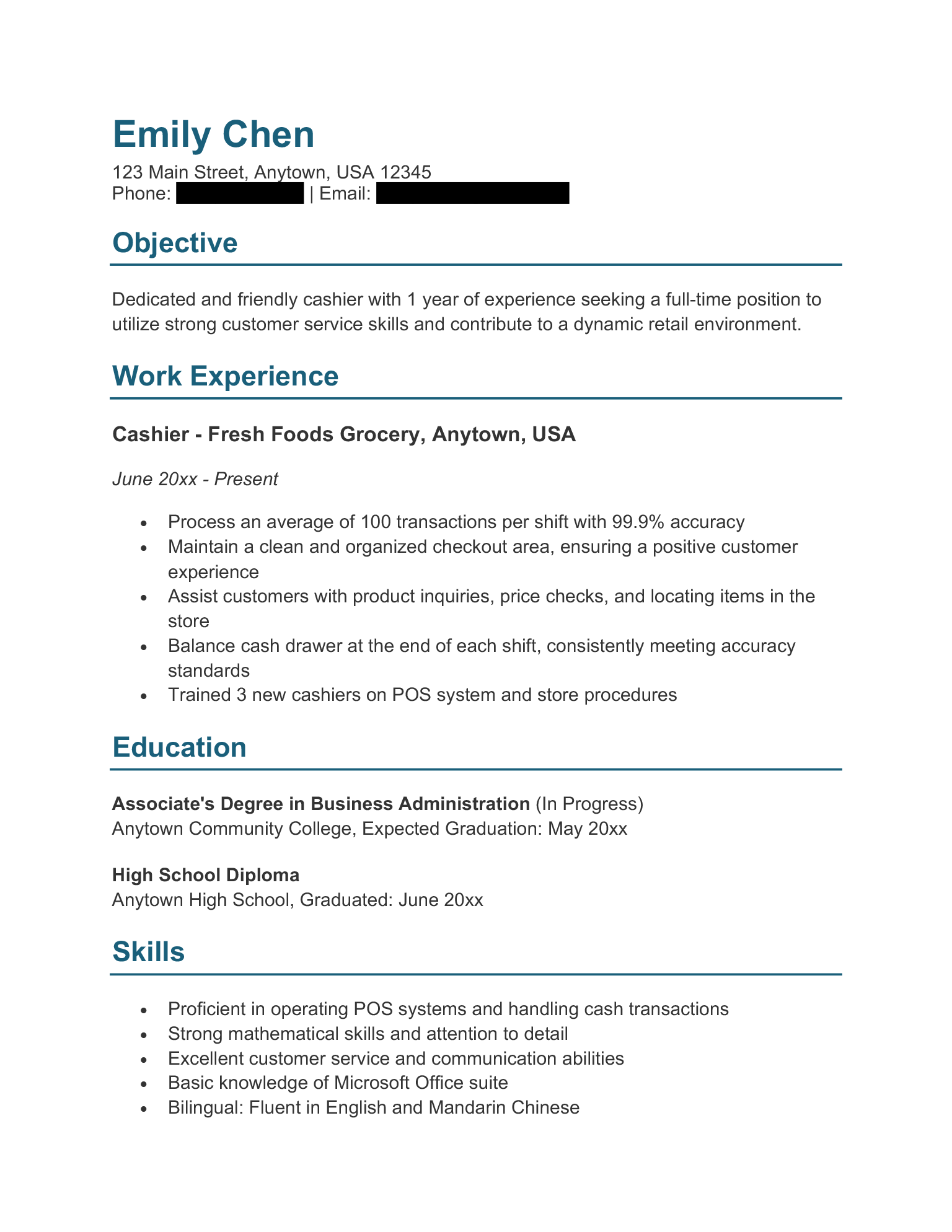
Alex Rodriguez was a college sophomore majoring in Marketing. He managed to land his first internship in a corporate setting with this simple resume.
Alex didn’t have any formal work experience when he submitted his application. However, he effectively used his resume to emphasize his other qualifications, such as his active involvement in campus organizations and relevant coursework:
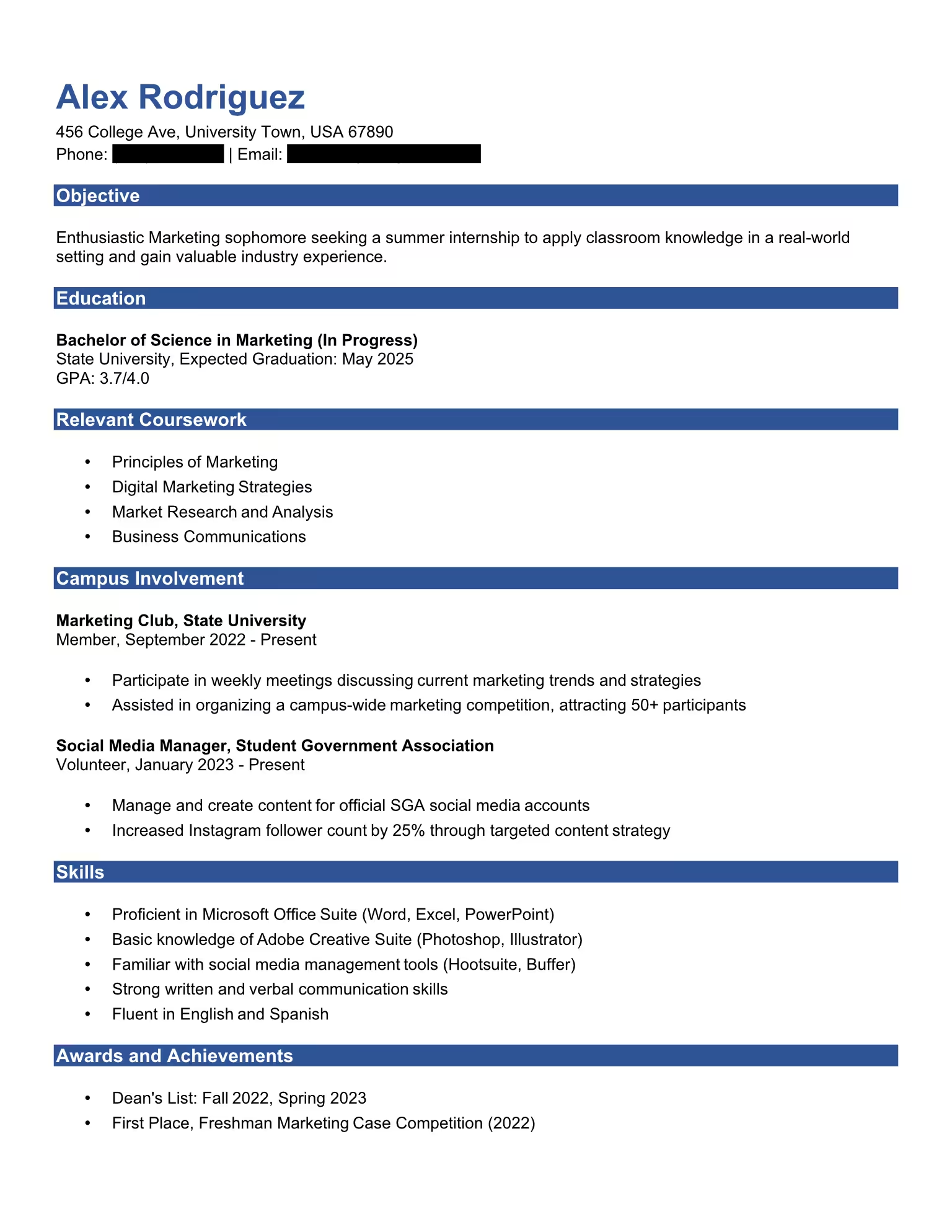
Sarah Johnson is an experienced volunteer and environmental advocate. She successfully leveraged her experience and relevant education in her resume to land a role at an NGO.
Notice that while Sarah’s professional development experience isn’t directly related to working at a nonprofit, it further demonstrates her passion for the environment:
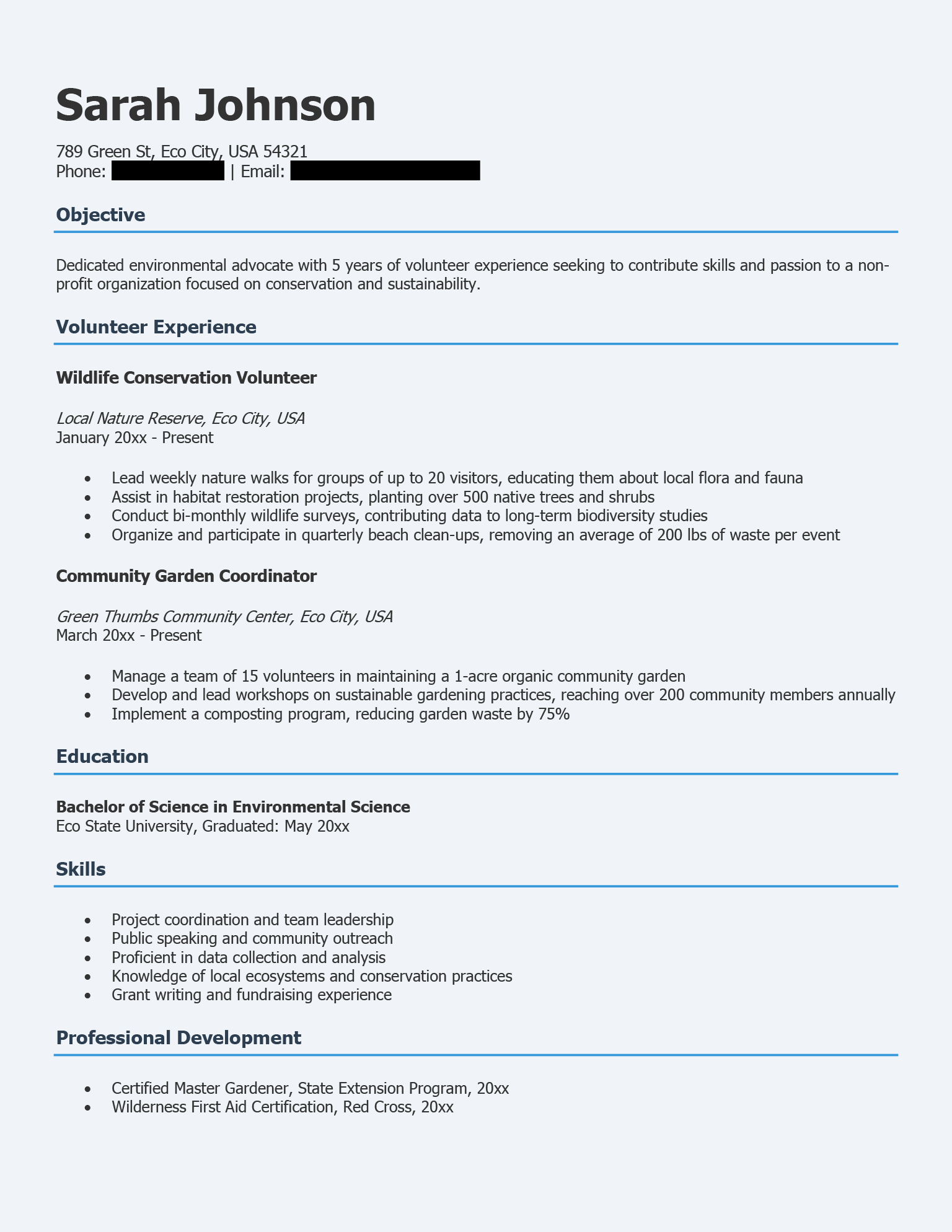
Customer service representative resume
With about 4 years of experience as a Customer Service Representative, Michael Torres applied for a senior-level customer service role and got hired with this resume.
While Michael doesn’t have a bachelor’s degree, he more than made up for his educational background by highlighting his top customer service-related certifications and achievements:
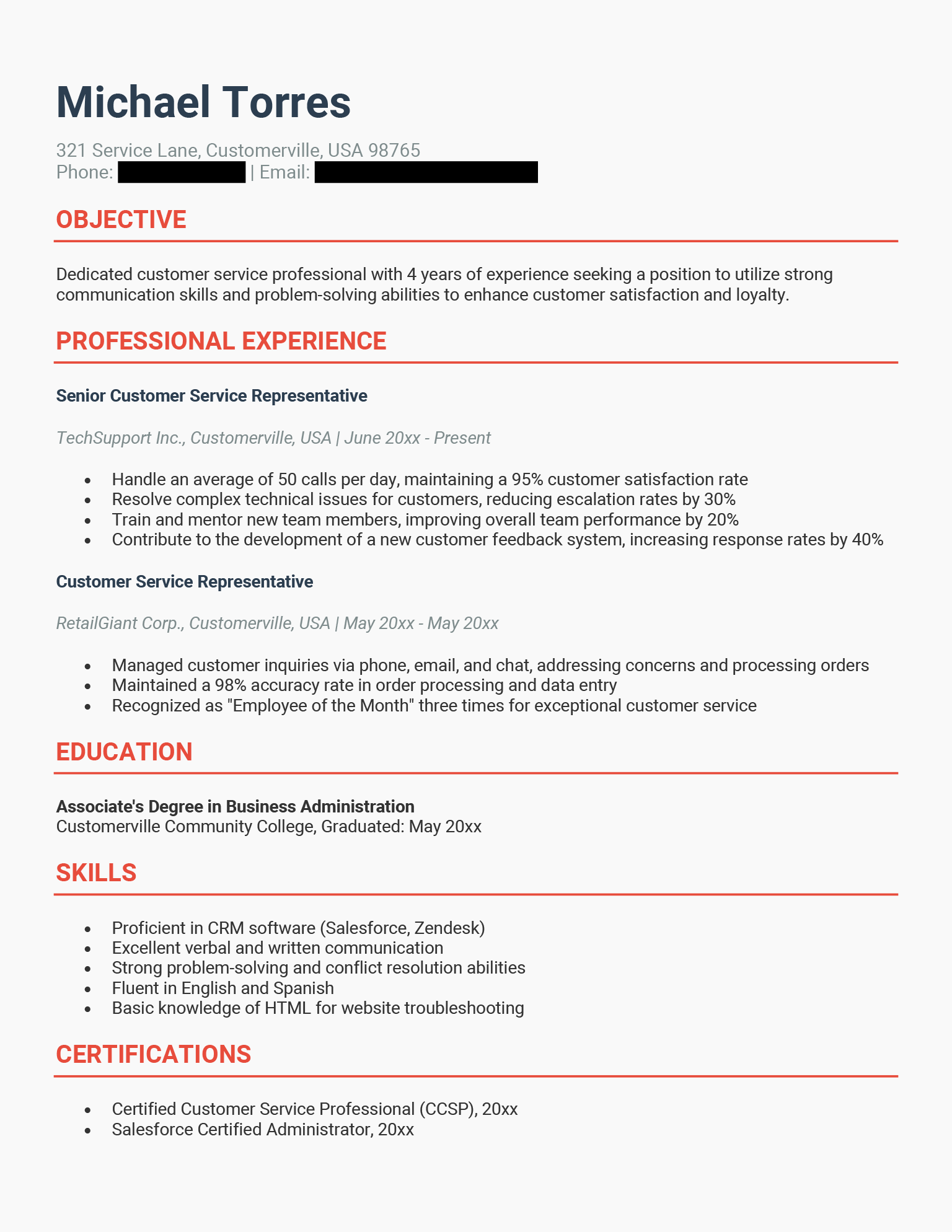
A food service veteran with plenty of experience, Jessica Rossi landed a competitive restaurant job using this resume.
What makes Sarah’s resume effective is that it leads with her industry-specific certifications and provides a clear overview of her relevant work experience (complete with numbers that prove what she accomplished).
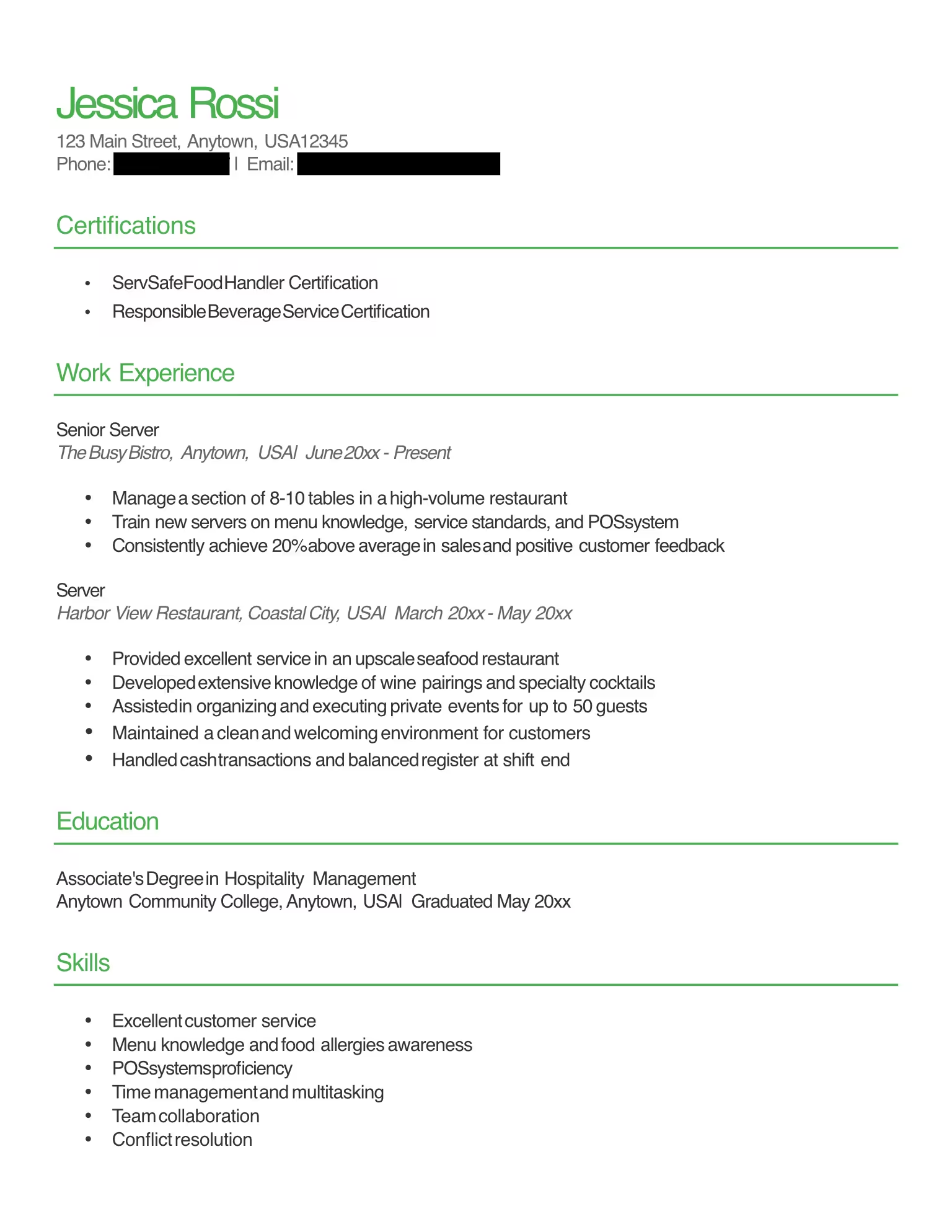
Michael Chen used this resume to land an assistant manager role in retail. While he has over 10 years of relevant experience, this was his first real managerial position.
To convince employers he was the right person for the job, Michael packed his resume with qualifications using a formal, highly efficient layout.
Additionally, he did a great job of highlighting his leadership skills using specific, quantifiable examples. As someone applying for an assistant manager role, a track record of strong leadership is exactly what employers were looking for on his resume.
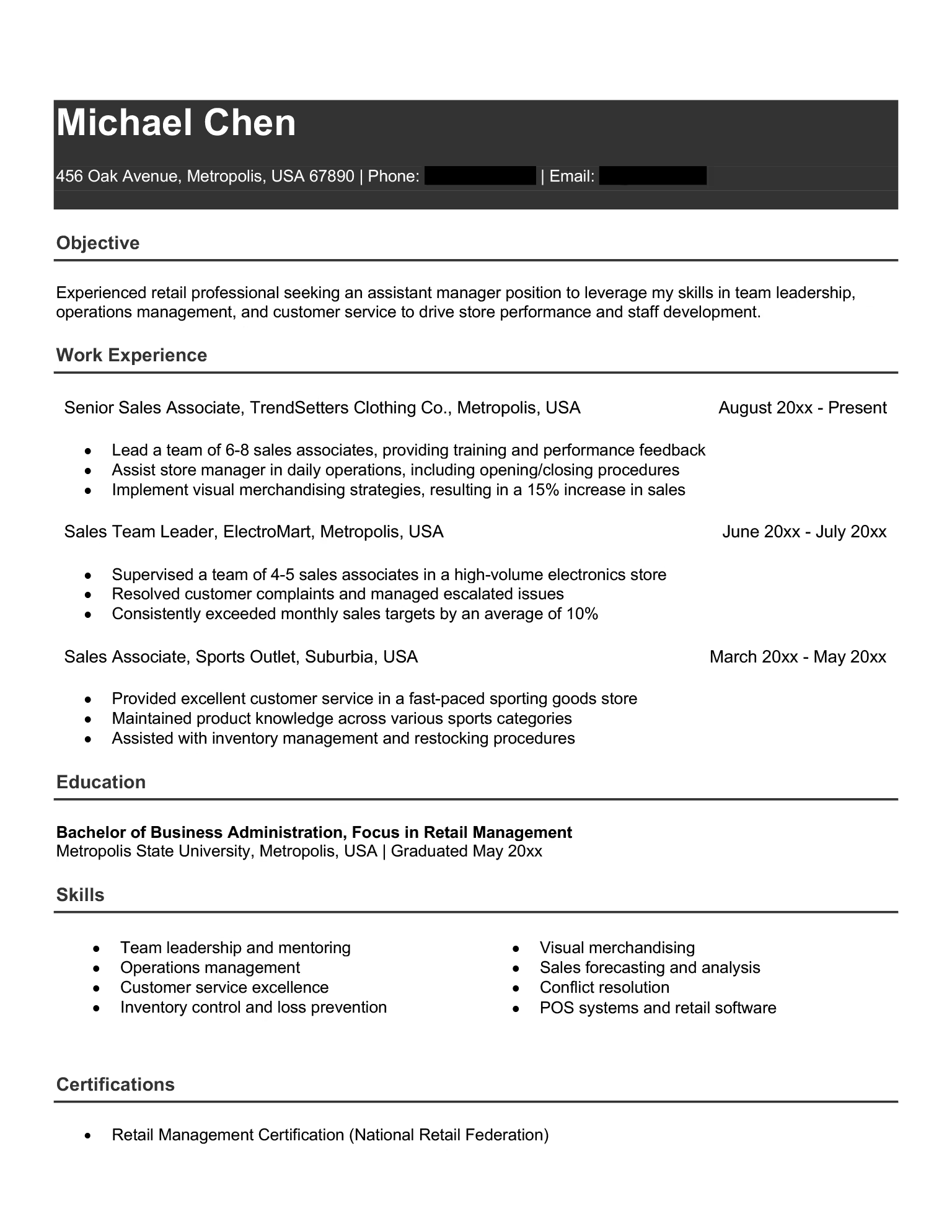
Emma was a recent high school graduate who managed to land work as a babysitter. Simple yet effective, her resume presented everything parents would want to know about her qualifications.
Notably, she included a separate section on her resume to highlight her Safe Sitter and CPR certifications. In a field with low barriers to entry like babysitting, these details helped Emma stand out from less qualified applicants, and assure parents that their kids would be in capable hands.
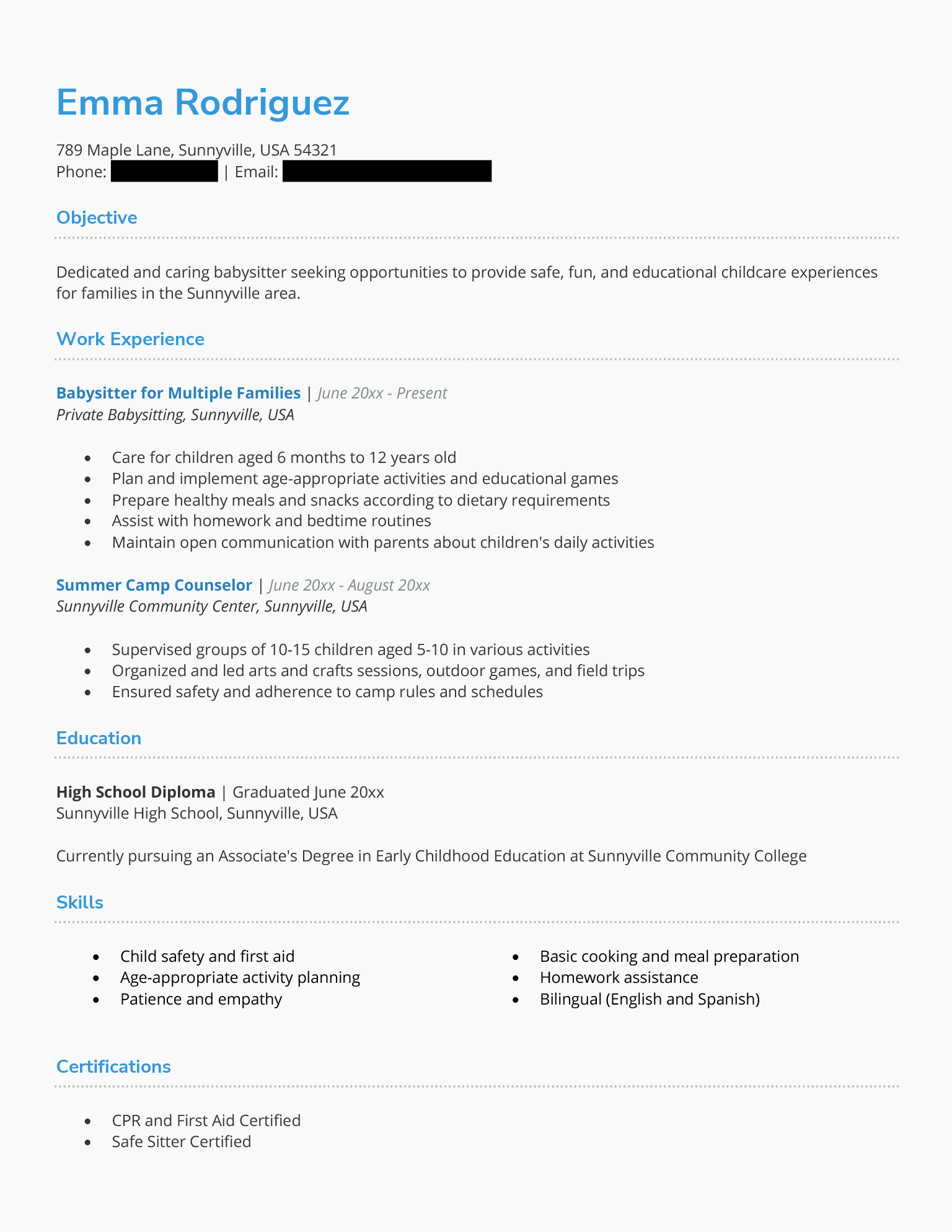
Administrative assistant resume
Alex Taylor was an experienced administrative assistant looking to take the next step in his career by applying for a senior-level position as an admin assistant.
The most impressive part of Alex’s resume is that he clearly outlined his career growth – all the way from a part-time administrative assistant to a full-time executive administrative assistant. This chronologically listed work experience showed the employer that he’s ambitious and capable of taking on greater responsibility in a senior-level position.
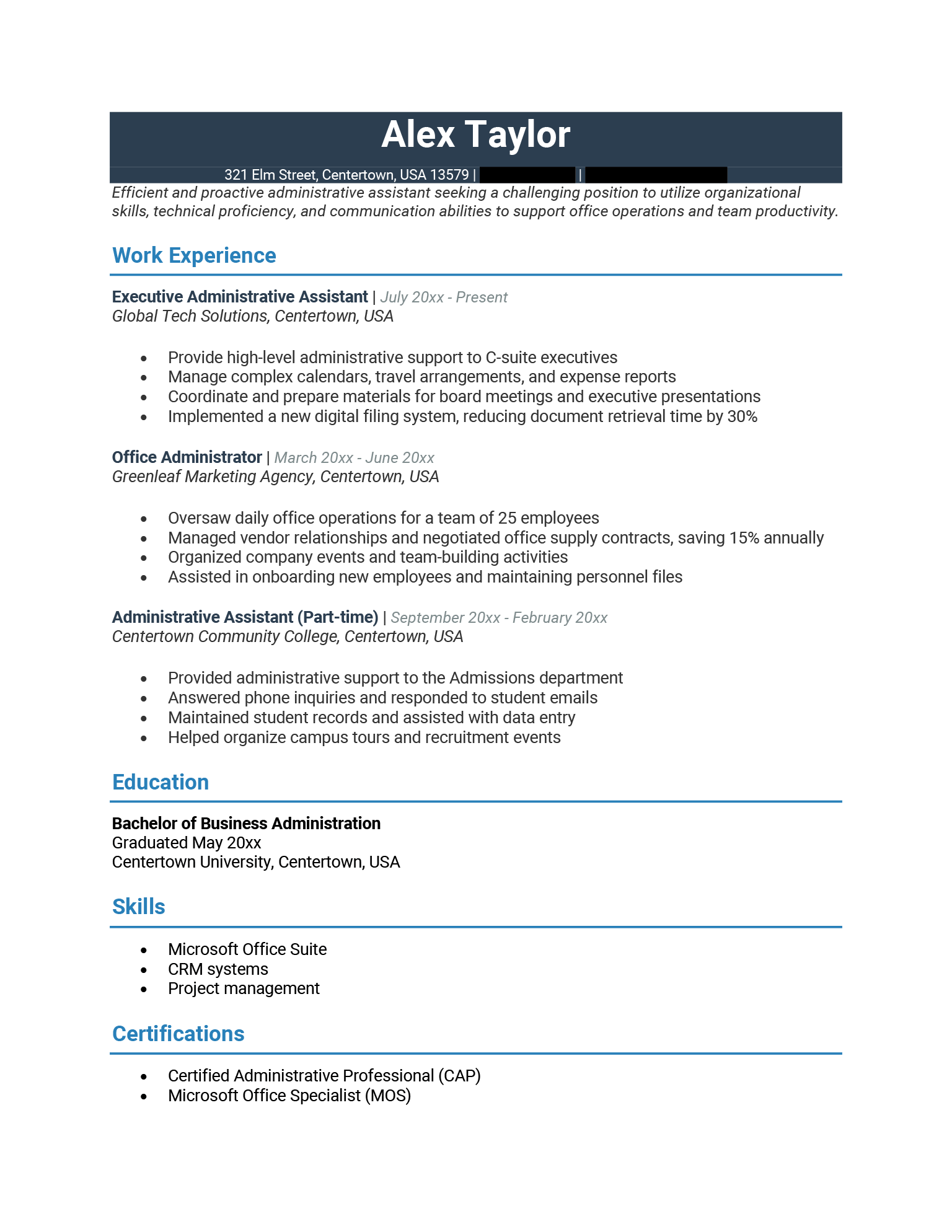
An experienced nurse, Olivia Patel managed to land her next role as a critical care nurse with this resume.
Neatly laid out and clear, her resume highlighted all her qualifications in a way that makes it easy for employers to scan through and find her relevant skills and certifications. What sets Olivia’s resume apart though is that she emphasized her record with patient-centered care throughout her work experience and skills sections.
In a field where certain basic certifications are a requirement to be hired, you need to find a way to stand out. Olivia’s ability to work with patients and get positive results is a huge plus that she demonstrated effectively with clear, concise examples.
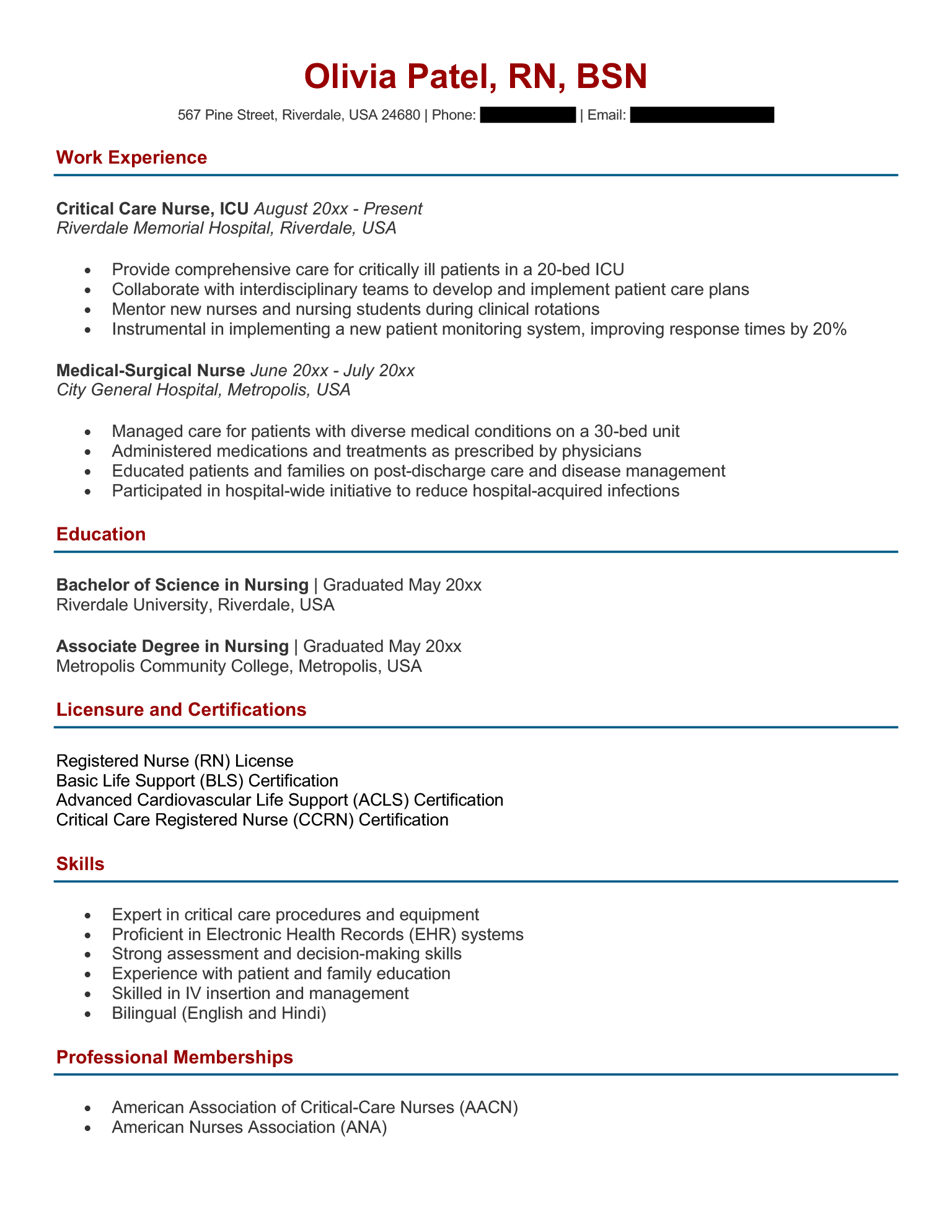
Ethan Nguyen is an enthusiastic English teacher who landed a new job at a high school thanks to his detailed, formal resume.
What made Ethan’s resume successful is his clearly outlined career progression.
He also emphasized the unique ways he brings value as a teacher. For example, he highlighted his passion for integrating technology into the classroom throughout his resume, providing specific examples of how this passion has resulted in positive outcomes.
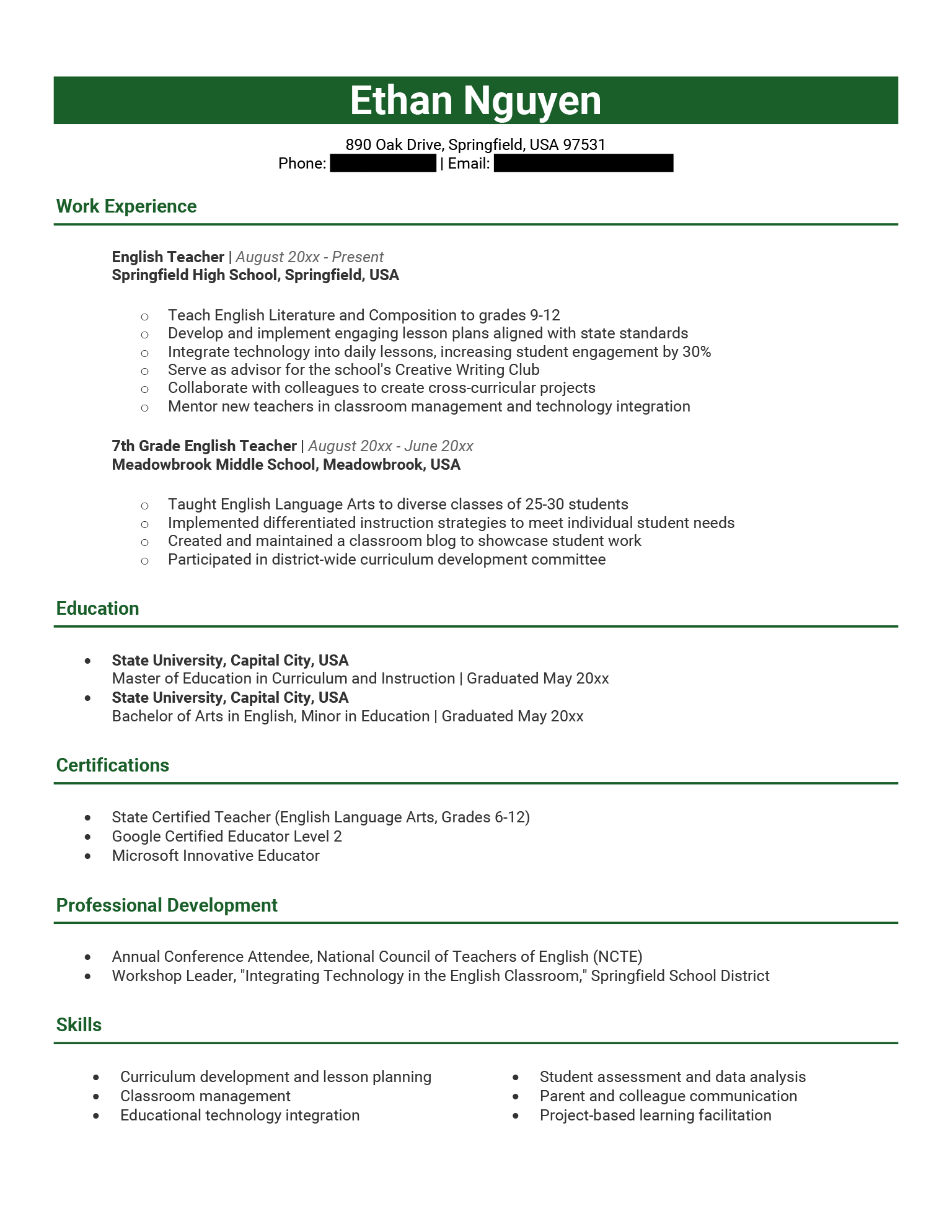
Make a resume in minutes
Pick your template, fill in a few details, and our builder will do the rest.
Resume Examples for Different Jobs & Industries
Accounting resume examples.
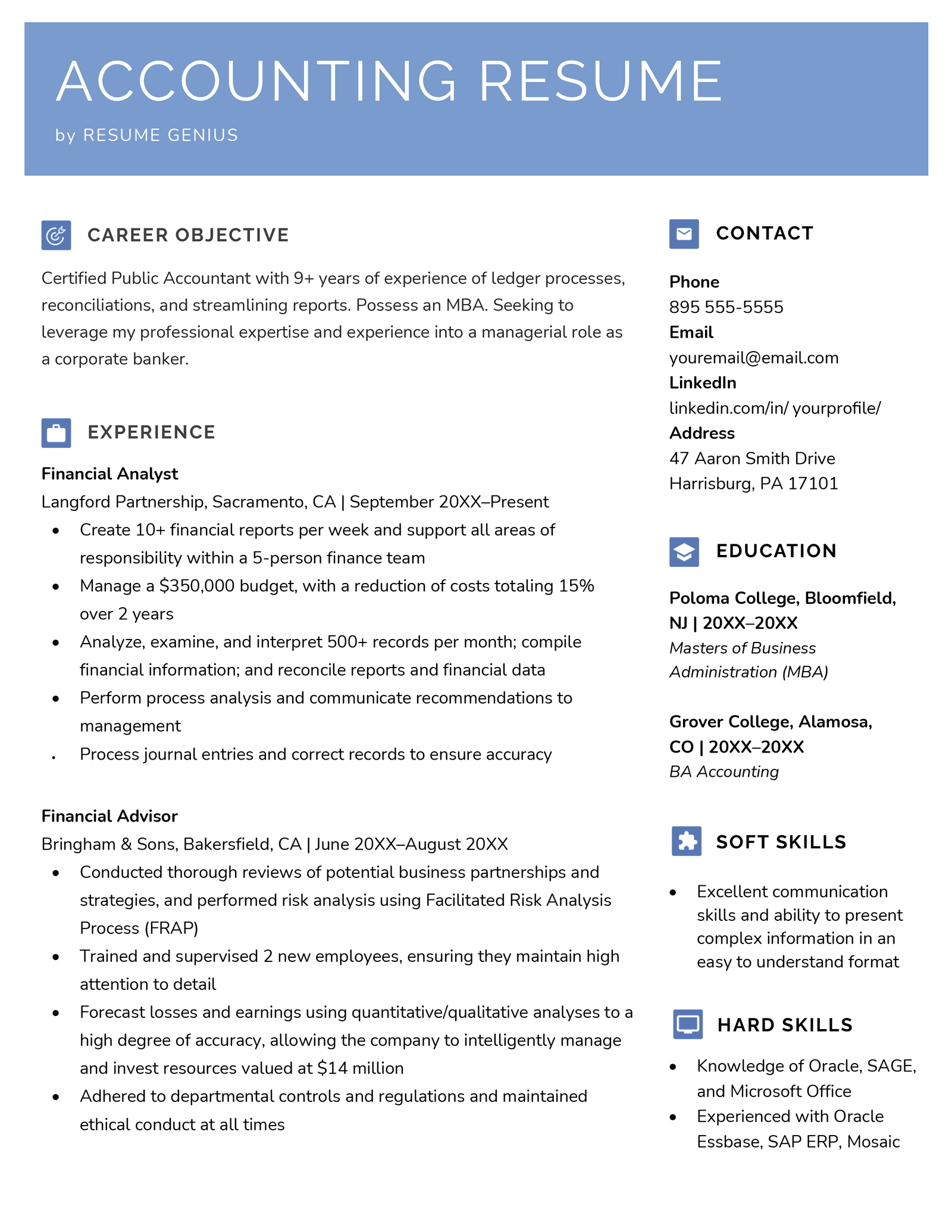
The Best Accounting Resume:
Opens with qualifications and experience.
The resume begins with a concise summary of the candidate’s qualifications, experience, and career goal. It immediately highlights key information such as their CPA certification, years of experience, and MBA, while also stating their desire to move into a managerial role in corporate banking.
Provides examples of quantifiable achievements
Throughout the experience section, this example uses specific numbers and percentages to demonstrate the candidate’s impact. For example, “Create 10+ financial reports per week,” “Manage a $350,000 budget, with a reduction of costs totaling 15% over 2 years,” etc.
Showcases a comprehensive accounting skill set
This example effectively separates soft skills and hard skills, providing a clear overview of the candidate’s abilities. For example, it highlights important soft skills like communication and presentation abilities, as well as specific technical skills and software proficiencies relevant to accounting and finance roles.”
All Related Accounting Resume Examples
- Accounting Resume
- Accounting Assistant Resume
- Certified Public Accountant (CPA) Resume
- Payroll Specialist Resume
- Staff Accountant Resume
- Tax Intern Resume
- Tax Preparer Resume
Administrative Resume Examples
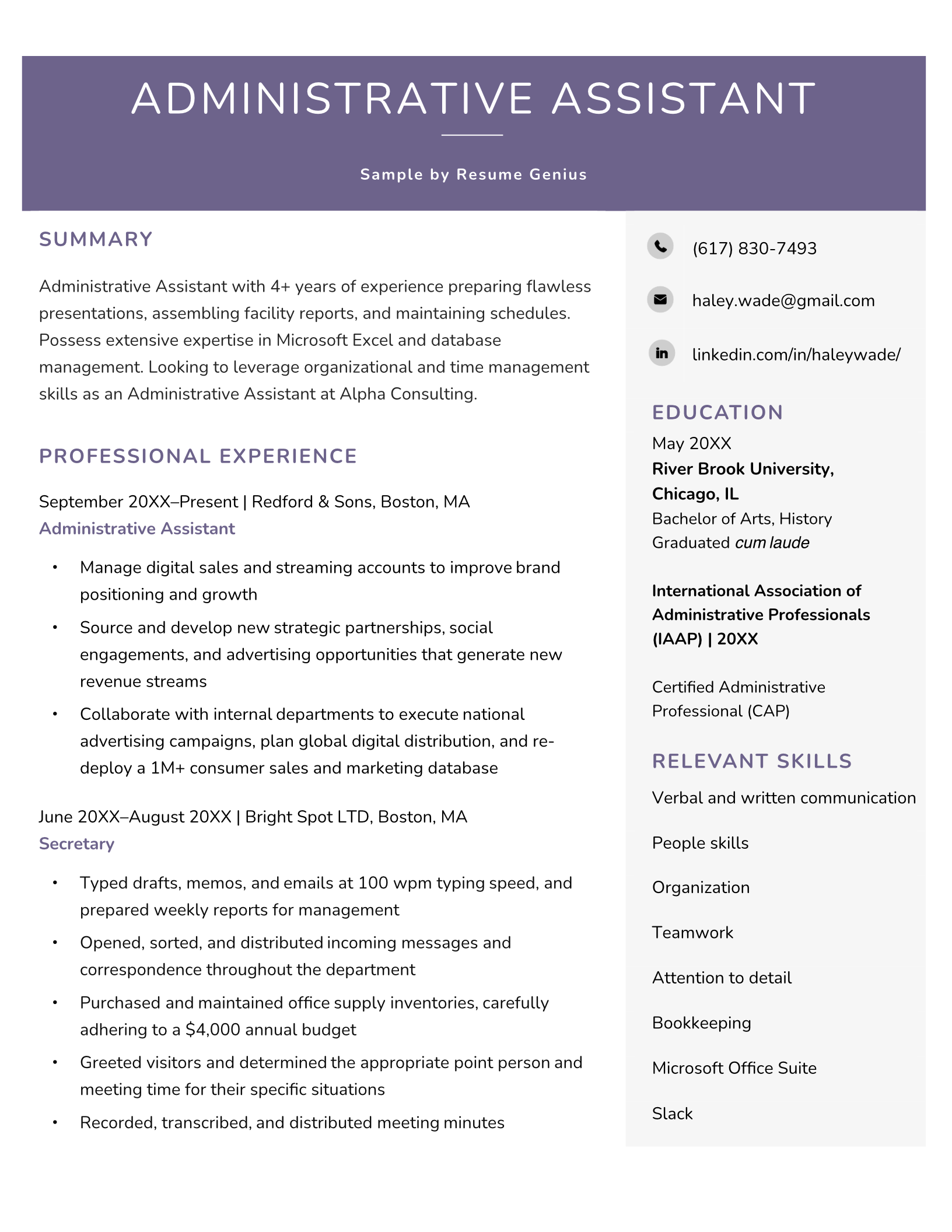
The Best Administrative Assistant Resume:
Effectively uses action verbs.
This example consistently begins each bullet point with strong action verbs such as “Manage,” and “Collaborate.” This effectively communicates the candidate’s role in each achievement.
Provides Detailed Professional Experience
The work history section of this example provides specific, action-oriented bullet points that showcase the candidate’s responsibilities and achievements. Importantly, it includes a variety of quantifiable information (e.g., “100 wpm typing speed,” “$4,000 annual budget”) and demonstrates a progression of responsibilities from Secretary to Administrative Assistant.
Includes a Relevant Certification
The candidate highlights their Certified Administrative Professional (CAP) certification, demonstrating their commitment to professional development.
All Related Administrative Resume Examples
- Administrative Assistant Resume
- Office Administrator Resume
- Office Assistant Resume
- Business Administration Resume
- Personal Assistant Resume
- Executive Assistant Resume
- Receptionist Resume
AI & Machine Learning Resume Examples
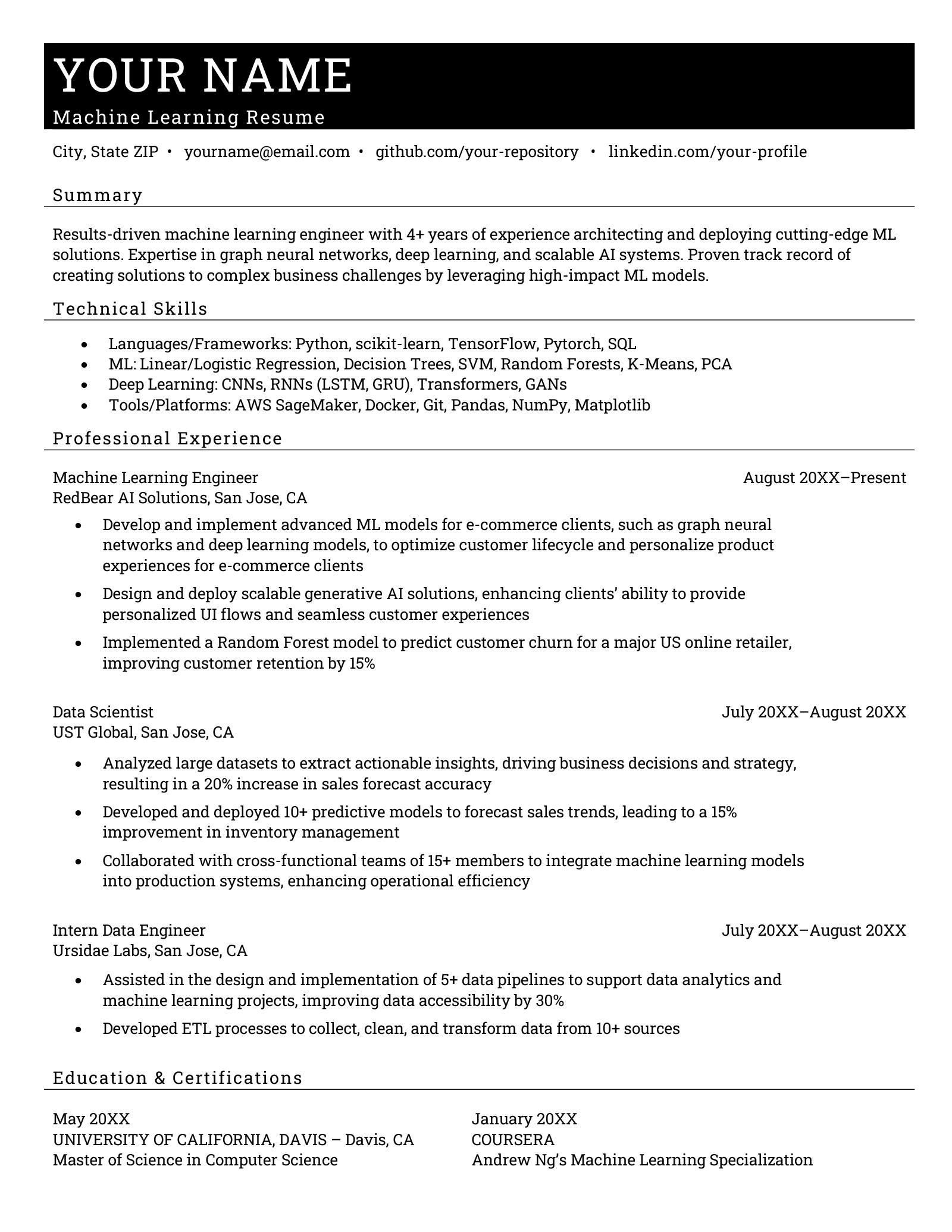
The Best Machine Learning Resume Example
Demonstrates technical expertise.
This example effectively showcases the candidate’s proficiency in cutting-edge machine learning techniques and tools. This level of detail is crucial in the fast-evolving field of machine learning and demonstrates the candidate’s up-to-date knowledge.
Quantifies achievements and impact
Throughout the professional experience section, this resume uses specific numbers and percentages to illustrate the candidate’s contributions and their impact on business outcomes. For example, “improving customer retention by 15%”. Quantifiable results are particularly valuable in data-driven fields like machine learning and data science, as they provide concrete evidence of the candidate’s ability to deliver business value.
Balances technical skills with business acumen
While this resume clearly emphasizes technical skills, it also demonstrates the candidate’s ability to apply these skills to solve real business problems. Phrases like “optimize customer lifecycle” and “personalize product experiences” show that the candidate understands how to translate technical capabilities into business value.
All AI & Machine Learning Resumes
- Machine Learning Resume
- Big Data Resume
- Data Engineer Resume
- Data Scientist Resume
Arts & Design Resume Examples
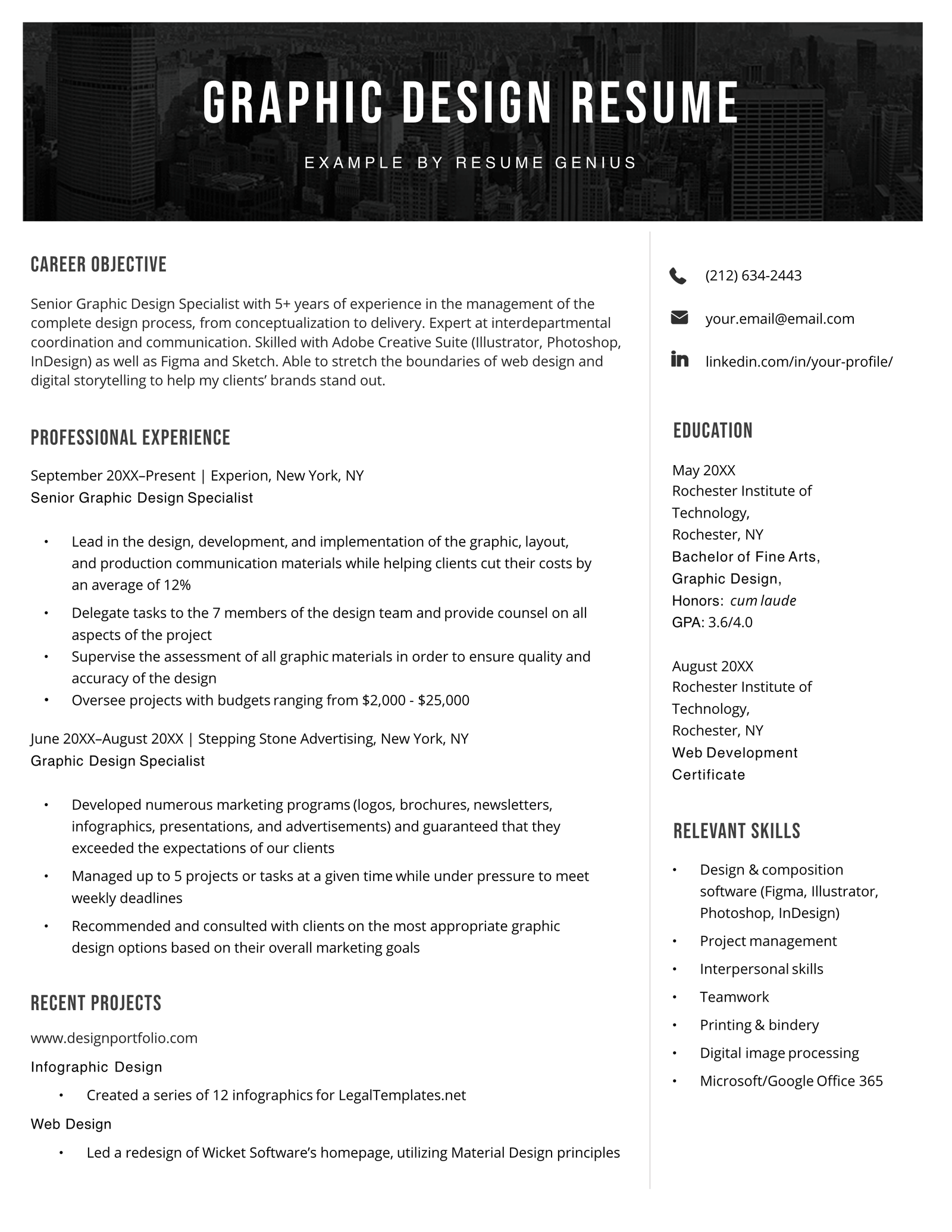
The Best Graphic Design Resume:
Showcases management experience.
Management skills are also important for design jobs, and this candidate shows they’re ready to enter a leadership role by citing their experience leading a team.
Highlights Cost Reduction for Clients
Businesses and clients are always looking to cut costs. By demonstrating the ways they’ve reduced costs in the past, this candidate positions themselves as a potentially valuable hire.
Clearly Lists Technical Proficiency
This resume includes a clear list of industry-standard design software that the candidate is skilled with, such as Adobe Creative Suite, Figma, and Sketch.
All Arts & Design Resume Examples
- Designer Resume
- Acting Resume
- Artist Resume
- Dance Resume
- Model Resume
- Stage Manager Resume
- Theater Resume
- Film Resume
- Game Design Resume
- Graphic Design Resume
- Video Editor Resume
- Arts Administrator Resume
- Musician Resume
Banking Resume Examples
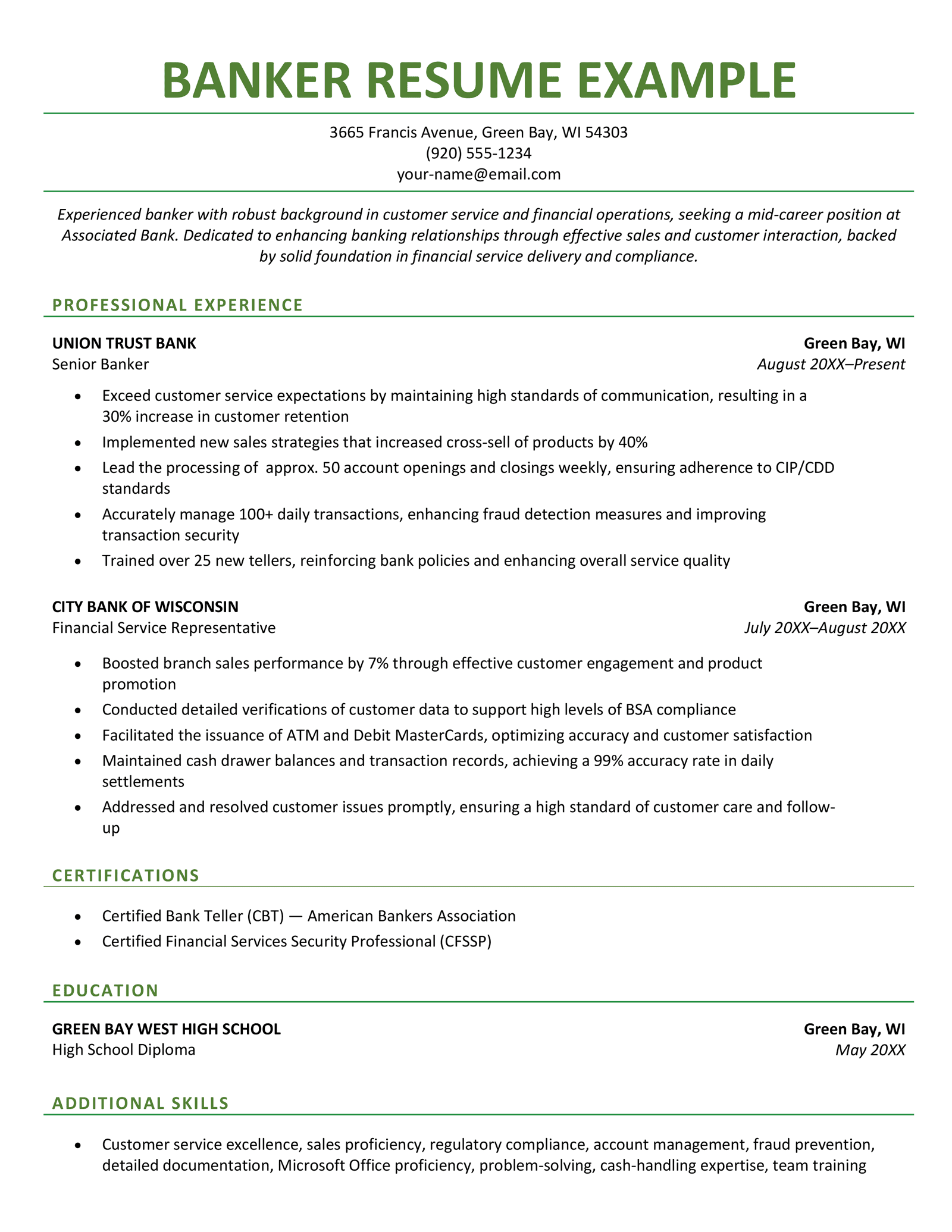
The Best Banker Resume:
Cites proven results.
The candidate highlights specific achievements in their resume, such as increasing customer retention by 30%, demonstrating their ability to make a positive impact.
Focuses on Leadership Skills
By highlighting the training of over 25 new tellers and managing critical financial processes, the candidate emphasizes ttheir role in fostering team growth.
Includes Certifications
The inclusion of professional certifications, along with a diverse set of banking-related skills, helps emphasize the candidate’s qualifications and commitment to professional development.
All Banking Resume Examples
- Banker Resume
- Personal Banker Resume
- Investment Banking Resume
- Bank Teller Resume
- Branch Manager Resume
- Insurance Agent Resume
- Finance Resume
- Financial Analyst Resume
Billing & Collections Resume Examples
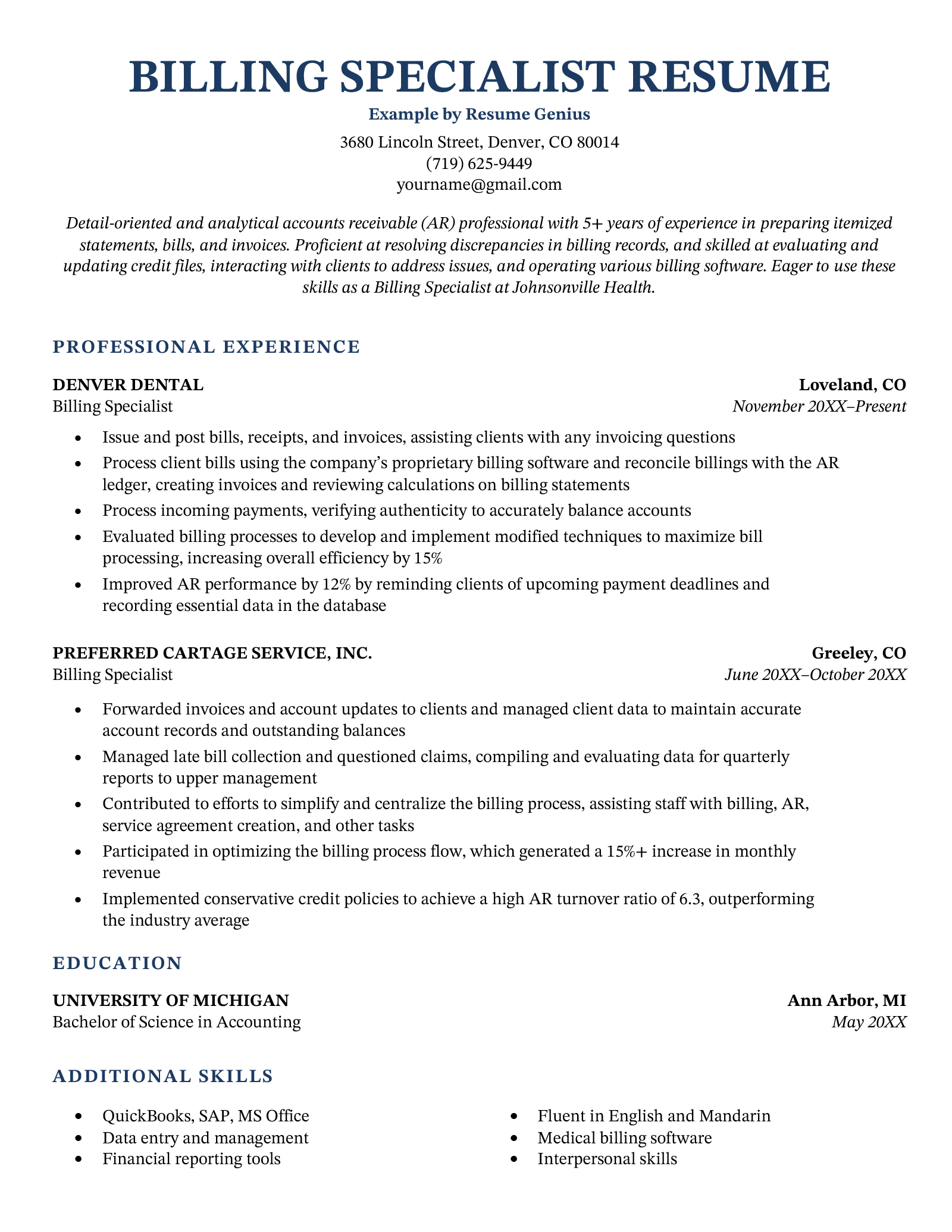
The Best Billing Specialist Resume:
Opens with a professional summary.
This example begins with a concise yet comprehensive summary that highlights the candidate’s years of experience, key skills, and career objective.
Uses Clean Formatting
Billing is a relatively formal industry, and this resume uses an appropriately formal format. Each section is cleanly laid out with clear headers, making the candidate’s information easy to scan.
Provides Quantified Achievements
Throughout the professional experience section, this resume example includes specific numbers to show the candidate’s success as a billing specialist.
All Billing & Collections Resume Examples
- Billing Specialist Resume
- Medical Billing and Coding Resume
- Accounts Receivable Resume
Business Operations Resume Examples
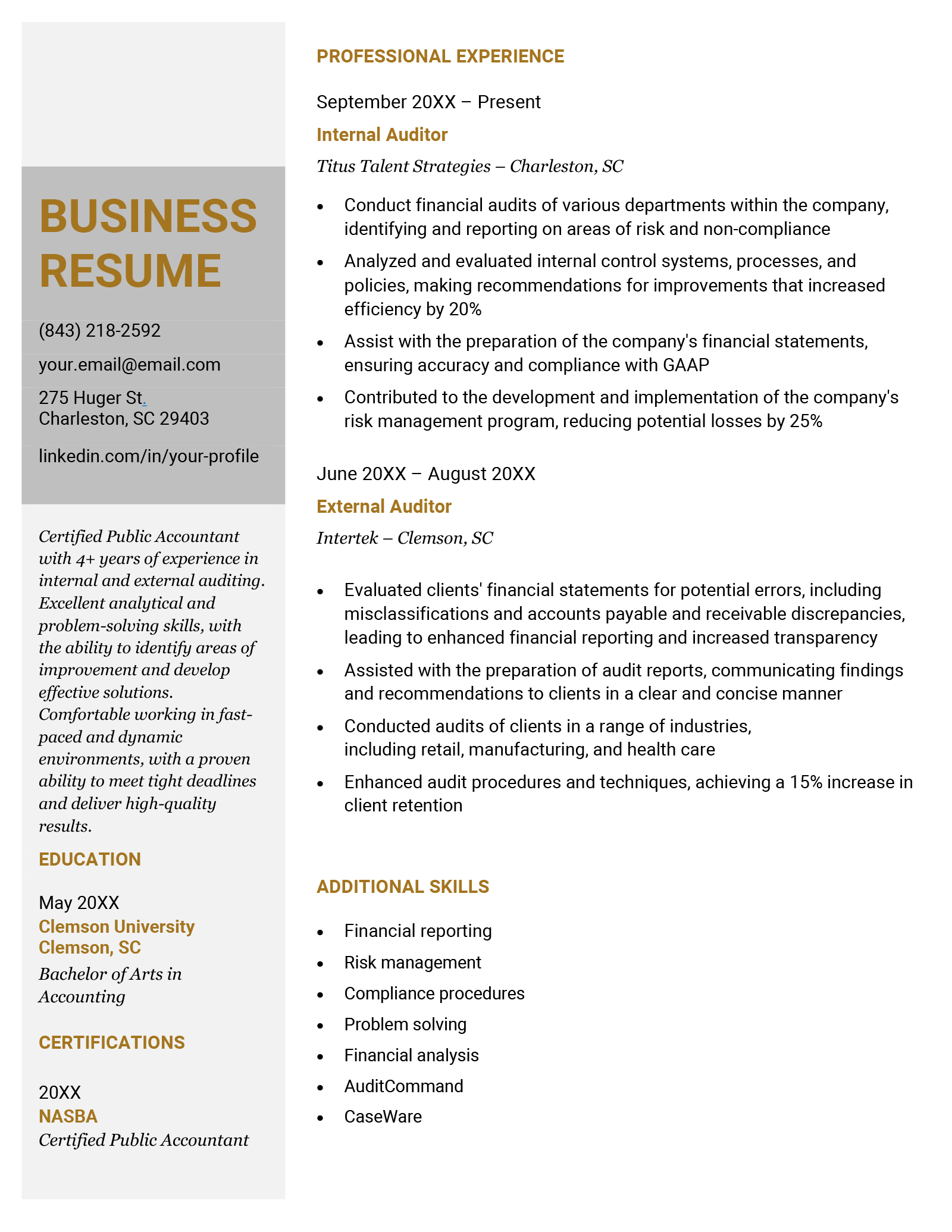
The Best Business Resume:
Emphasizes cost-saving initiatives.
By mentioning specific amounts saved through various strategies, this candidate positions themselves as someone who can help their company’s bottom line.
Demonstrates Progression in Responsibilities
The resume shows growth from basic office functions to managing the schedules of a team of 50 employees, showing that the candidate is trusted by their employers and has the ability to take on increasing responsibilities.
Includes a Blend of Hard and Soft Skills
The resume balances technical abilities with interpersonal skills such as team leadership and management skills, which are essential to keep an office running smoothly.
All Business Operations Resume Examples
- Business Resume
- Data Analyst Resume
- Executive Resume
- Product Manager Resume
- Project Manager Resume
- Human Resources (HR) Resume
- Supply Chain Resume
- Event Planner Resume
- Transcriptionist Resume
- Translator Resume
Child Care and Pet Care Resume Examples
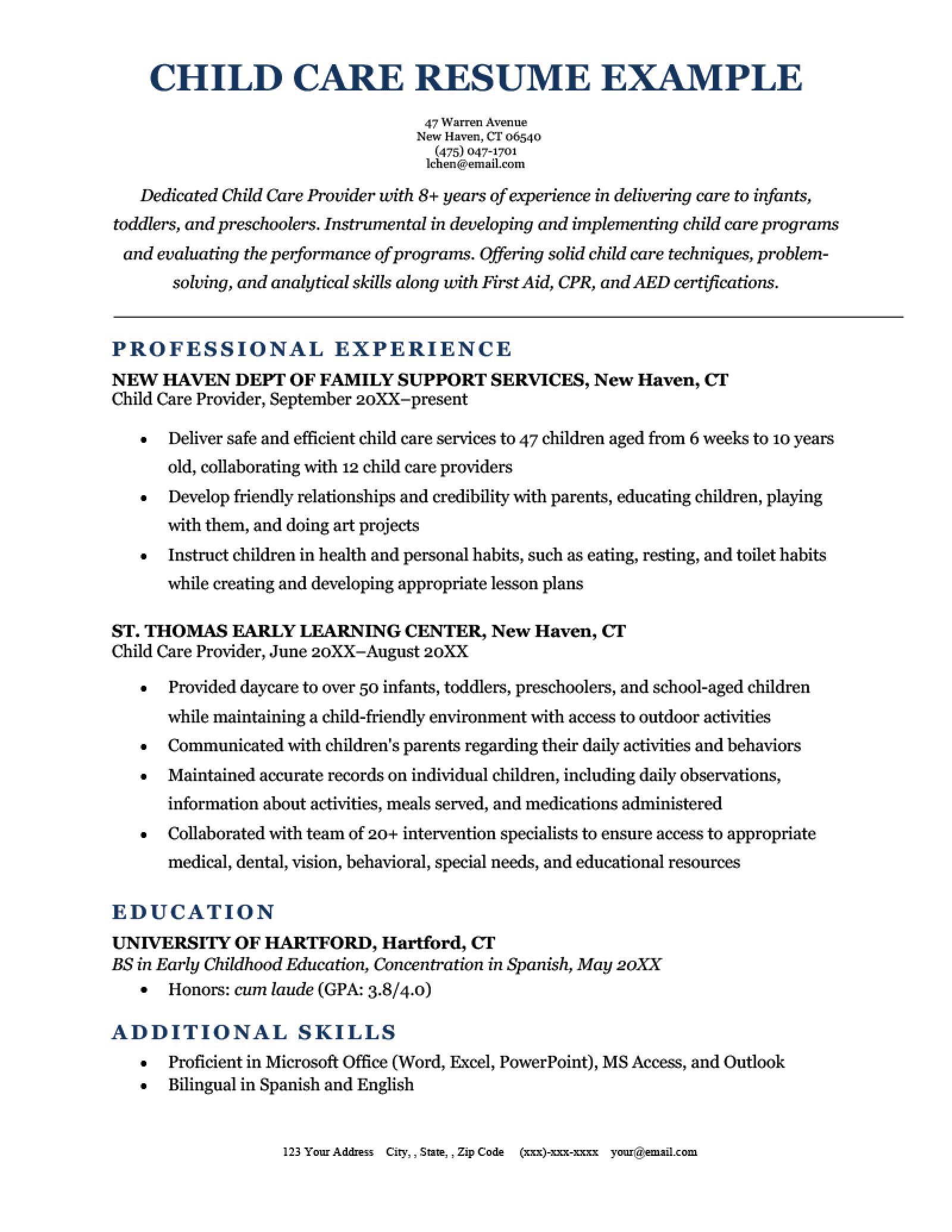
The Best Child Care Resume:
Includes relevant educational background.
Not everyone who works in childcare has a degree in that field — that this candidate does is a major plus. To improve their chances of getting noticed, they list it prominently on their resume.
Lists Relevant Additional Information
The resume includes a section for education that highlights academic achievements (cum laude, GPA) and a section for additional skills that are relevant to the job (language skills, computer proficiency). This approach can be easily adopted by other job seekers to showcase their educational background and any extra skills that might set them apart from other candidates.
Highlights Vital Certifications
It’s essential for childcare workers to have certain skills and certifications. This example clearly lists any required skills (such as CPR and AED certification). This demonstrates to employers that the candidate has the specific qualifications needed for the job.
All Child and Pet Care Resume Examples
- Child Care Resume
- Veterinary Technician Resume
- Dog Walker Resume
- Daycare Resume
- Babysitter Resume
- Nanny Resume
Computer Software Resume Examples
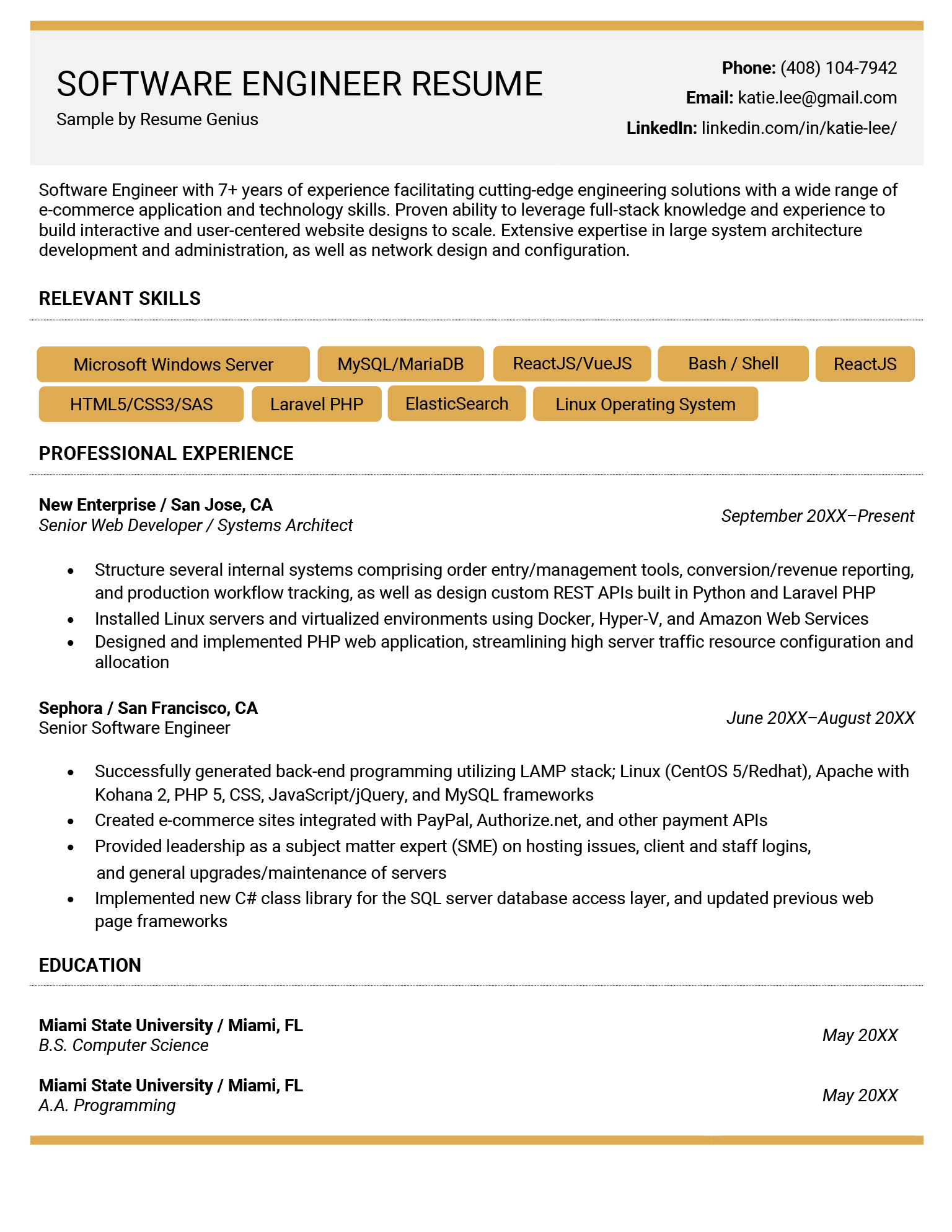
The Best Software Engineer Resume:
Showcases programming language knowledge.
This applicant demonstrates proficiency in a wide range of programming languages, including PHP, JavaScript, and C#, as well as frameworks like React.js and Laravel, showing their versatility and ability to work on diverse projects.
Highlights Successful Projects
By sharing concrete examples of their work, including a PHP web application and ecommerce site, the candidate demonstrates their ability to deliver impactful results.
Demonstrates Strong Problem-Solving Skills
This candidate’s work experience section shows that they have tackled complex challenges, such as streamlining high server traffic resource configuration and allocation, implementing new C# class libraries for SQL Server database access layers, and updating previous web page frameworks. These examples highlight their ability to analyze and solve complicated problems.
All Computer Software Resume Examples
- Software Engineer Resume
- Cyber Security Resume
- Computer Technician Resume
- Programmer Resume
- Computer Science Resume
- DevOps Resume
Construction Resume Examples
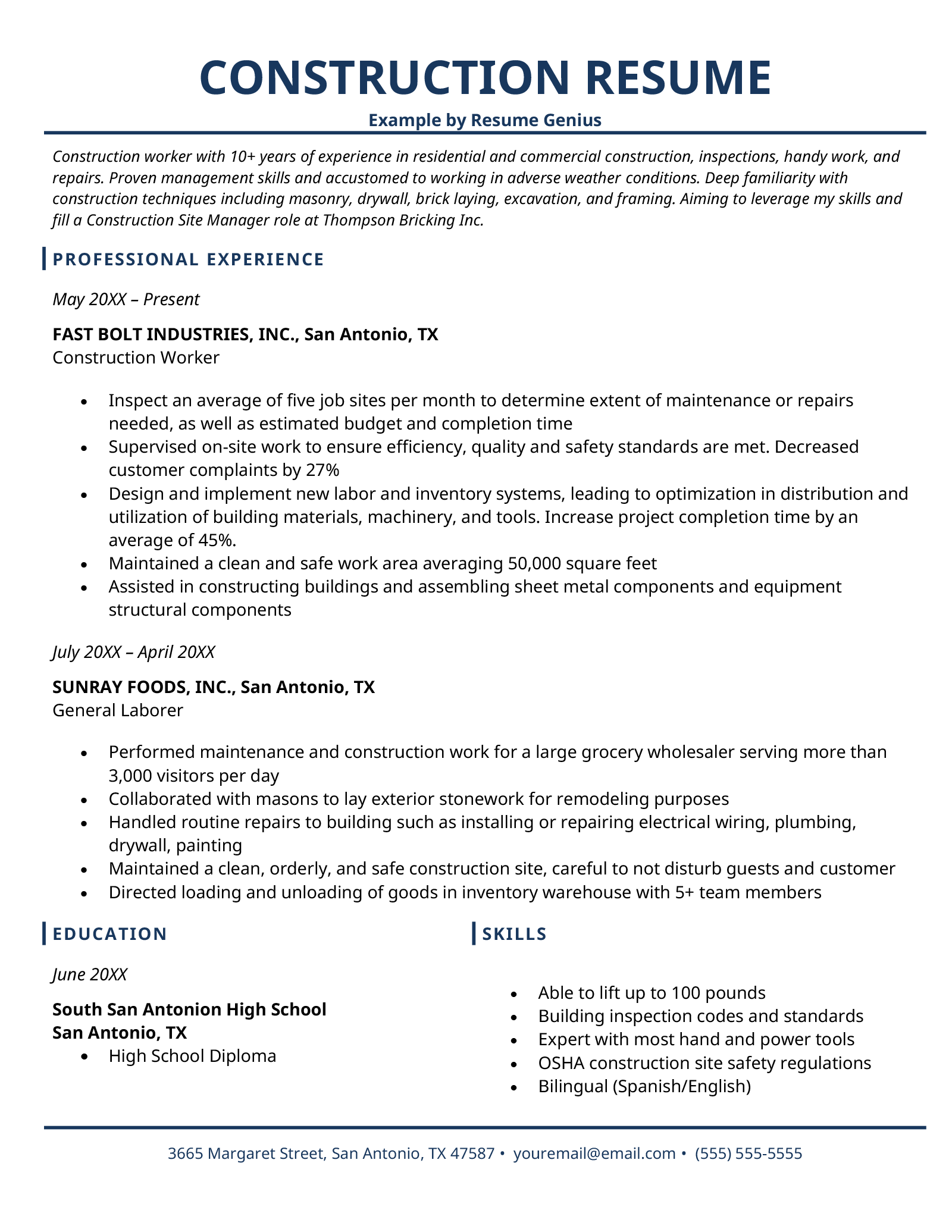
The Best Construction Resume:
Quantifies achievements in construction roles.
Throughout the professional experience section, this example uses specific numbers and percentages to demonstrate the candidate’s impact and capabilities. These quantifiable achievements provide concrete evidence of the candidate’s effectiveness in construction-related tasks.
Emphasizes Safety and Site Management
This resume highlights the candidate’s attention to safety and site management, which are critical in construction. For example, in the experience section this candidate mentions their track record of maintaining a safe and orderly site.
Demonstrates Leadership and Efficiency Improvements
This example showcases the candidate’s ability to improve processes and lead teams, which is valuable for higher-level construction positions. Examples like “Supervised on-site work to ensure efficiency, quality and safety standards are met” highlight the candidate’s potential for management roles in construction.
All Construction Resume Examples
- Construction Resume
- Construction Project Manager Resume
- Architecture Resume
- Contractor Resume Examples
Customer Service Resume Examples
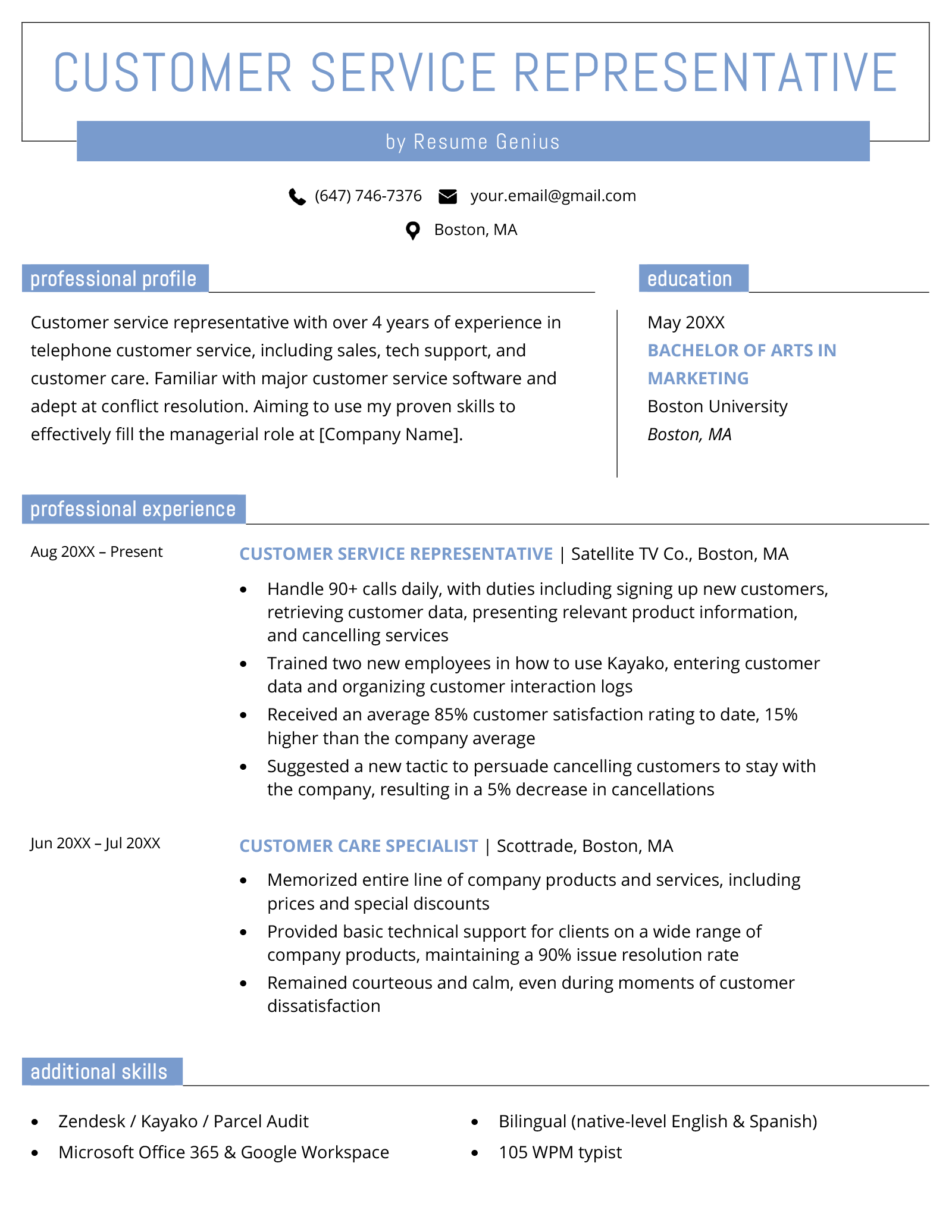
The Best Customer Service Resume:
Leads with hard numbers.
Quantified achievements related to reducing customer cancellations indicate a strategic understanding of customer retention. In industries like sales and marketing, hard numbers are the best way to demonstrate a record of success.
Demonstrates Conflict Management Abilities
In customer facing roles, patience and excellent conflict resolution skills like the ones displayed by this applicant are essential.
Highlights Relevant Technical Skills
To convince employers they’re ready to contribute to the company’s success, the applicant lists CRM and help desk software they’re familiar with in the skills section and provides examples of how they’ve used these platforms in their work.
All Customer Service Resume Examples
- Customer Service Resume
- Customer Service Supervisor Resume
- Call Center Resume
- Help Desk Resume
- Technical Support Resume
- Travel Agent Resume
Data & Systems Administration Resume Examples
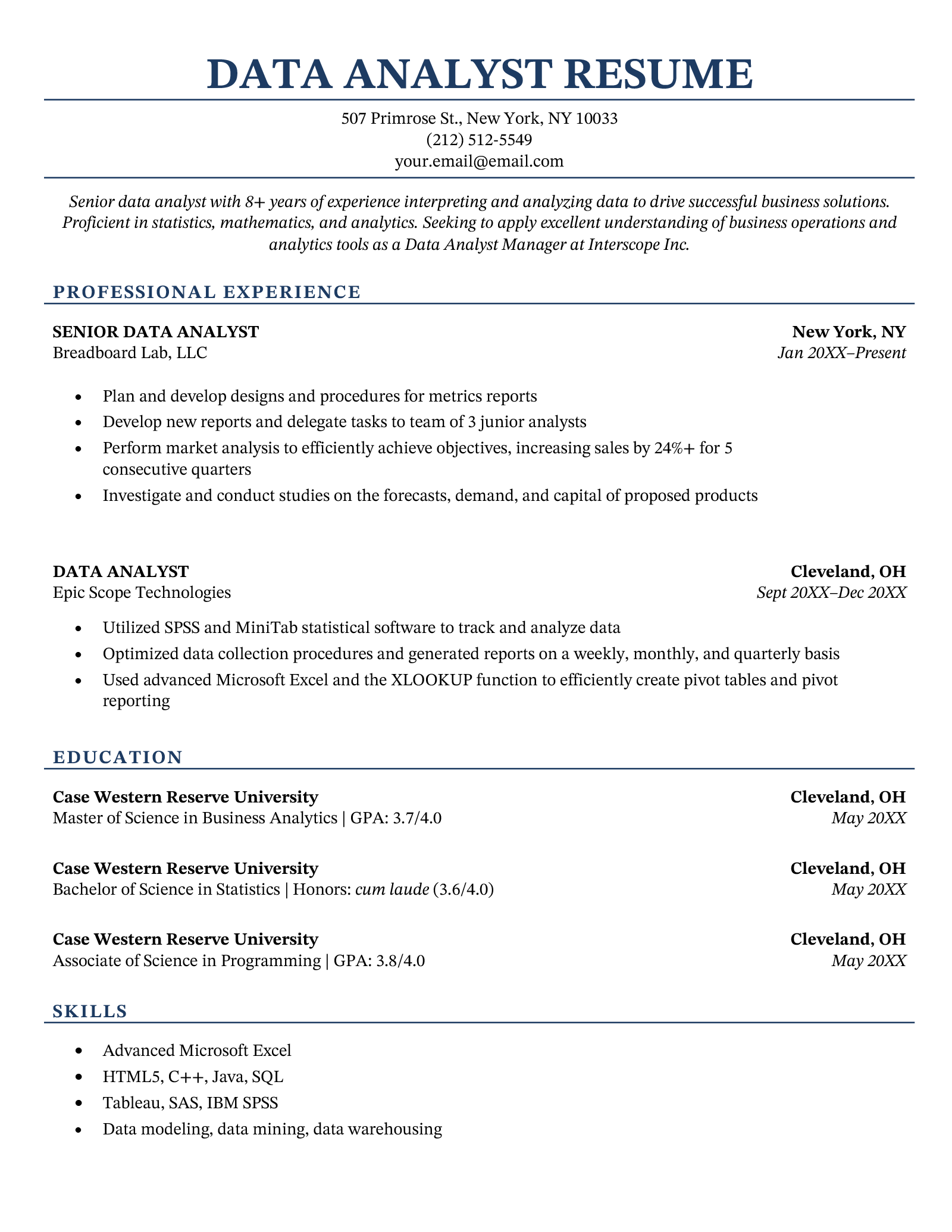
The Best Data Analyst Resume:
Quantifies achievements.
By including specific metrics, such as increasing sales by 24%+ for five consecutive quarters, the resume provides concrete evidence of the candidate’s impact. This quantification of results demonstrates the applicant’s ability to drive tangible business outcomes through data analysis.
Highlights Technical Proficiency
The resume showcases a broad range of technical skills, from statistical software to programming languages. This comprehensive skill set presents the candidate as a versatile analyst capable of handling various data-related tasks and adapting to different workflows.
Balances Technical and Business Acumen
While emphasizing technical skills, the resume also highlights the candidate’s understanding of business operations. This balance presents a data analyst who can bridge the gap between data analysis and practical business applications.
All Data & Systems Administration Resume Examples
- System Administrator Resume
Education Administration Resume Examples
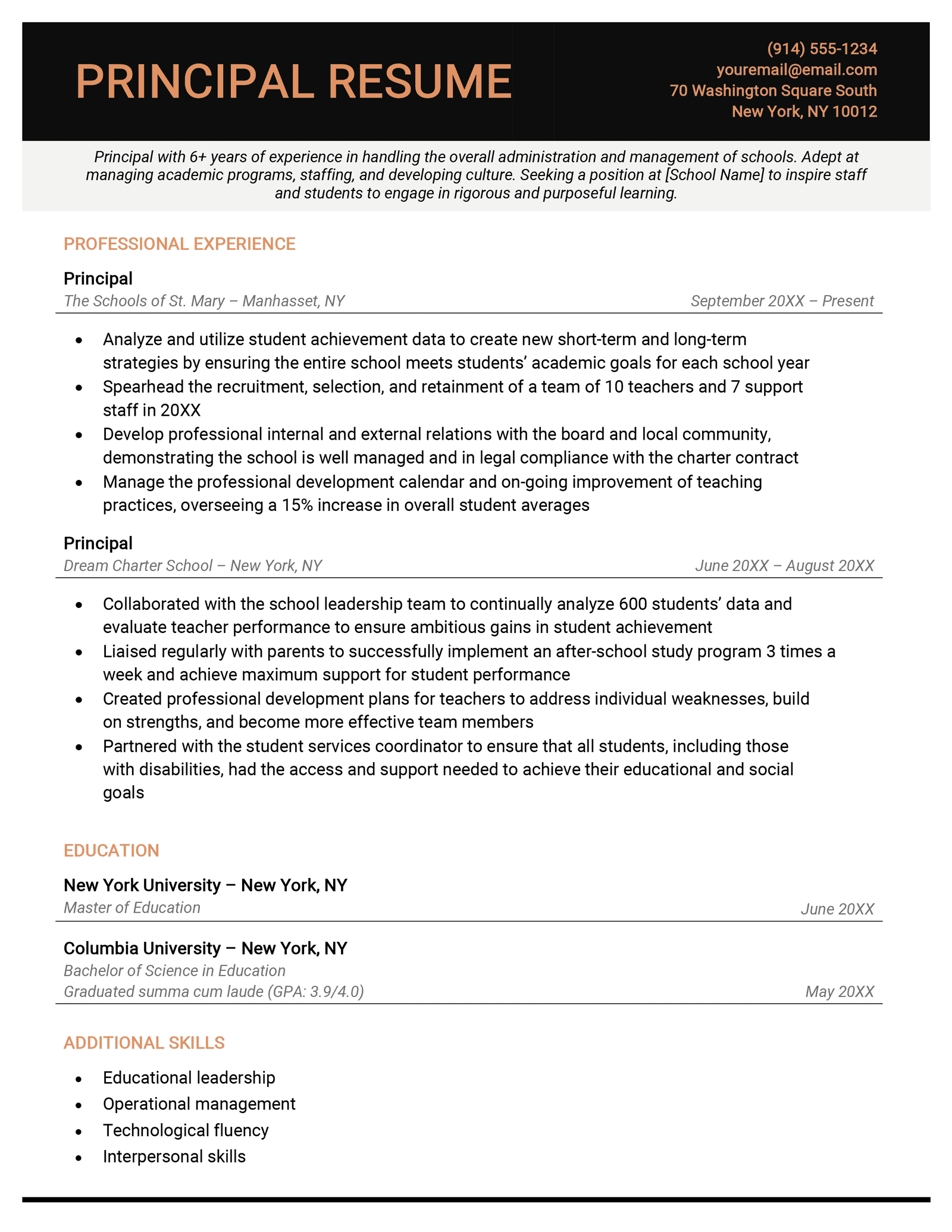
The Best Principal Resume:
Showcases boosted student achievement.
This principal increased overall student average grades by 15%. Their data-driven approach creates strategies that meet academic goals for each school year.
Indicates the Ability to Build Strong Educational Teams
This principal also excels at recruiting and retaining staff. They assembled a team of 10 teachers and 7 support staff, fostering their professional development.
Champions Inclusive Education
Additionally, this school leader partnered with student services to ensure all students, including those with disabilities, receive necessary support. The after-school program they introduced goes a long way to maximizing student performance.”
All Education Administration Resume Examples
- Principal Resume
- Assistant Principal Resume
- Superintendent of Schools Resume
Education Support Resume Examples
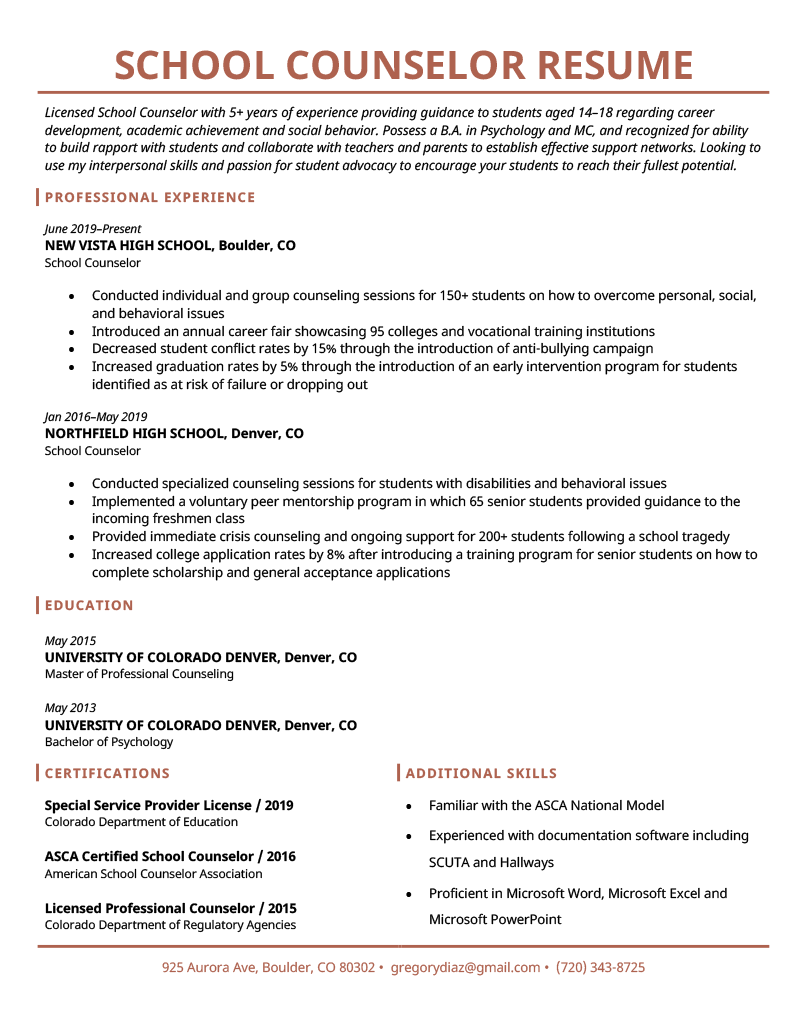
The Best School Counselor Resume:
Centers you as a student-centered advocate with proven results.
This counselor demonstrates a consistent commitment to student success, as evidenced by increased graduation rates, decreased conflict incidents, and successful college application outcomes.
Emphasizes a Data-Driven Approach to School Counseling
They also leverage data to identify and address student needs, implementing targeted interventions such as early warning systems and peer mentorship programs that yield measurable improvements.
Highlights Multifaceted Expertise in Counseling and Crisis Management
The candidate offers a comprehensive skillset, providing individual and group counseling, crisis intervention, and career guidance, while fostering collaboration with parents and teachers for holistic student support.
All Education Support Resume Examples
- School Counselor Resume
- Paraprofessional Resume
- Librarian Resume
- Tutor Resume
- Education resume
Engineering Resume Examples
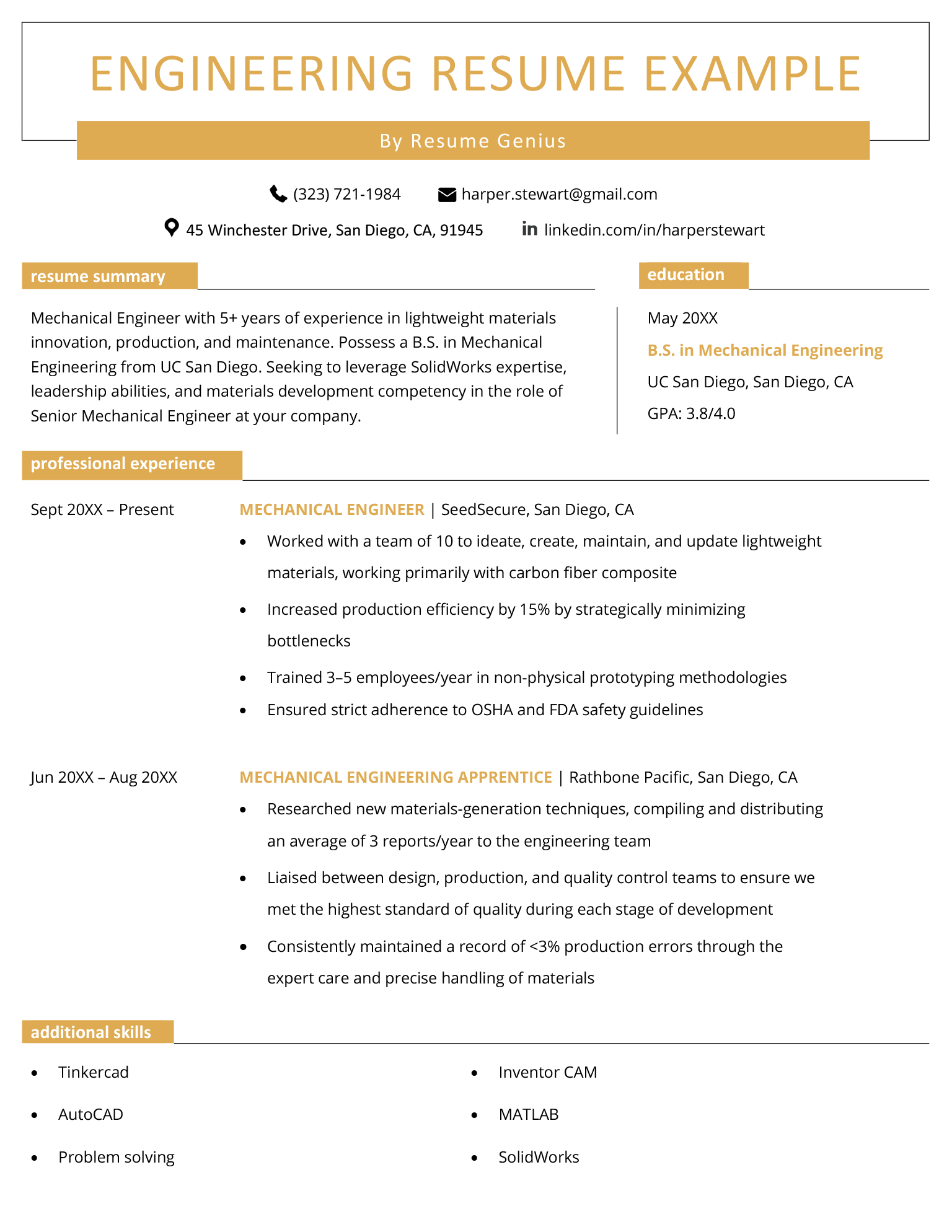
The Best Engineering Resume:
Quantifies achievements and impact.
Throughout their professional experience section, the candidate provides specific, quantifiable achievements, such as increasing production efficiency by 15% and consistently maintaining a record of <3% production errors. These metrics demonstrate their ability to drive measurable improvements and deliver results.
Includes Relevant Technical Skills
The additional skills section lists proficiency in essential tools and software for mechanical engineers, such as AutoCAD, MATLAB, and SolidWorks. This comprehensive skill set underscores the candidate’s ability to use technology to solve complex engineering problems.
Emphasizes Safety and Compliance
The applicant highlights their strict adherence to OSHA and FDA safety guidelines, demonstrating their commitment to maintaining a safe work environment and complying with industry regulations. This attention to detail and focus on safety is crucial for any mechanical engineer working in manufacturing or production settings.
All Engineering Resume Examples
- Engineering Resume
- Civil Engineer Resume
- Mechanical Engineer Resume
- Electrical Engineer Resume
- Industrial Engineer Resume
- Chemical Engineer Resume
Fitness & Nutrition Resume Examples
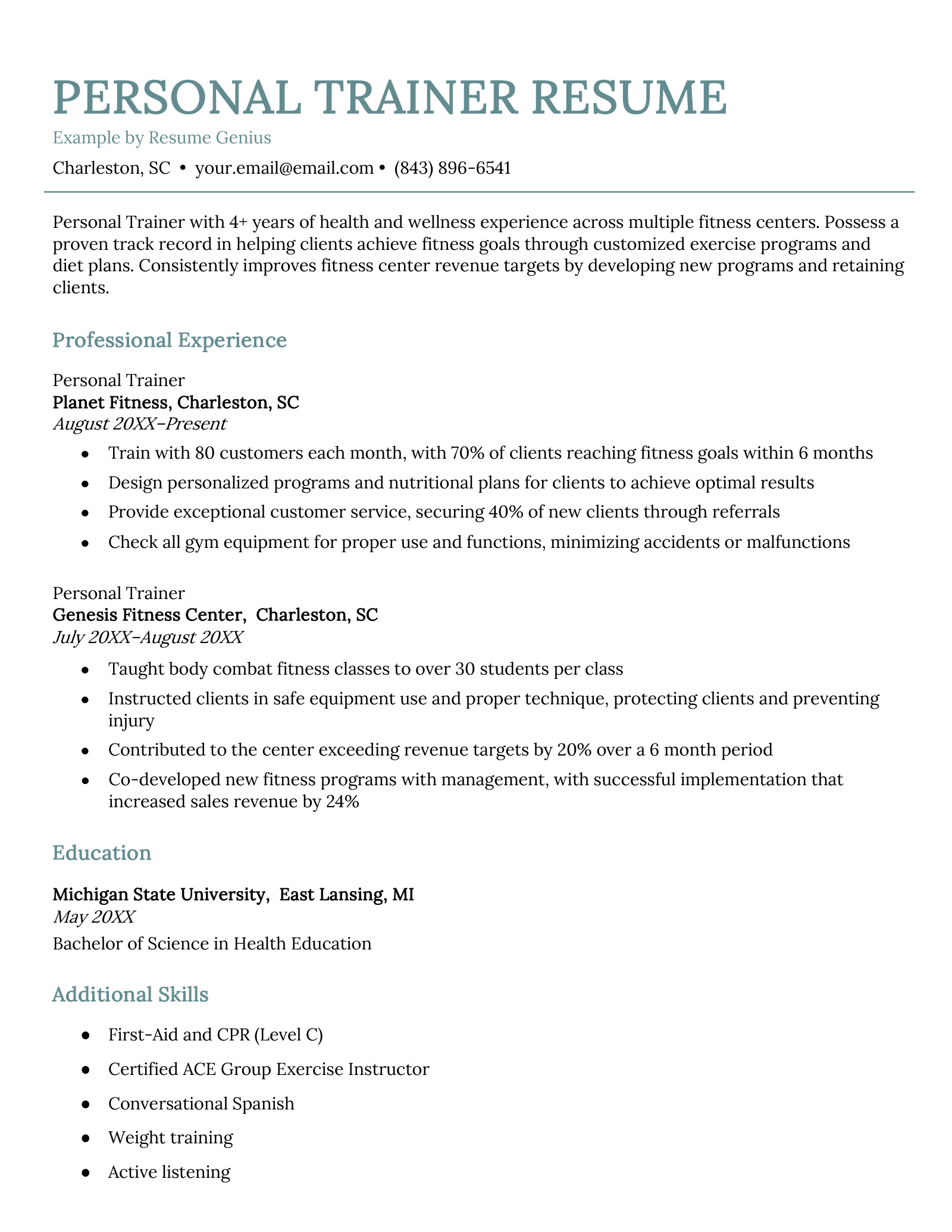
The Best Personal Trainer Resume:
Leads with successful outcomes.
This applicant has an impressive track record of helping clients reach their goals, proving their ability to create and implement personalized programs that yield significant results.
Demonstrates Creativity
The inventiveness demonstrated by this personal trainer when it comes to program development not only boosts the facility’s financial performance but also enriches the client experience by keeping the offerings fresh and engaging.
Cites High Client Engagement
For many health and wellness professionals, being able to engage and motivate groups of all sizes is the key to success. This resume tells employers this applicant can do just that.
All Fitness & Nutrition Resume Examples
- Personal Trainer Resume
- Health Coach Resume
- Dietitian Resume
Food Service Resume Examples
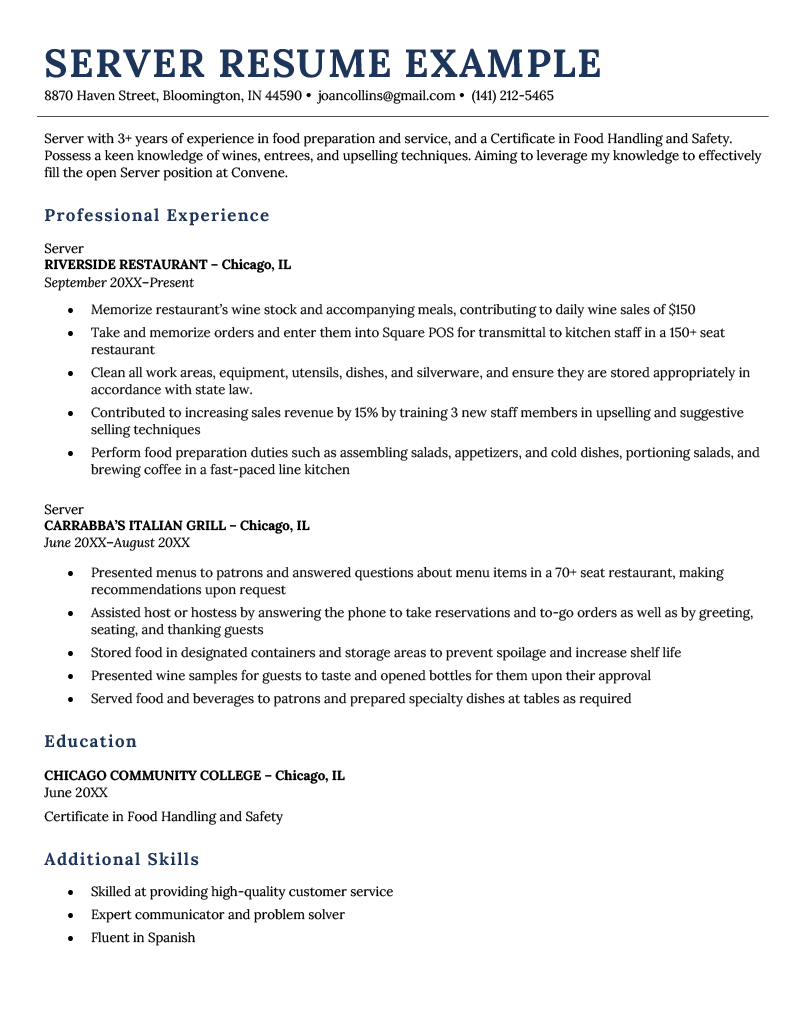
The Best Server Resume:
Leads with relevant food industry experience.
The applicant explains how they leveraged their knowledge of the restaurant’s wine selections and meal pairings to boost daily wine sales, showcasing their menu knowledge and understanding of food and beverage pairings.
Highlights Language Skills
Foreign language skills are an asset in the F&B industry, as multilingual servers are better able to provide a personalized customer service experience to guests from different backgrounds.
Clearly Shows Relevant Certifications
This resume example includes a certification in Food Handling and Safety to let employers know this server can be trusted to provide a safe, pleasant dining experience.
All Food Service Resume Examples
- Baker Resume
- Barista Resume
- Bartender Resume
- Catering Resume
- Fast Food Resume
- Server Resume
Government Resume Examples

The Best Federal Resume:
Demonstrates familiarity with government processes.
The resume showcases the candidate’s understanding of government job classifications, security clearances, and federal hiring practices. This knowledge can be a significant advantage when applying for a government position, as it suggests the candidate can navigate the unique aspects of public sector employment.
Is Tailored to the Specific Job Opening
This resume demonstrates a strategic approach by aligning the candidate’s experience and objectives with a particular job posting. By referencing the USAJOBS listing and highlighting relevant skills, the candidate shows an understanding of the position’s requirements.
Balances Technical and Interpersonal Skills
While highlighting technical skills like updating training curricula, the candidate also emphasizes interpersonal abilities such as mediation and handling sensitive employee complaints. This balance presents the candidate as someone who can manage both the procedural and human aspects of the job.
All Government Resume Examples
- Federal Resume
- Politician Resume
- Public Health Resume
- Military to Civilian Resume
Healthcare Support Resume Examples
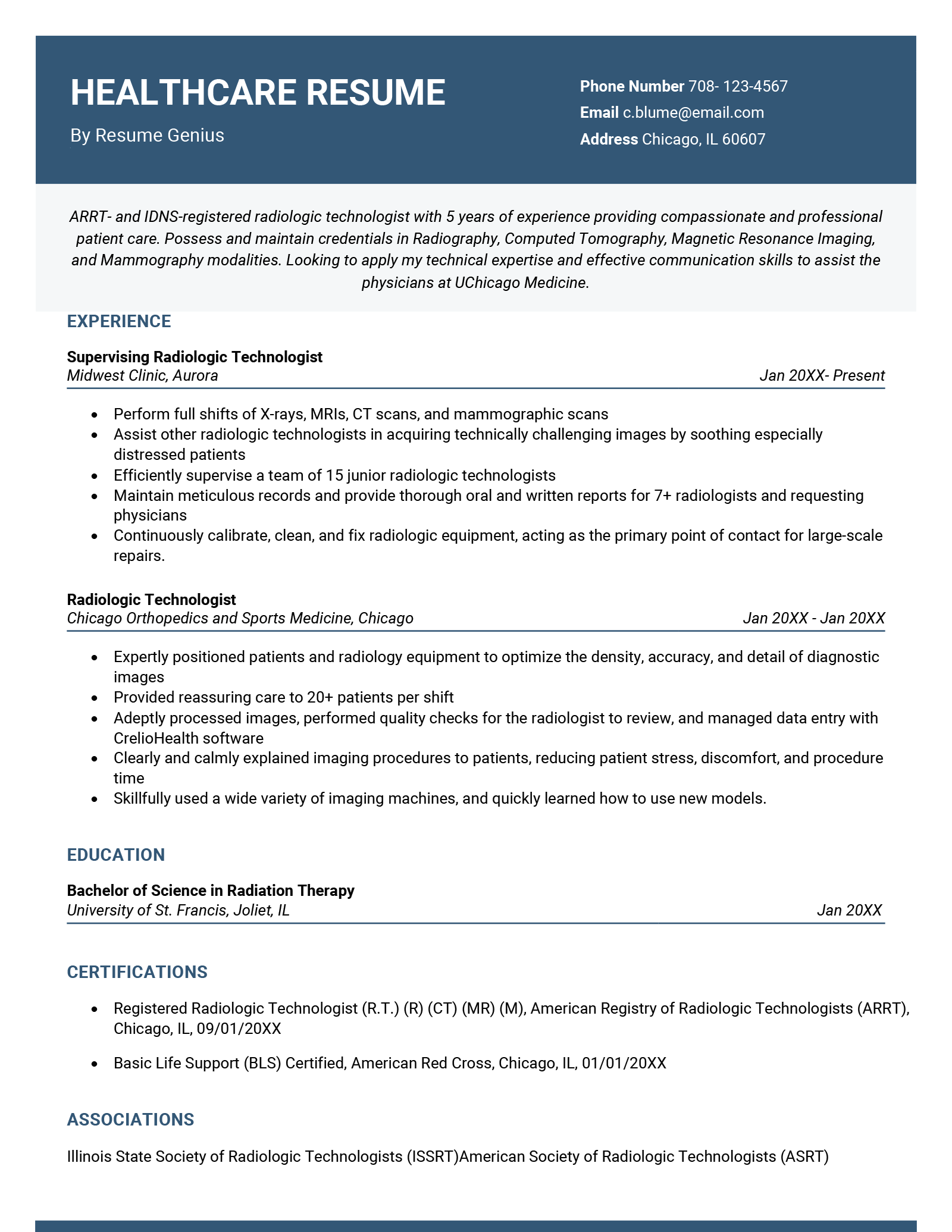
The Best Healthcare Resume:
Lists specific technical skills.
This resume includes hard skills that are essential for the type of medicine they practice. For example, they list experience with X-rays, MRIs, CT scans, and mammography, showcasing a broad technical skill set in radiologic technology.
Clearly Highlights Certifications
You need to be certified to practice medicine professionally. This candidate lists certifications in Radiography, Computed Tomography, Magnetic Resonance Imaging, and Mammography, indicating a highly qualified professional in diverse radiologic procedures.
Demonstrates Communication and Patient Care Skills
Soft skills like communication and empathy are incredibly important to successfully caring for patients. This candidate demonstrates these abilities with specific examples throughout their resume.
All Healthcare Support Resume Examples
- Healthcare Resume
- Medical Assistant Resume
- Speech-Language Pathologist Resume
- Healthcare Administration Resume
- Dental Assistant Resume
- Phlebotomist Resume
- Home Health Aide Resume
Information Technology (IT) Resume Examples
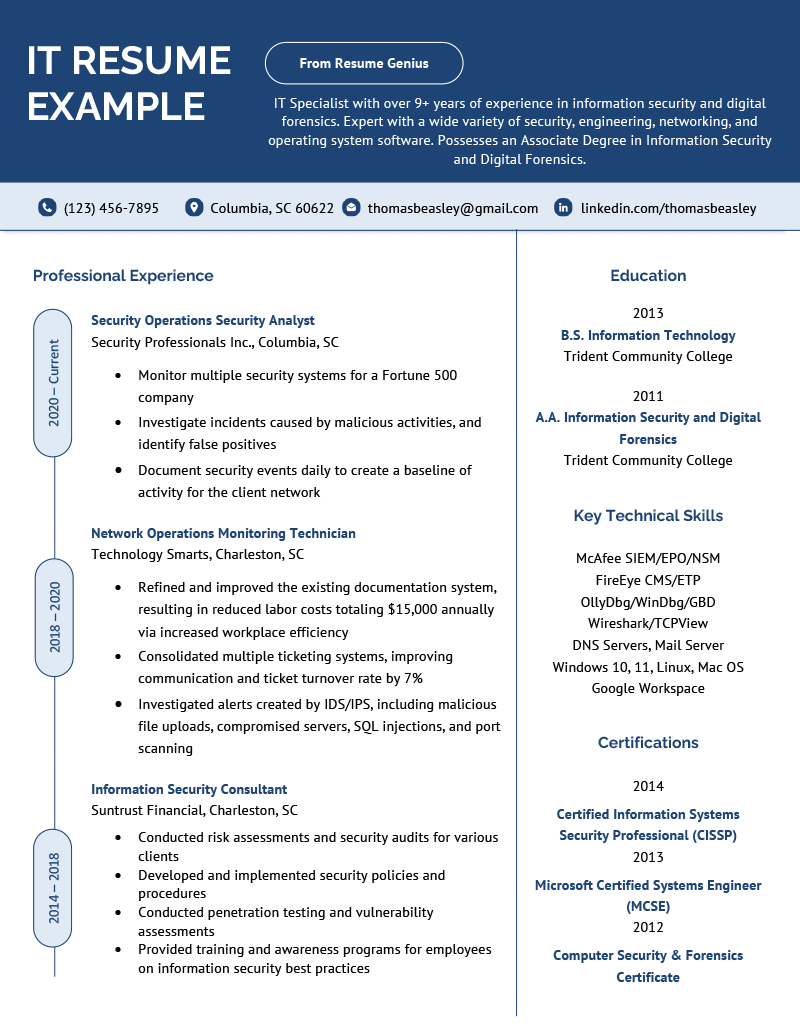
The Best IT Resume:
Starts with a strong summary statement.
The resume begins with a compelling summary that effectively encapsulates the candidate’s expertise, experience, and key strengths. By highlighting their proficiency in a wide variety of security, engineering, networking, and operating system software, the summary immediately captures the reader’s attention.
Demonstrates Strong Analytical and Problem-Solving Skills
This IT professional conducted thorough risk assessments and developed and implemented security policies and procedures, as well as conducted penetration testing and vulnerability assessments. These initiatives highlight their analytical mindset and problem-solving capabilities in identifying potential vulnerabilities and recommending effective solutions to mitigate risks.
Showcases Commitment to Continuous Learning and Professional Development
Throughout their education and certifications section, this candidate demonstrates a strong dedication to staying updated with the latest trends and best practices in the field of information security.
All IT Resume Examples
- QA Tester Resume
- Technical Resume
Law Resume Examples
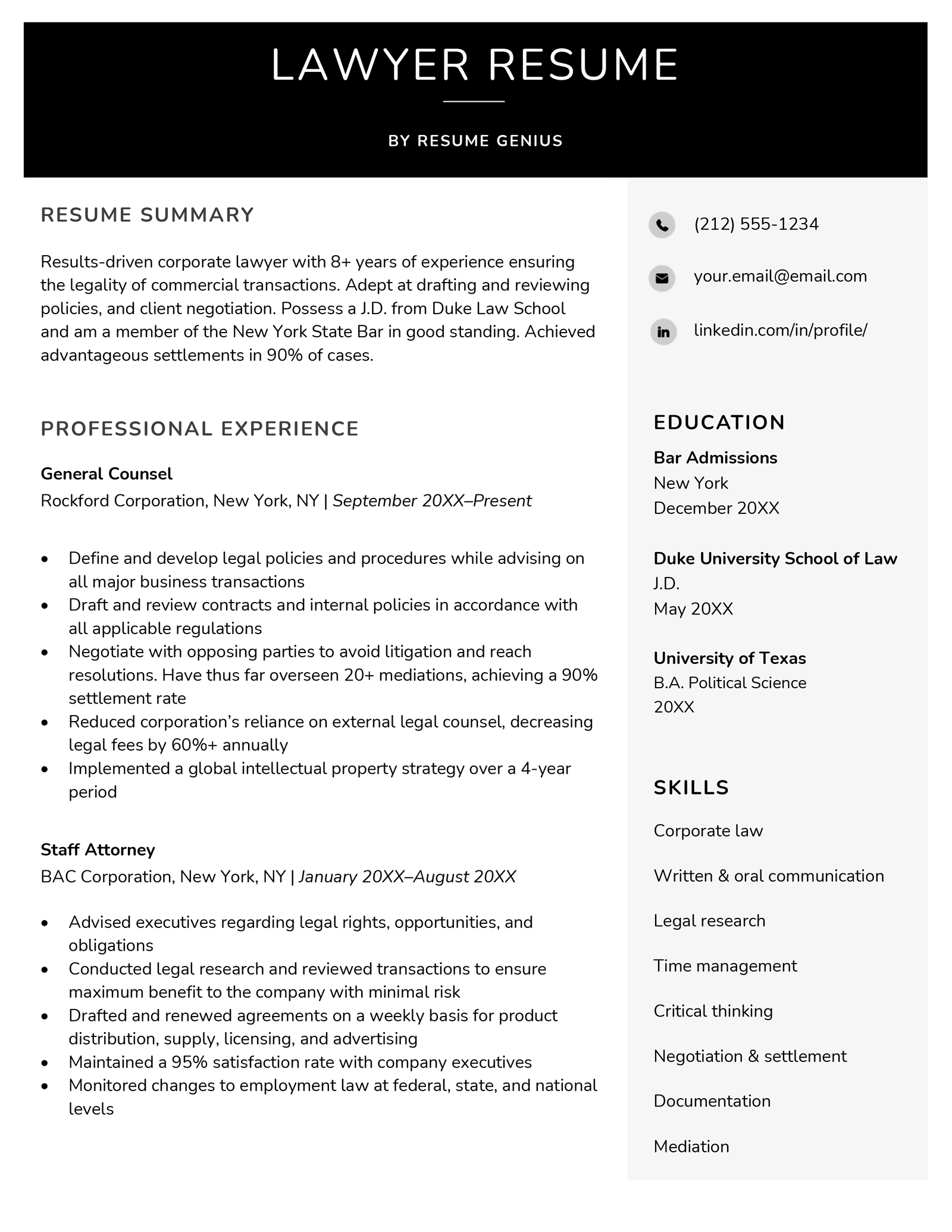
The Best Lawyer Resume:
Highlights strong written and oral communication skills.
The candidate’s descriptions of their job responsibilities demonstrate their exceptional written and oral communication skills and their ability to convey complex legal concepts to both legal and non-legal professionals.
Showcases Expertise in Legal Research and Analysis
This lawyer’s experience conducting legal research and reviewing transactions demonstrates their strong analytical skills and attention to detail, which are essential for success in the legal field.
Demonstrates Effective Time Management Skills
Throughout their professional experience section, this lawyer has showcased how they can juggle multiple responsibilities and prioritize tasks effectively, demonstrating strong time management skills and the ability to work well under pressure.
All Law Resume Examples
- Lawyer Resume
- Legal Assistant Resume
- Paralegal Resume
- Law Clerk Resume
- Law School Resume
Life Situation Resume Examples
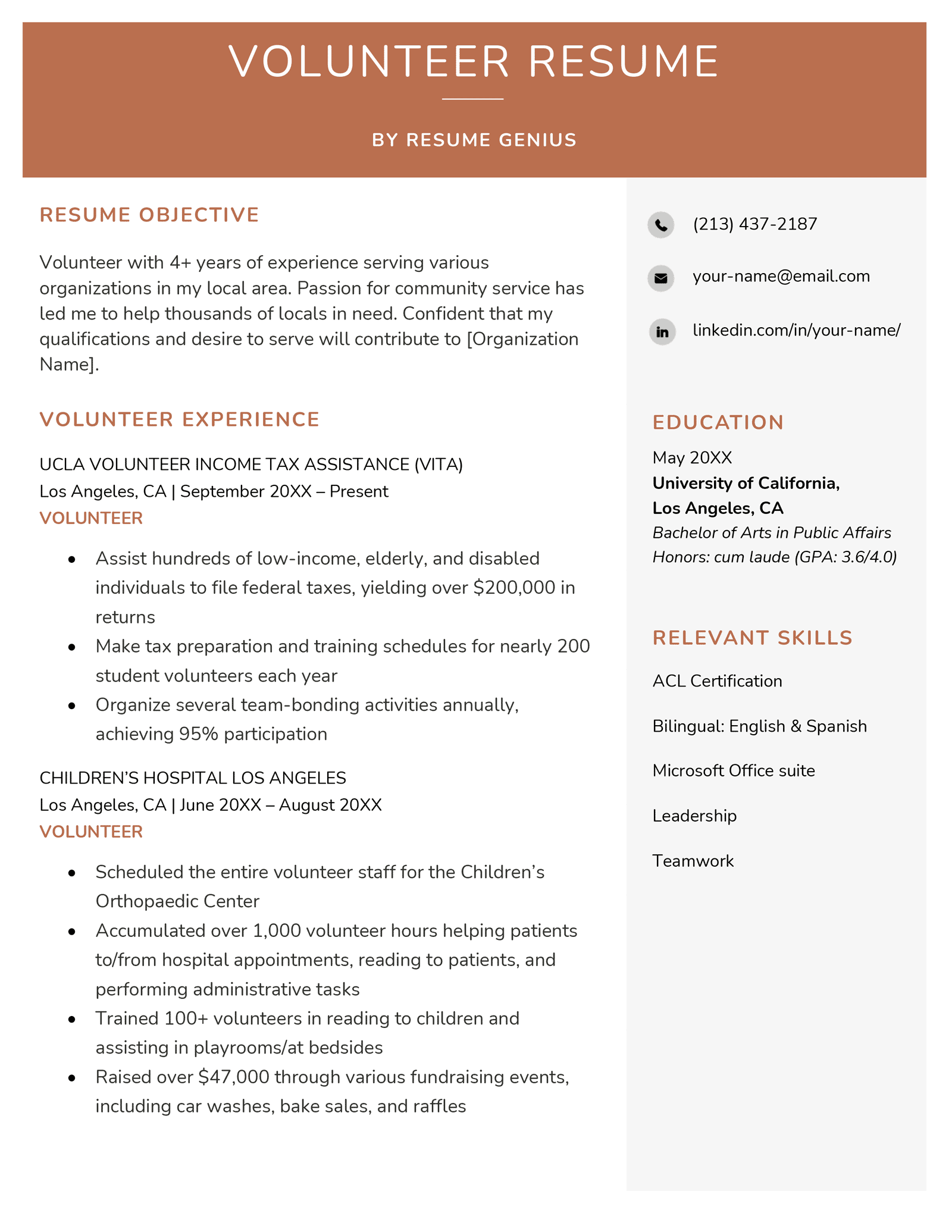
The Best Volunteer Resume:
Leads with examples of impactful volunteer work.
This candidate clearly outlines their contributions to community service, demonstrating that they’re already committed to volunteering.
Demonstrates Effective Coordination Skills
Organization and coordination are essential skills for volunteer work. This resume highlights numerous examples of these skills in action throughout the experience section.
Includes Language Proficiency
Volunteer work often involves communicating with people in other languages. This candidate uses their resume to highlight their Spanish fluency, making them a valuable asset to organizations.
All Life Situation Resume Examples
- Boyfriend Resume
- Google Resume
- Mid-Career Resume
- Resume for Beginners
- Stay at Home Mom Resume
- Volunteer Resume
- Work from Home Resume
Management Resume Examples
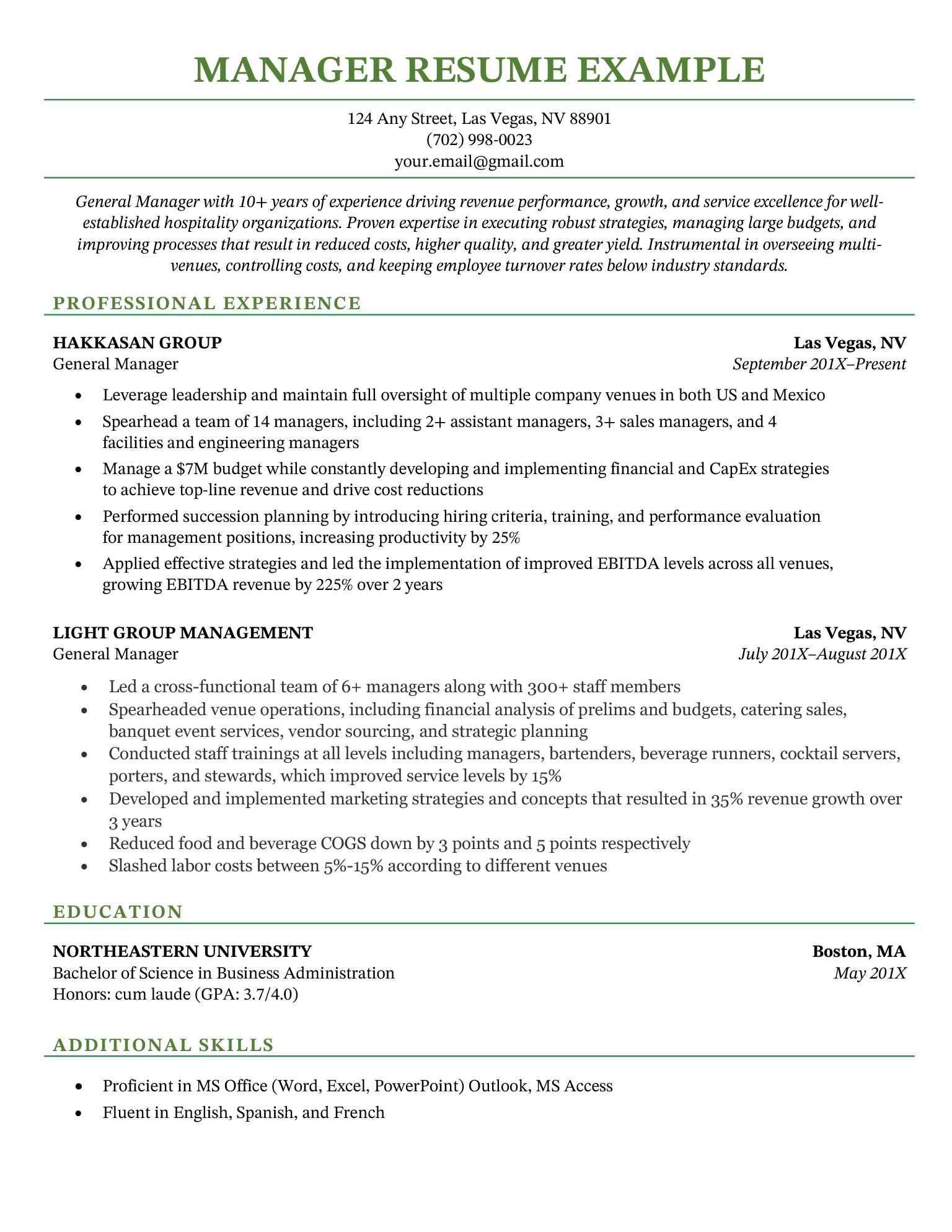
The Best Manager Resume:
Highlights a proven track record of driving substantial revenue growth.
This manager demonstrates their ability to boost financial performance, with a standout achievement of growing EBITDA revenue by 225% over two years. This result underscores the candidate’s expertise in significantly impacting the bottom line.
Shows Strategic Leadership and Team Management Skills
With experience overseeing large, diverse teams across multiple venues and countries, this general manager showcases strong leadership skills. Specifically, their resume highlights the successful management of 14 junior managers and 300+ staff members.
Demonstrates Versatility in Cost Control and Operational Efficiency
The candidate’s resume reflects a comprehensive approach to business management. Notable achievements include slashing labor costs by up to 15%, showcasing an ability to optimize operations without compromising service quality or employee retention.
All Manager Resume Examples
- Scrum Master
- General Manager Resume
- Supervisor Resume
- Property Manager Resume
Medical Resume Examples
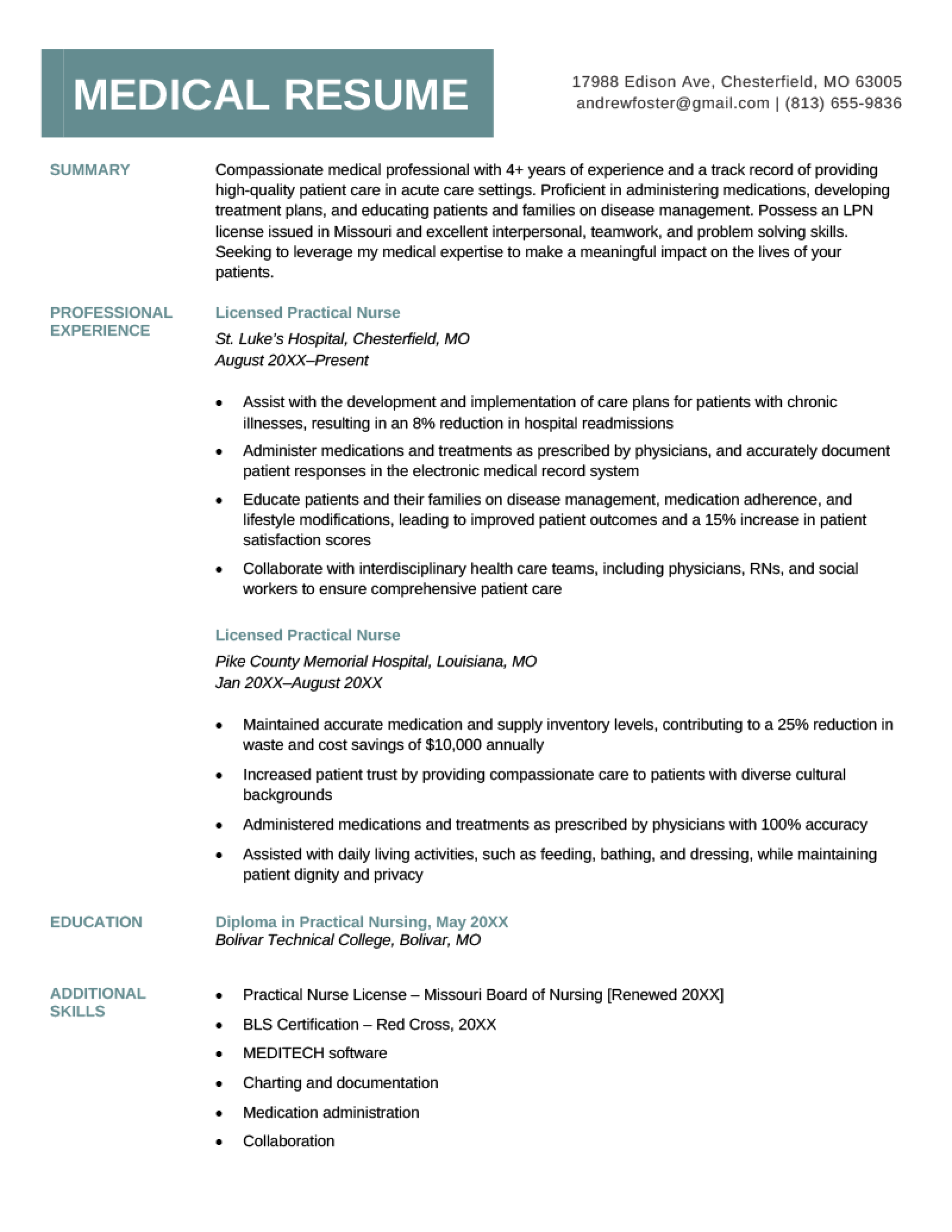
The Best Medical Resume:
Emphasizes patient-centered care and education.
Throughout the resume, there’s a strong emphasis on holistic patient care that goes beyond just medical treatment. The candidate highlights their role in educating patients and families about disease management and lifestyle modifications, showcasing a commitment to empowering patients and improving long-term health outcomes.
Highlights Strong Interprofessional Collaboration Skills
By explicitly mentioning collaboration with a range of healthcare professionals including physicians, RNs, and social workers, the resume underscores the candidate’s ability to work effectively in team-based care models.
Showcases Cultural Competence and Diversity Awareness
The resume tactfully addresses the important issue of cultural competence in healthcare. By mentioning experience in providing compassionate care to patients from diverse cultural backgrounds, the candidate signals their ability to navigate and respect cultural differences, a crucial skill when working in healthcare.
All Medical Resume Examples
- Medical Resume
- Pharmacist Resume
- Surgical Tech Resume
- Lab Technician Resume
- Dentist Resume
- Optician Resume

Nursing Resume Examples
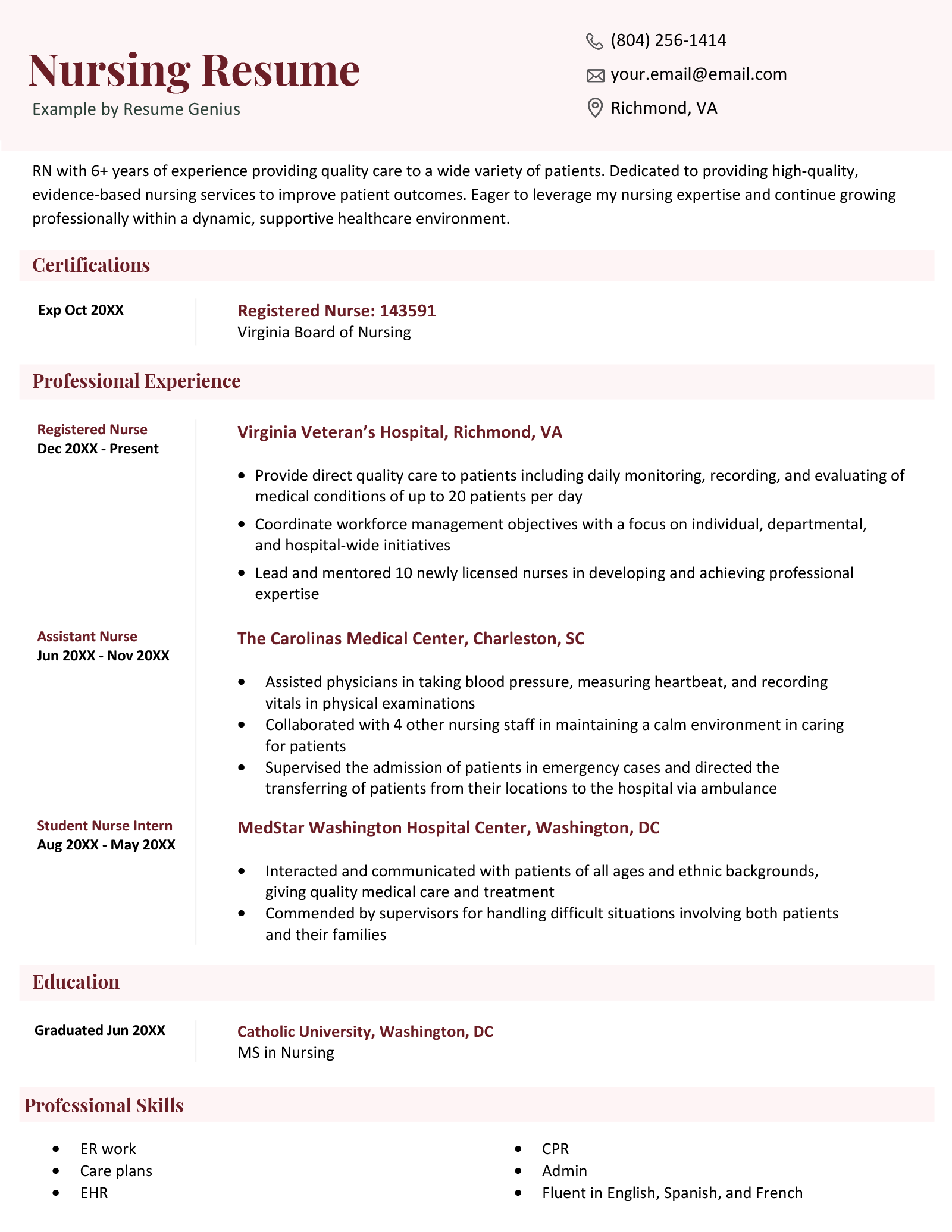
The Best Nursing Resume:
Mentions of working alongside physicians and coordinating with other nursing staff emphasize the candidate’s ability to work effectively with other healthcare professionals. This collaborative approach is crucial in modern healthcare delivery and suggests the candidate can contribute positively to interdisciplinary care teams.
Emphasizes a Patient-Centric Approach to Healthcare
Throughout the document, there’s a consistent thread of dedication to high-quality, patient-focused care. The emphasis on evidence-based practice and improving patient outcomes reflects a conscientious approach to nursing that aligns with current healthcare priorities.
Demonstrates Cultural Awareness and Sensitivity
The resume notes experience interacting with patients from various age groups and backgrounds, indicating cultural sensitivity and adaptability. This shows the candidate’s ability to provide inclusive, respectful care to all patients.
All Nursing Resume Examples
- Nursing Resume
- ICU Registered Nurse Resume
- Pediatric Nurse Resume
- Labor and Delivery Nurse
- Orthopedic Nurse Resume
- Operating Room Nurse Resume
Production & Assembly Resume Examples
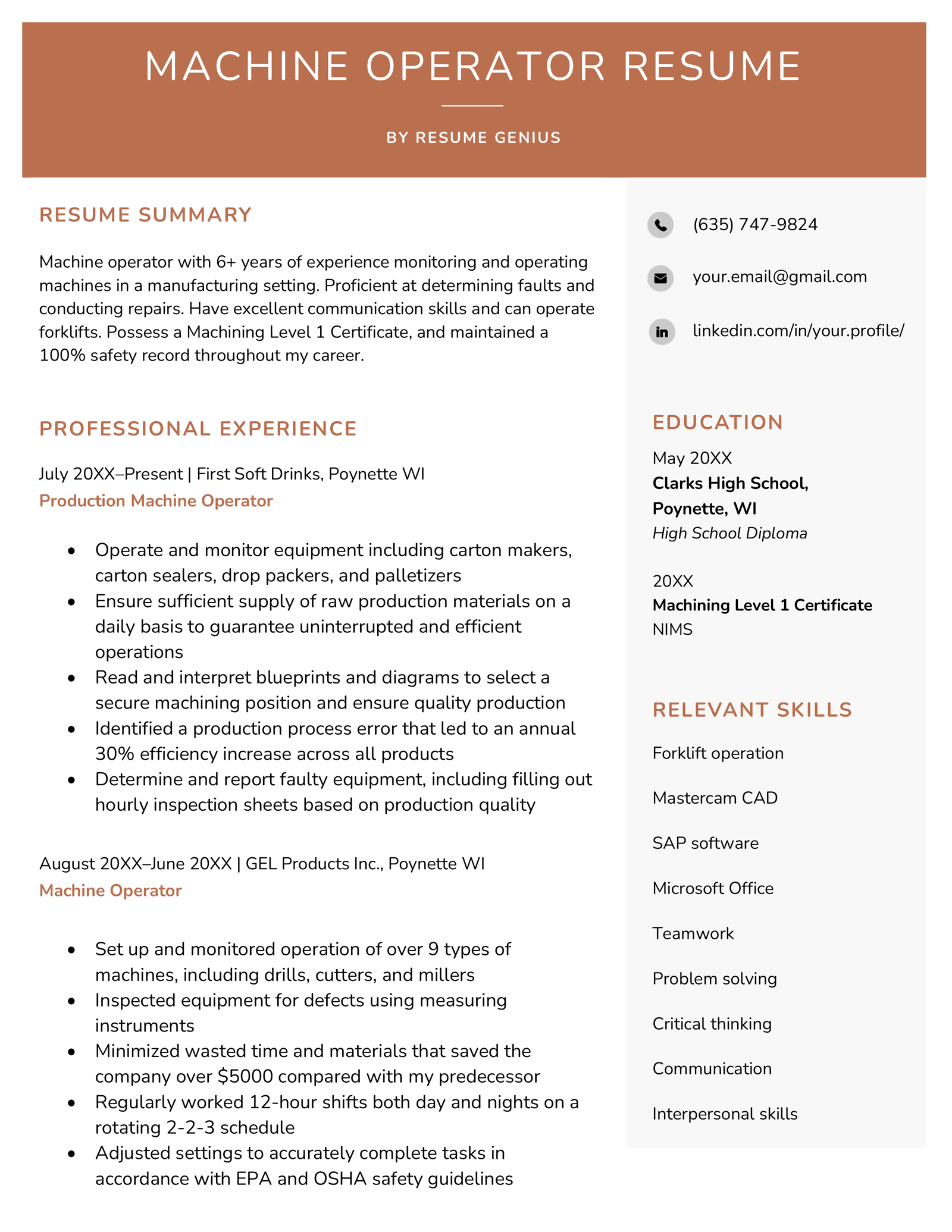
The Best Machine Operator Resume:
Showcases technical proficiency.
The resume effectively lists specific machinery and software the candidate is proficient with, including carton makers, palletizers, and SAP software. This detailed technical knowledge demonstrates the candidate’s readiness to hit the ground running in a new role.
The resume effectively uses numerical data to showcase the candidate’s impact, such as improving efficiency by 30%. This quantification helps potential employers understand the concrete value the candidate can bring to their organization.
This candidate highlights their commitment to safety protocols and regulatory compliance, which is crucial in manufacturing environments.
All Production & Assembly Resume Examples
- Assembler Resume
- Machine Operator Resume
- Mechanic Resume
- Laborer Resume
- Process Engineer Resume
- Quality Assurance Resume
- Quality Engineer Resume
Public Safety Resume Examples
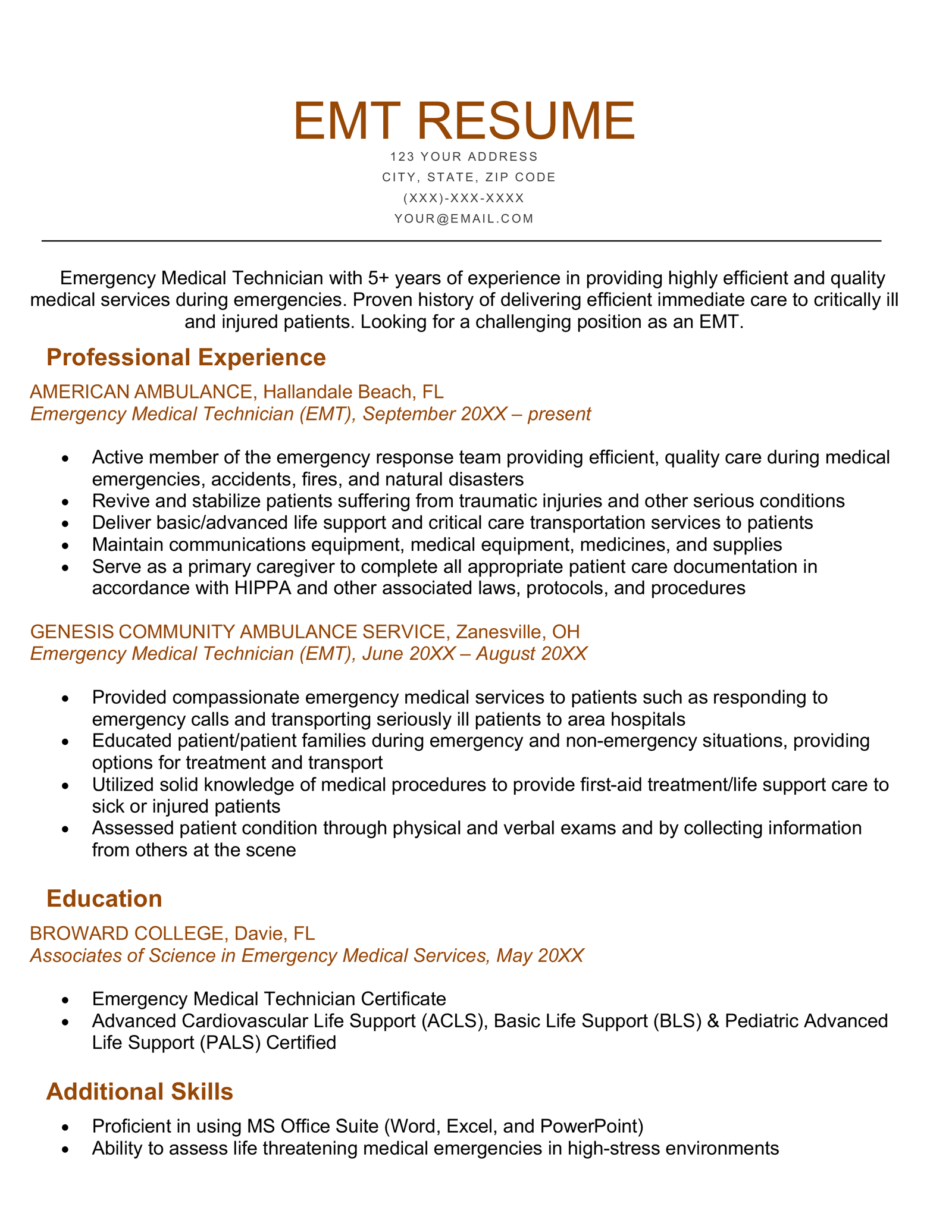
The Best EMT Resume
Emphasizes versatility.
This resume effectively showcases the candidate’s broad experience in handling various emergency situations. By mentioning their involvement in medical emergencies, accidents, fires, and natural disasters, the resume paints a picture of a versatile EMT capable of adapting to different high-pressure scenarios.
Highlights a Patient-Centric Approach
Throughout the resume, there’s a consistent emphasis on patient care and compassion. This focus on patient care and communication skills sets the candidate apart as someone who can handle both the technical and interpersonal aspects of the job effectively.
Demonstrates Compliance and Procedural Knowledge
The candidate references important healthcare regulations and protocols, such as HIPAA compliance and proper documentation procedures. This attention to legal and procedural details indicates that the candidate understands the importance of following established guidelines.
All Public Safety Resume Examples
- Police Officer Resume
- Firefighter Resume
- Lifeguard Resume
Restaurant & Hospitality Resume Examples
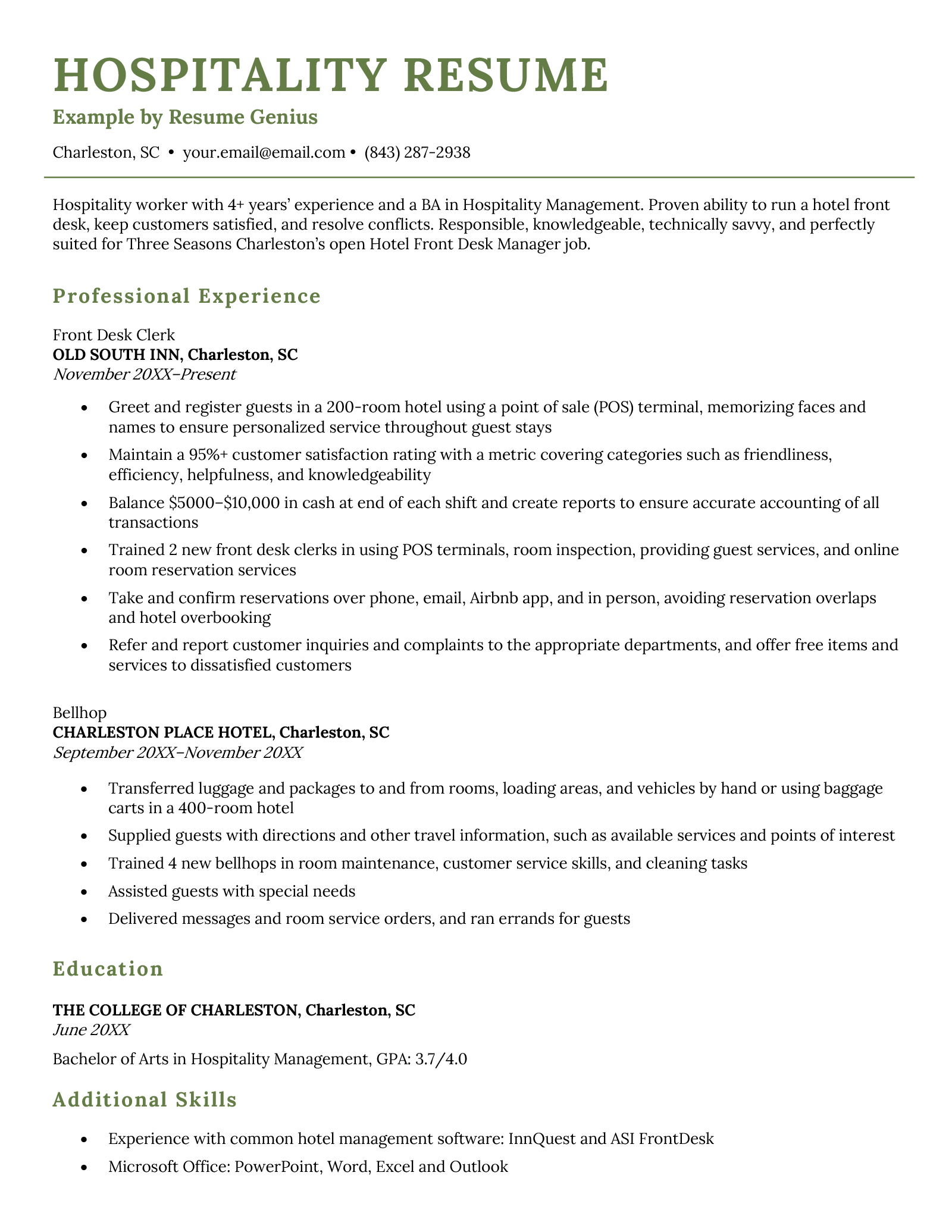
The Best Hospitality Resume:
Highlights adaptability.
By detailing responsibilities in both bellhop and front desk roles, the candidate demonstrates a comprehensive understanding of hotel operations from multiple angles. This progression highlights the candidate’s adaptability and readiness for increased responsibility, making them an attractive prospect for management roles.
Emphasizes a Customer-Centric Approach
Throughout the resume, there’s a strong focus on guest satisfaction and personalized service. The candidate’s ability to maintain high customer satisfaction ratings and their attention to individual guest needs are prominently featured.
Includes both Hard and Soft Skills
While the resume emphasizes technical skills and specific job responsibilities, it also cleverly incorporates mentions of soft skills crucial in hospitality, such as problem-solving, communication, and attention to detail. The ability to handle cash accurately, resolve customer complaints, and provide personalized service all point to a well-rounded skill set.
All Restaurant & Hospitality Resume Examples
- Restaurant Resume
- Hospitality (Hotel) Resume
- Housekeeping Resume
- Front Desk Resume
- Concierge Resume
- Hotel General Manager Resume
Retail Resume Examples
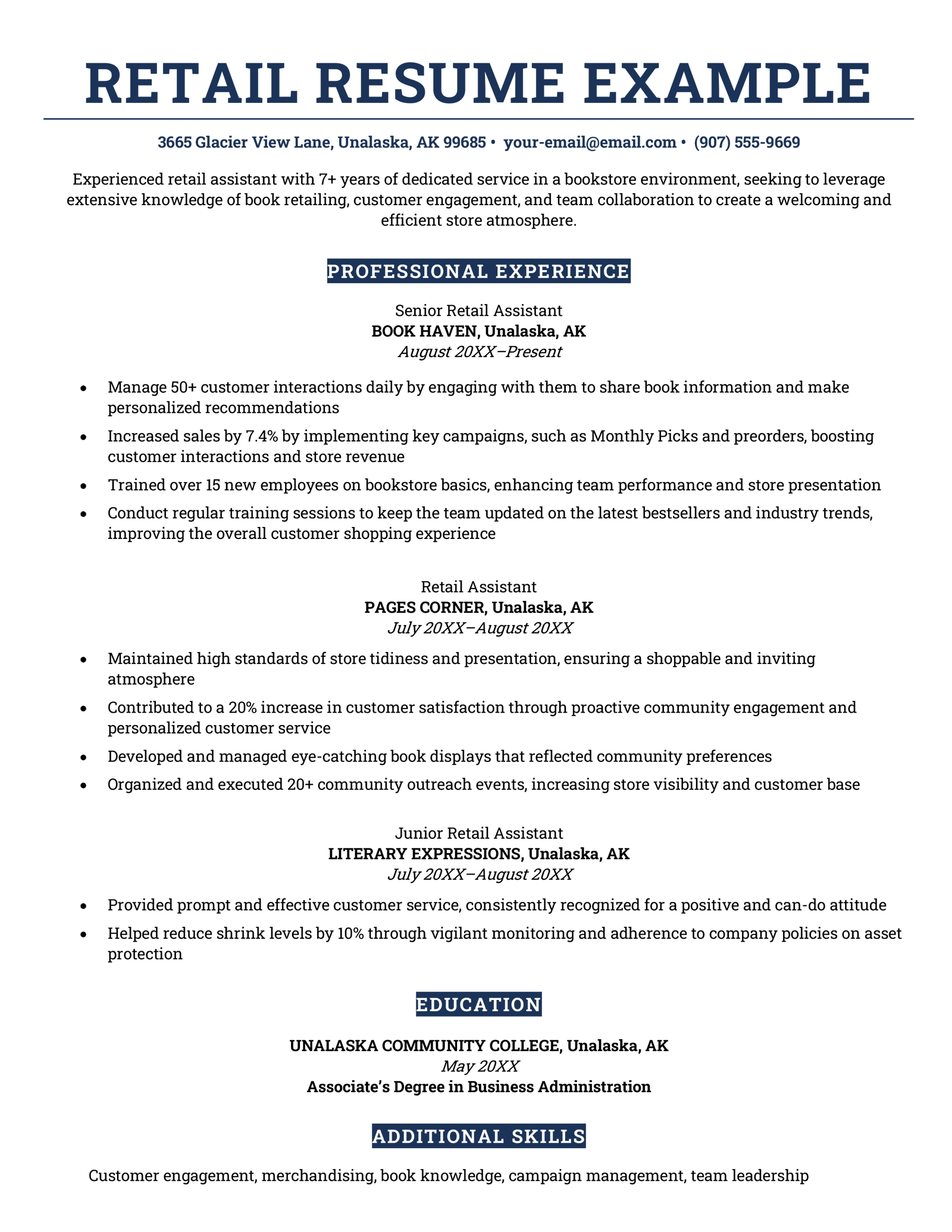
The Best Retail Resume
Throughout the resume, there’s a consistent focus on enhancing the customer experience, from personalized recommendations to community engagement. This customer-first mentality is crucial in retail and shows the candidate’s understanding of employer’s priorities.
Quantifies Achievements with Concrete Metrics
By providing specific percentages for sales increases and customer satisfaction improvements, the resume offers tangible evidence of the candidate’s impact. This data-driven approach gives potential employers a clear picture of the value the candidate can bring to their organization.
Balances Hard and Soft Skills
While emphasizing interpersonal skills like customer engagement, the resume also highlights technical abilities such as merchandising and campaign management, presenting a well-rounded skill set.
All Retail Resume Examples
- Retail Resume
- Retail Sales Associate Resume
- Cashier Resume
- Retail Manager Resume
- Store Manager Resume
Sales & Marketing Resume Examples
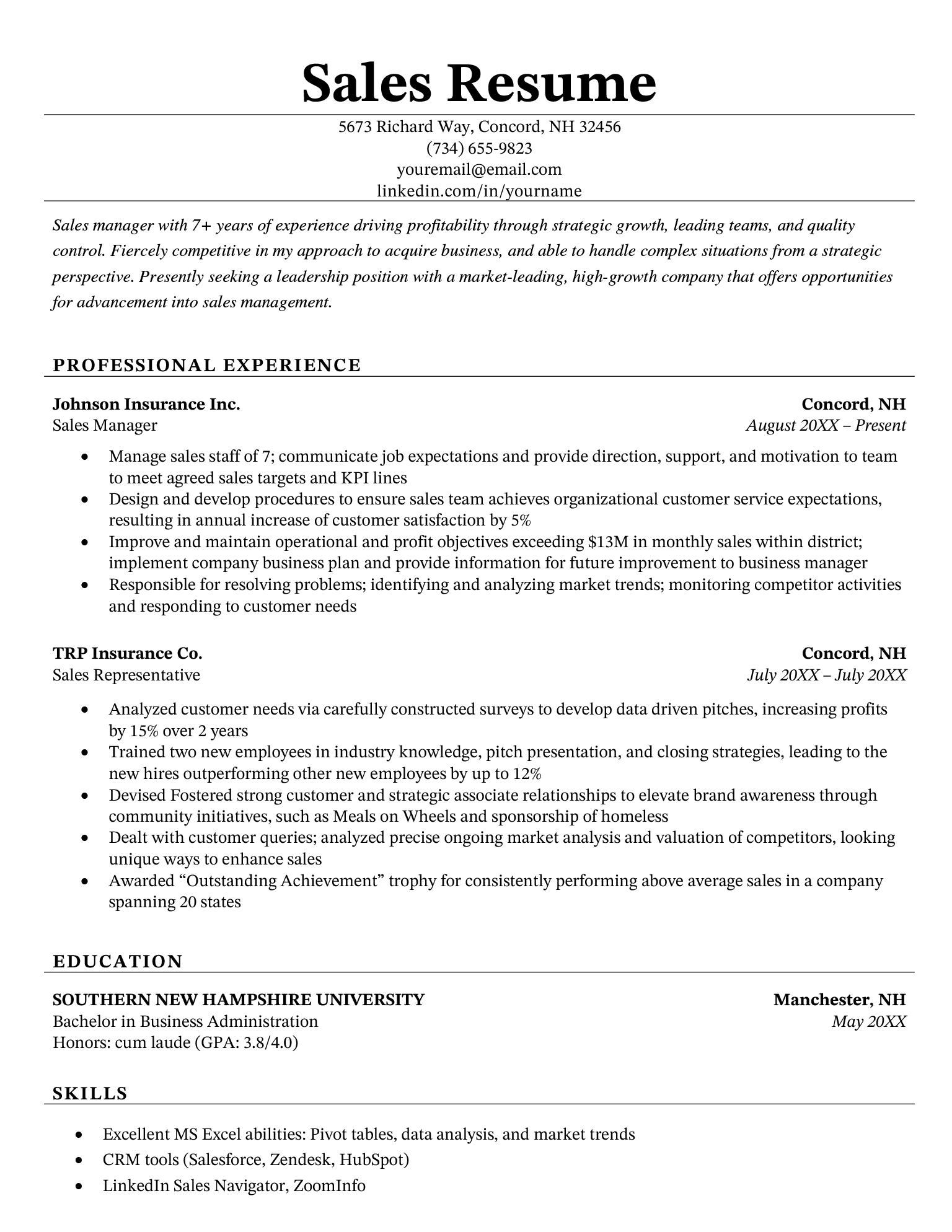
The Best Sales Resume:
Emphasizes data-driven decision making.
There’s a strong focus on utilizing data and analytics to drive sales strategies and improve performance. This analytical approach demonstrates the candidate’s ability to make informed, strategic decisions in a competitive market.
Showcases Community Engagement and Brand Building
The mention of community initiatives demonstrates the candidate’s understanding of the importance of corporate social responsibility and brand awareness in modern sales strategies.
Demonstrates a Holistic Understanding of Sales Operations
From customer service to market analysis and competitive intelligence, the resume paints a picture of a well-rounded sales professional capable of managing various aspects of the sales cycle.
All Sales & Marketing Resume Examples
- Sales Resume
- Marketing Resume
- Business Development Resume
- Real Estate Agent Resume
- Ecommerce Resume
- Fundraising Resume
- Public Relations Resume
Social Service Resume Examples
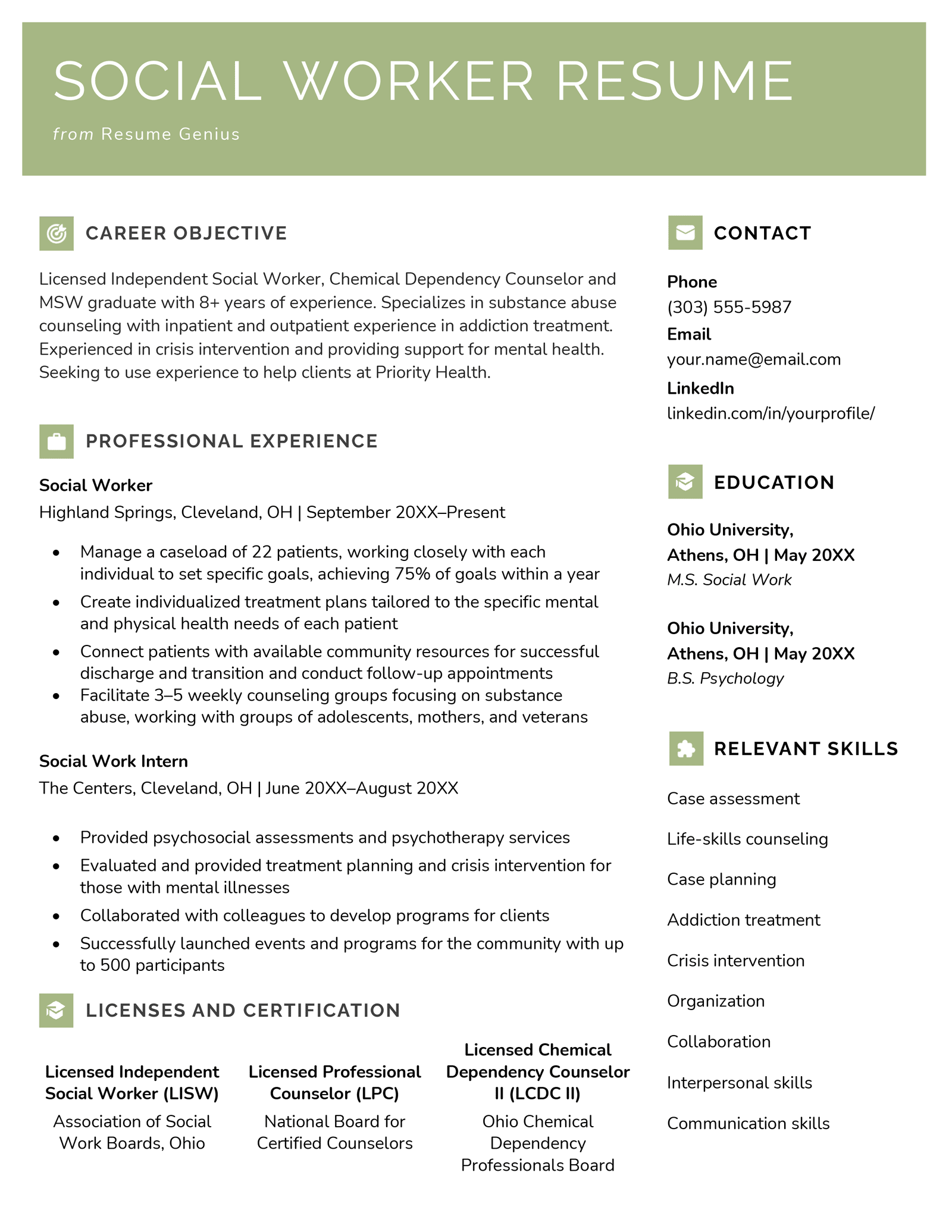
The Best Social Worker Resume:
Demonstrates specialized expertise.
The resume highlights the candidate’s focus on substance abuse counseling and mental health support, positioning them as a specialist in high-demand areas of social work. This targeted experience makes them a valuable asset for organizations dealing with these critical issues.
Showcases Versatility in Approaches
From individual counseling to group therapy and community resource coordination, the resume illustrates a well-rounded skill set that can adapt to various client needs and treatment settings.
Balances Clinical and Practical Skills
While emphasizing clinical abilities like psychosocial assessments and treatment planning, the resume also highlights practical skills such as case management and crisis intervention, presenting a well-rounded professional profile.
All Social Service Resume Examples
- Social Worker Resume
- Case Manager Resume
- Mental Health Counselor Resume
- Counselor Resume
- Custodian Resume
- Maintenance Worker Resume
- Coaching Resume
- Pastor Resume
Student Resume Examples
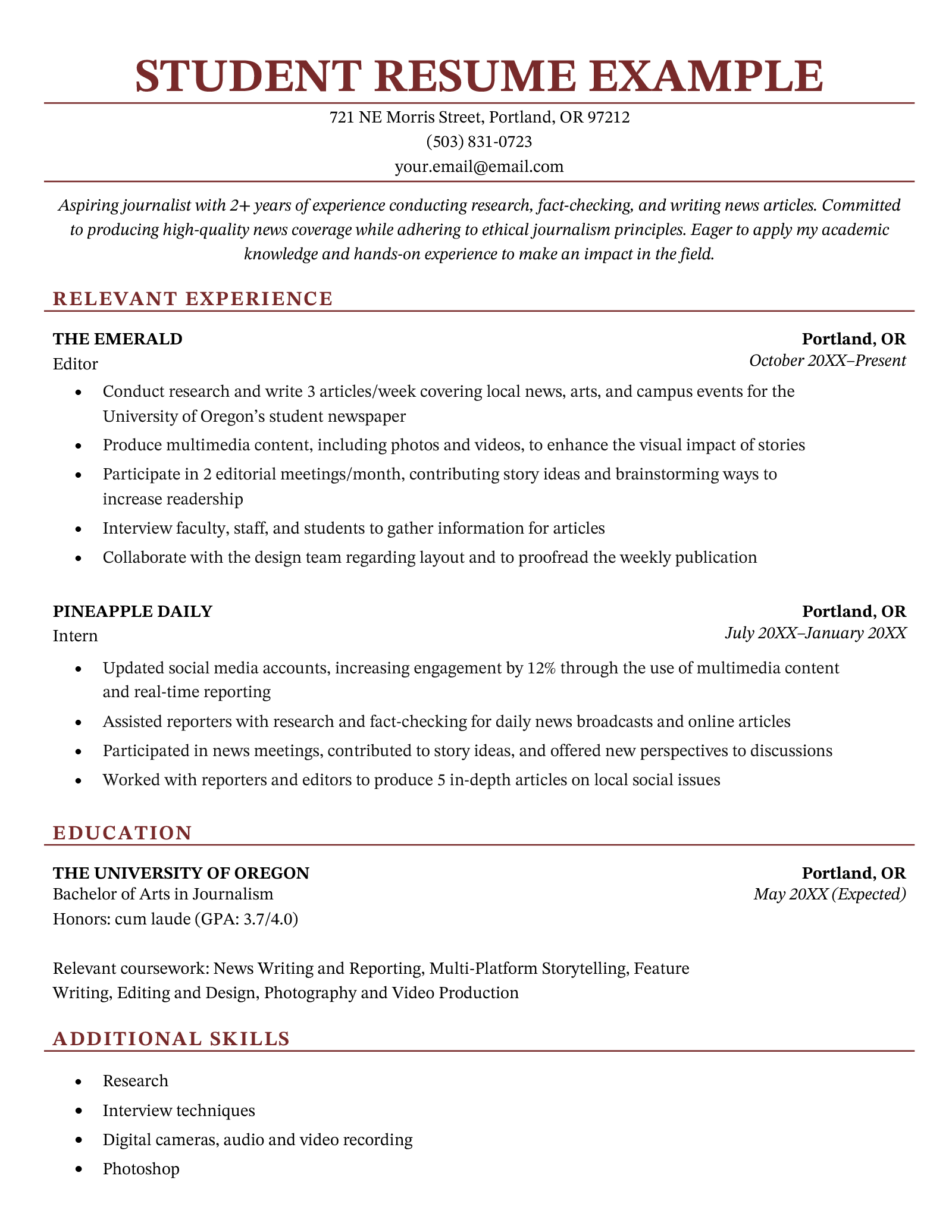
The Best Student Resume:
Demonstrates multimedia proficiency.
By including their experience with producing multimedia content alongside traditional journalism skills, this candidate shows employers they’re ready to work at a modern media company.
Includes an Impressive Academic Background
This student’s academic foundation shows they’re well-versed in both the theoretical and practical aspects of journalism, and equipped with the latest methodologies and technologies used in the field.
Highlights Editorial Experience
Experience like participating in editorial meetings and working with design teams indicates this applicant is ready to contribute to both content creation and the collaborative process needed for successful publication.
All Student Resume Examples
- Resume Examples for Teens
- High School Resume
- Internship Resume
- Student Resume
Teacher Resume Examples
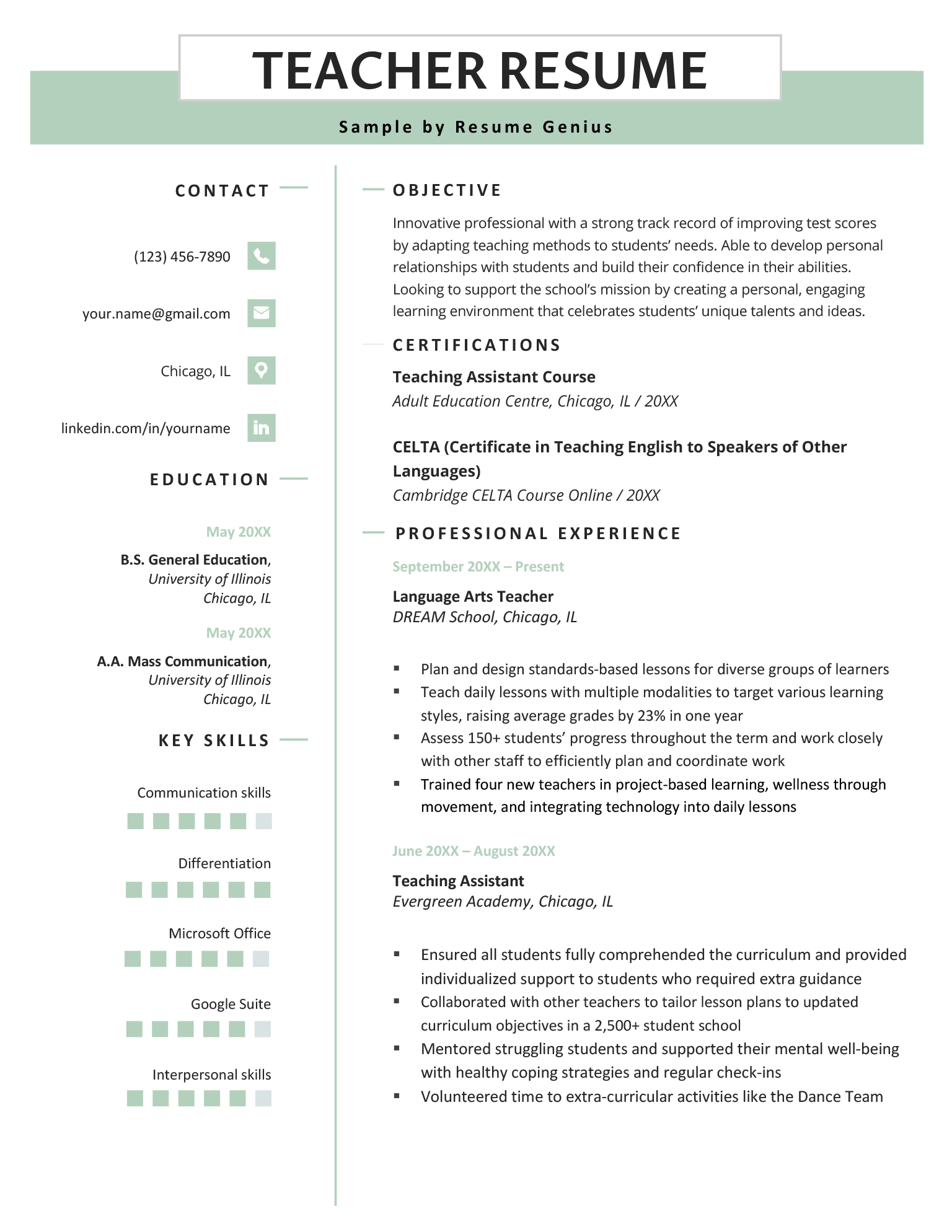
The Best Teacher Resume:
Demonstrates ability to improve student performance.
The resume showcases a track record of enhancing student outcomes, with a notable 23% increase in average grades over one year. This data-driven approach to education highlights the candidate’s ability to impact student success.
Emphasizes Innovative and Adaptive Teaching Methods
Throughout the resume, there’s a clear focus on tailoring the candidate’s teaching approaches to meet diverse student needs. From utilizing multiple modalities to incorporating technology, this teacher can create an engaging and effective learning environment.
Balances Curriculum Expertise with Holistic Student Support
While highlighting strong curriculum development skills, the resume also emphasizes the candidate’s dedication to students’ overall well-being. This is evident in their mentoring of struggling students and support for extracurricular activities.
All Teacher Resume Examples
- Teacher Resume
- Elementary Teacher Resume
- Preschool Teacher Resume
- Teacher Assistant Resume
- ESL Teacher Resume
- Special Education Teacher Resume
- Substitute Teacher Resume
- Art Teacher Resume
- Math Teacher Resume
Transportation & Logistics Resume Examples
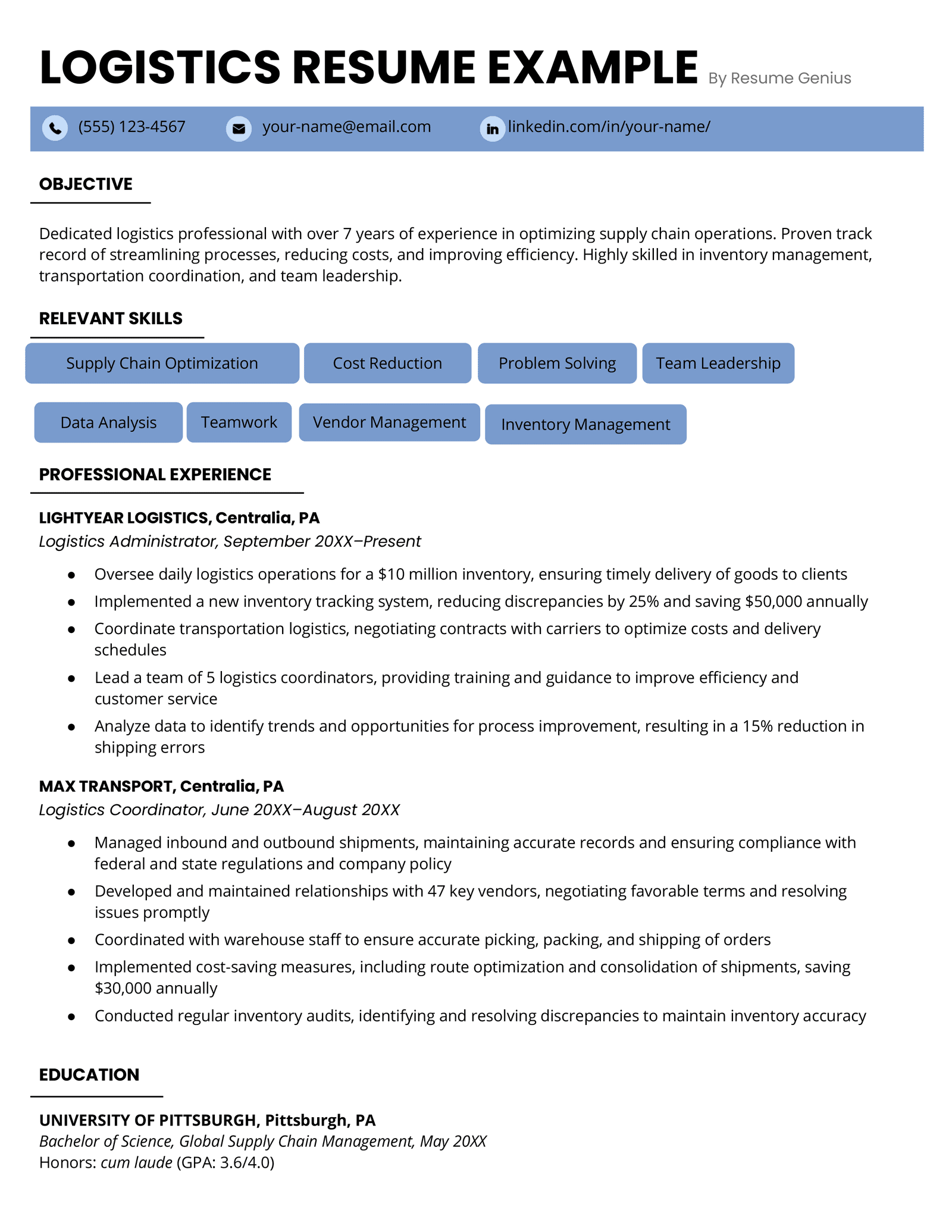
The Best Logistics Resume:
Broadcasts achievements & impact.
This resume example cites instances of the candidate’s ability to reduce costs and enhance operational efficiency for their employer, demonstrating a clear impact on the company’s bottom line.
Highlights Vendor Management Experience
It’s clear from this resume that the candidate excels in managing vendor relationships and negotiating contracts, both essential skills for optimizing costs and ensuring smooth operational flow in logistics.
Demonstrates Regulatory Compliance
The applicant’s role in ensuring compliance with federal and state regulations, as detailed in their work experience section, is a crucial aspect of logistics.
Related Transportation & Logistics Resume Examples
- Delivery Driver Resume
- Pilot Resume
- Warehouse Resume
- Logistics Resume
- Truck Driver Resume
- Driver Resume
- Flight Attendant Resume
After you’ve found a resume example on our website that matches your job and experience level, it’s time to start working on your own resume. Our career expert and Certified Professional Resume Writer (CPRW) Eva walks you through the process of using our examples, even highlighting how you can customize a resume example with your own information using Chat GPT .
After you’ve pulled ideas from our professional resume examples and learned how to make a resume for the job you want, download a free resume template to save time on formatting.
Examples of Different Resume Formats
Chronological resume.
A chronological resume organizes a candidate’s work history with examples of their most recent jobs at the top.
Combination resume
A combination resume example features a full experience section with an equally long skills section.
Functional resume
Functional resume samples focus on skills rather than work history, making them best if you’re changing careers.
Infographic resume
An infographic resume example uses visual elements to highlight a candidate’s creative qualifications.
One page resume
Most qualified jobseekers have one-page resumes. Do you know how to fit all of your details onto one page?
Two page resume
A two-page resume is long by necessity, and only includes relevant examples of skills and work experience.
TikTok resume
Presenting your qualifications on TikTok is a great way to grab attention and show off your social media prowess.
Video resume
Video resumes can make your job application more memorable, and also let you highlight your software skills.
Frequently Asked Questions
What's a good example of a resume.
This is a good example of a resume:
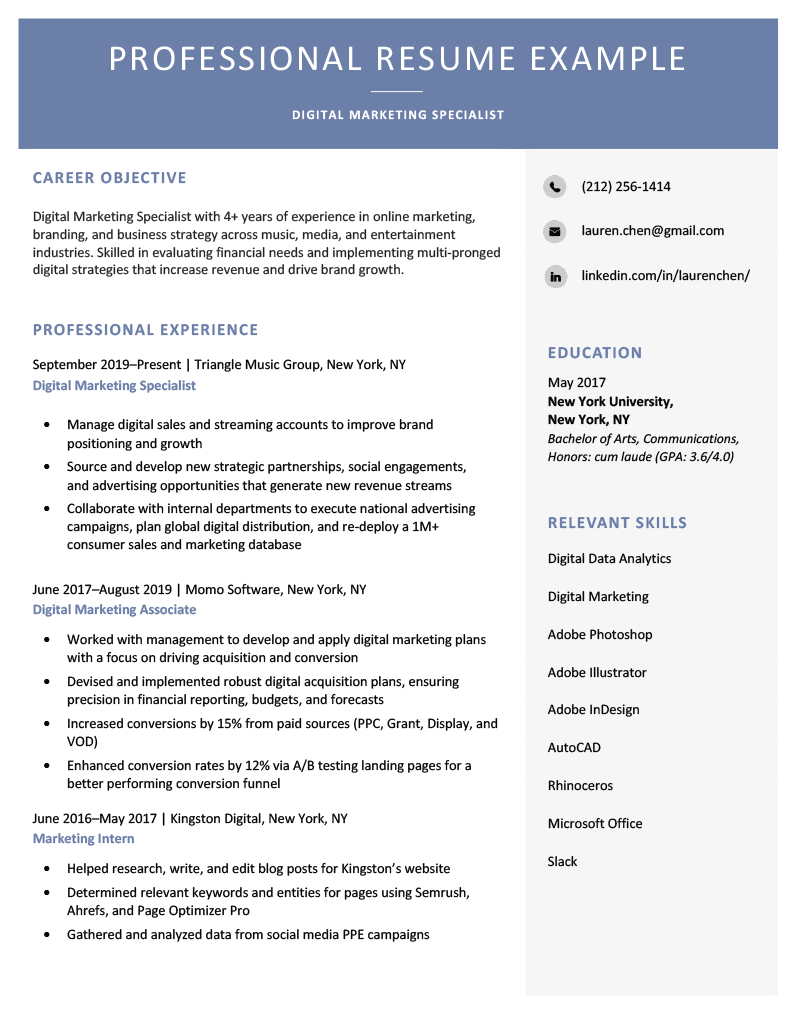
This resume example is good because it clearly advertises all the candidate’s qualifications in a concise, clear format.
The resume immediately draws in the hiring manager with a convincing resume objective that highlights the candidate’s strengths, before moving into a substantial overview of their skills and experience.
Additionally, the candidate includes concrete examples of their accomplishments as a marketing specialist throughout their resume with hard numbers to back them up. These examples give employers a clear idea of what the candidate is capable of achieving if hired.
Are these the best resume examples for 2024?
Yes, these are the best resumes for 2024 because each one is:
- Up-to-date: Each resume example is kept up-to-date by our team of career experts, and its page is regularly reviewed to ensure the content is relevant to current industry standards.
- Written by experts: All of our resume samples are either written by human resources (HR) professionals and career advisors or are real resumes written by people who landed jobs.
- Reviewed by experts: Our team of in-house Certified Professional Resume Writers (CPRWs) reviews each resume sample before it’s published. Current CPRWs on the team include Geoff Scott , Samuel Johns , Eva Chan , Corissa Peterson , and Aaron Case .
- Easy to use: Each sample can easily be downloaded as a Microsoft Word doc or copy-pasted directly from the page. Pull ideas from our samples, and edit them to match your own experiences.
What should I do if I can’t find a resume example for my industry listed here?
We’ve made an effort to include resume examples for as many industries as possible. However, there are still many jobs we don’t have samples for.
If you can’t find a resume example for your target job, here are a few things you can do:
- Check back later. We’re always adding new resume examples to our library, so if you don’t see the one you need now we might have it in the future.
- Use a related resume sample. Even if we don’t have a sample for the specific job you want, using a resume sample for a similar job in the same industry might give you the inspiration you need.
- Fill out a general resume. If you really can’t find a sample for your industry, writing a general resume designed to fit nearly any industry can help you get started on the job application process.
Can I use any of these examples to help write my own resume?
Yes, you can use any of the examples above to help you write your own resume. Select any resume example from the list on this page, and you’ll find the following:
- A professional template with job-specific bullet points and information
- Sections to present your skills, experience, education, and professional accomplishments
- A free download in Microsoft Word (.doc) format for you to personalize
- All resume information provided in text format – ready for you to copy and paste
- Writing tips to help you create a resume for that particular job or industry
We also have guides on how to write your own resume introduction , how to use resume action verbs , and articles outlining every other part of resume writing and formatting imaginable. They’re all accessible on our resume help blog.
What's the best resume format?
There is no such thing as the best resume format . The type of resume you choose should be based on your unique work history, work experience, skills, and qualifications. Here are examples of the formats you can use, and who should use each one:
- Chronological resumes — best for mid-level professionals with consistent work history, or inexperienced job seekers who are able to swap out work experience with relevant coursework , volunteer work , or internships .
- Functional resumes — best for career changers, or people who have gaps in their work history.
- Combination resumes — best for experienced professionals who have a wide range of skills and qualifications for jobs in their industry.
Can a resume be two pages?
Yes, a resume can be two pages. If you have 10+ years of experience in your industry or an exceptional amount of relevant skills and accomplishments, it’s okay to write a two-page resume .
However, for entry to mid-level candidates, a one-page resume is best for most job applications.
Do employers look at a resume or cover letter first?
Employers look at your resume first to make sure you have the skills and experience they’re looking for before taking the time to read your cover letter. In fields that require job-specific hard skills , such as IT and engineering, employers are even more likely to look at your resume first because those skills are simply required to do the job.
However, in more creative fields such as editing, journalism, and marketing, employers may read your cover letter first to ensure that your writing and communication skills are at the level they expect in new hires.
Should I give my resume to a recruiter?
Yes, you should give your resume to a recruiter. Recruiters can help you find jobs that aren’t posted publicly, and will fast-track your application if you seem qualified for the position. However, you should consider the following details before you give your resume to a recruiter:
- If the recruiter works in-house for a company, find out what role you’re being considered for so you can tailor your resume to the job’s requirements.
- If the recruiter works for an agency, make sure they are reputable before you send any document that includes your personal information.
More questions? Visit our FAQ library
Ready to start making your new resume?
Creating a resume takes time and energy, and even with a lot of effort still might not get you the job you want. Our resume builder software can help you quickly make a resume that best highlights your qualifications and earns you more interviews.
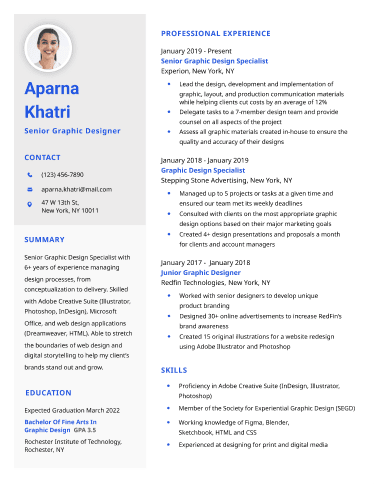
100% FREE TEMPLATES
Use our templates to win the job.
Each template on our website was designed by HR and hiring professionals to help jobseekers easily apply for work.
Sign up for more free templates & career resources!
In addition to this template, you'll also receive:
- Early access to our newest premium templates
- Job-specific resume tips & free examples
- Access to our exclusive newsletter for jobseekers
- Notifications of product improvements
* By sharing your email, you agree to receive marketing emails from our team. You can easily opt out of future emails on the dashboard of your account or by unsubscribing directly from the link at the bottom of an email you receive from us.

Build my resume
- Build a better resume in minutes
- Resume examples
- 2,000+ examples that work in 2024
- Resume templates
- Free templates for all levels
- Cover letters
- Cover letter generator
- It's like magic, we promise
- Cover letter examples
- Free downloads in Word & Docs
How to Make a Resume: 11 Easy Steps for 2024
Step 1: Choose Your Resume Format
Step 2: choose a simple resume template, step 3: decide your resume length.
- Step 4: Include Your Contact Information
Step 5: Describe Your Work Experience
When looking for your dream job, chances are others are, too. That’s why you want to make sure your AI cover letter and resume get noticed.
Starting from scratch is time-consuming and can result in improper formatting that won’t pass the initial ATS, which means your document may never reach a human.
Avoid frustration and know your resume will pass the ATS and grab the eye of a recruiter by using our AI resume builder . By filling in your information, you’ll have a great resume to showcase your talents in a way that’s appealing to recruiters.
You’ll also save yourself time, potentially up to three hours, over using resume templates for Word or Google Docs . Because relevancy is key to employers when skimming these documents, you’ll need a separate resume for each job you apply for. Our resume maker lets you create multiple resumes quickly.
While a resume should be a marketing tool to land an interview, it’s hard to know where to start. We’ve boiled it down to 11 steps to make it easier and faster to create the perfect resume for the role you want.
Real Estate Agent Resume
Get started customizing your own resume by clicking on this real estate agent resume below:

Resume format refers to the way you display pertinent information in your document. You’ll want to include contact information, a job title, work history, skills, education and any other information that will show the potential employer not only how your previous employment qualifies you for the job, but how you will be an asset to their company.
The way you set up this information can make it easier or more difficult for the recruiter. There are multiple ways you can format your resume, but there are three styles that are most common among job seekers.
- Reverse-chronological format is the preferred style for recruiters as it highlights your most recent relevant employment and accomplishments that relate to the new position. It’s also the best format to pass through ATS.
- Functional format is good if you have little work experience or employment gaps. It’s great for emphasizing skills for an entry-level position, but it can highlight a lack of actual work experience.
- Hybrid format is a way to show how your transferable skills relate to the new position, which can be beneficial if you’ve switched fields a time or two over the years.
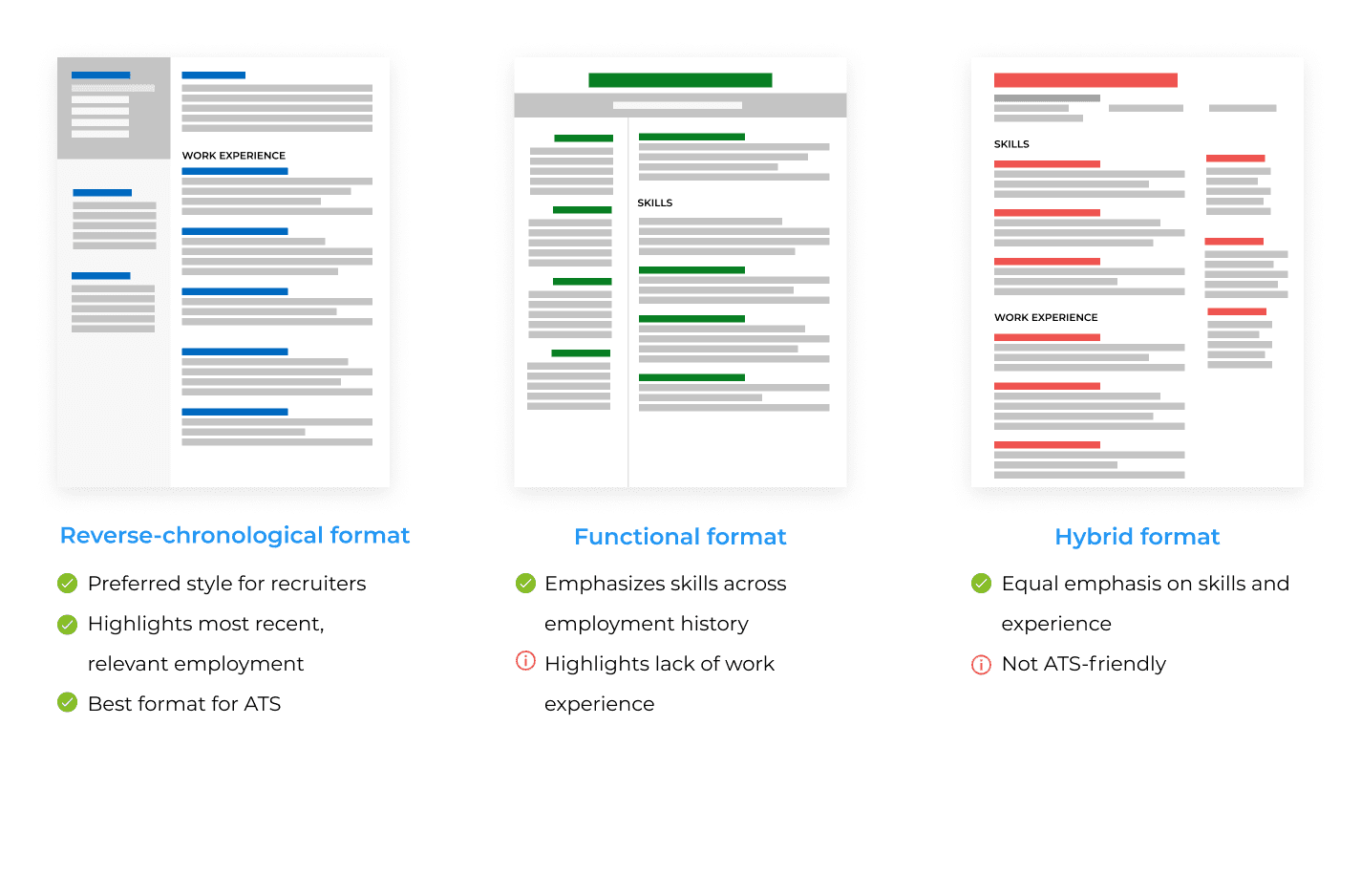
You may be tempted to choose a resume format based on your experience and the type of job you’re applying for. Just remember that recruiters will only spend about seven seconds skimming your resume before deciding if you deserve additional consideration or if you’ll be passed over without reading further to see if you’re a good fit for the position.
While each format has its pros and cons, nearly anyone can benefit from choosing the reverse-chronological format because it’s well known, and recruiters know exactly where to look for specific information, making their job much easier. When potential employers can see that you’re possibly a good fit in a quick skim, they’re more likely to read further.
Understandably, there are times when you might feel that it’s in your best interest to use one of the other popular resume formats. The other two styles may not pass through ATS, they can be confusing for recruiters who are searching for something in particular, and they definitely raise red flags regarding your work history. If your document passes through ATS and the recruiter can’t find what they’re looking for quickly, you can expect that your resume won’t get a second glance as it makes its way to the circular file. That’s why it’s always a good choice to put yourself in the shoes of the recruiter when formatting your resume.
You don’t want all of your hard work creating the perfect resume to go to waste. Even if you have little or no actual job experience, gaps in your career or various fields of work, the reverse-chronological resume format can be made to work to your advantage. Using a resume builder makes it easier to utilize applicable skills from other areas, such as volunteering, internships, military experience, and even hobbies you pursue on a regular basis.

While format is how you present your information, a resume template is a pre-made guide you can use to input your information in the format you choose. It can be tempting to select a template that uses pictures, diagrams, or complex patterns to portray your unique style, but these features just get in the way and won’t make it past the ATS. It’s best to choose a simple resume template as the words you choose will be what sets you apart from other applicants.
Simple doesn’t mean that your resume will look bland and devoid of character. On the contrary, a resume that’s formatted in a simple layout will pass through ATS with ease and will draw the recruiter’s attention to specific areas of focus for enhanced readability.

Our simple free resume templates make it easy for you to add or remove information and manipulate sections for personalization without affecting the overall layout of your resume. If you choose to work with a resume template through a word-processing program, like the creative Google Docs templates we just designed, making changes can throw everything off kilter, often causing you to have to start from scratch to correct the problem.

While it’s tempting to include as much of your work-related experience and skills in your resume, keep this information to one page [1] . Knowing this from the start helps you consider only relevant information and decide on ways to keep the information short and sweet. Recruiters have a limited amount of time they can spend reading resumes from quite possibly hundreds of candidates, so a one-page resume is generally the best choice.
A one-page resume

However, if you’ve worked in the same field for more than 10 years, you might find you need to use two pages to show a progression in duties and responsibilities in your field. Additionally, if you’re a high-level executive, scientist or professor, you may need additional room to provide enough information for a potential employer to gain a full understanding of how you’re the best candidate for the position. If you must use two pages, be sure that the second page is full for consistency.
You might notice that some employers ask specifically for a resume, a CV or they use resume and CV interchangeably. Whereas a resume is meant to be short and to the point, a curriculum vitae, or CV, is designed to provide more in-depth information. There are a few differences between a resume and a CV :

Step 4: Include Your Contact Information in a Header

The contact information section is the easiest part to complete, so its importance is often overlooked.
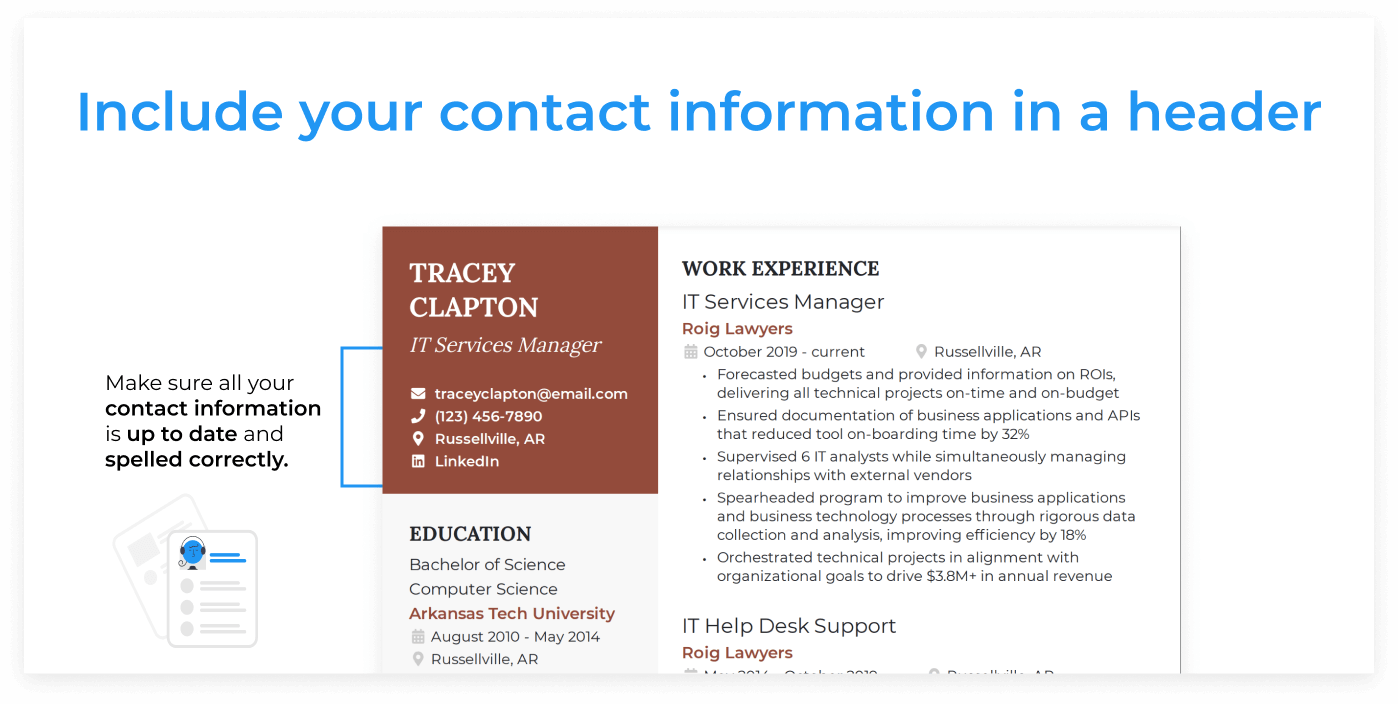
This is the meat of your resume and the part that’s the most important to potential employers. If you’re wondering what type of information to include in your work history section, a good way to get some ideas is to check out some resume examples for your field of expertise and years of experience.
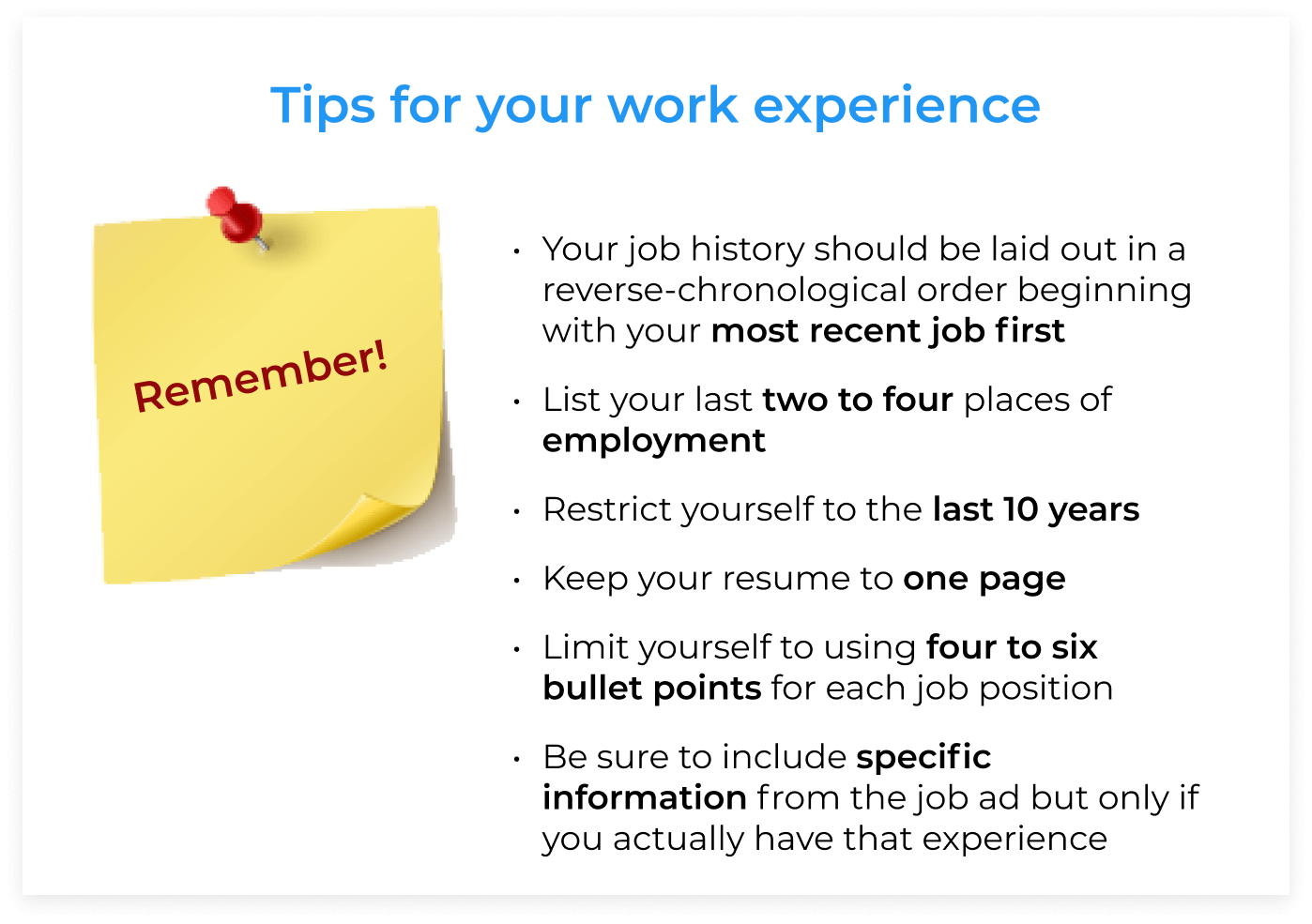
When crafting your document, be sure to include specific information from the job ad but only if you actually have that experience. Because the ATS will automatically search for appropriate keywords and phrases, you can readily find what employers are searching for in other resumes and the ad for the job you’re applying for. Also, look at other ads for similar positions to find industry-specific keyword information to include.
What details should I include about my job?
While recruiters may not take time to read every aspect of your previous work history, there’s some information that’s expected to be included in your resume. As with every other section of your document, make sure the spelling is correct and that there are no errors as this can ruin your chances of getting hired.

What do I write in my job description bullet points?
This is the area in your resume where you can get creative to help you stand apart from other applicants. If you simply list your job duties, your resume will look just like those of everyone else. Additionally, if you’re applying for a position with a similar title, the recruiter already knows the job duties for that position. You want to show the potential employer why you should be chosen for the position. You’ll need to provide specific examples that show a measurable impact.

5 ways to quantify your impact
Numbers represent facts that can’t be denied. When you put numbers on what you’ve accomplished, this stands out in the eyes of recruiters and builds your credibility.
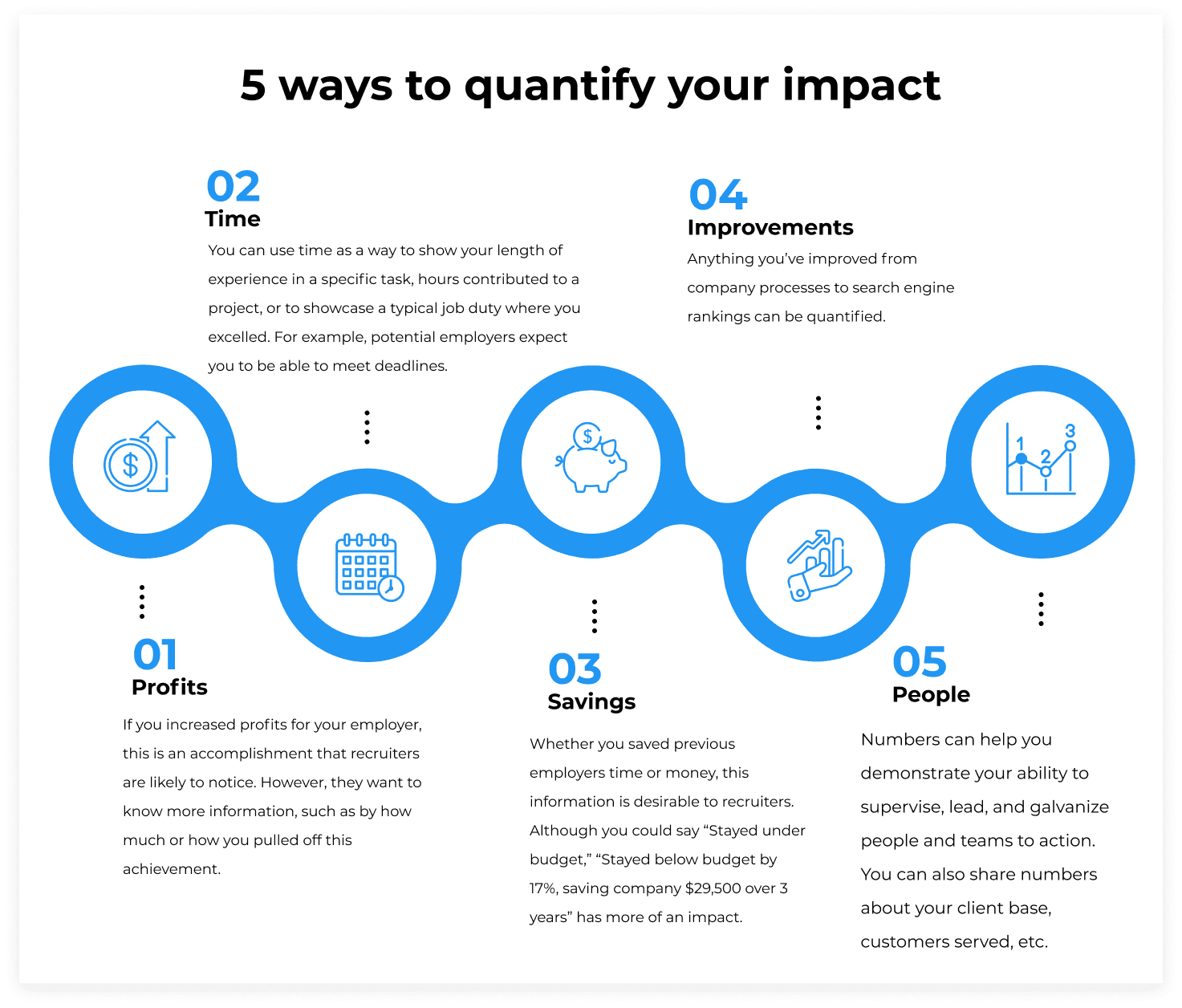
What if I don’t have work experience?
If you don’t have any work experience or have just a little under your belt, don’t worry. You’re not alone. There are many cases where you may not have actual paid work experience. If you’re a student or recent graduate, it’s understood that you’ve likely spent your time and focus on completing your studies rather than dividing your time between school and employment. In the same manner, you may be a homemaker or military personnel who is trying to enter or re-enter the job market, or you may be changing fields.
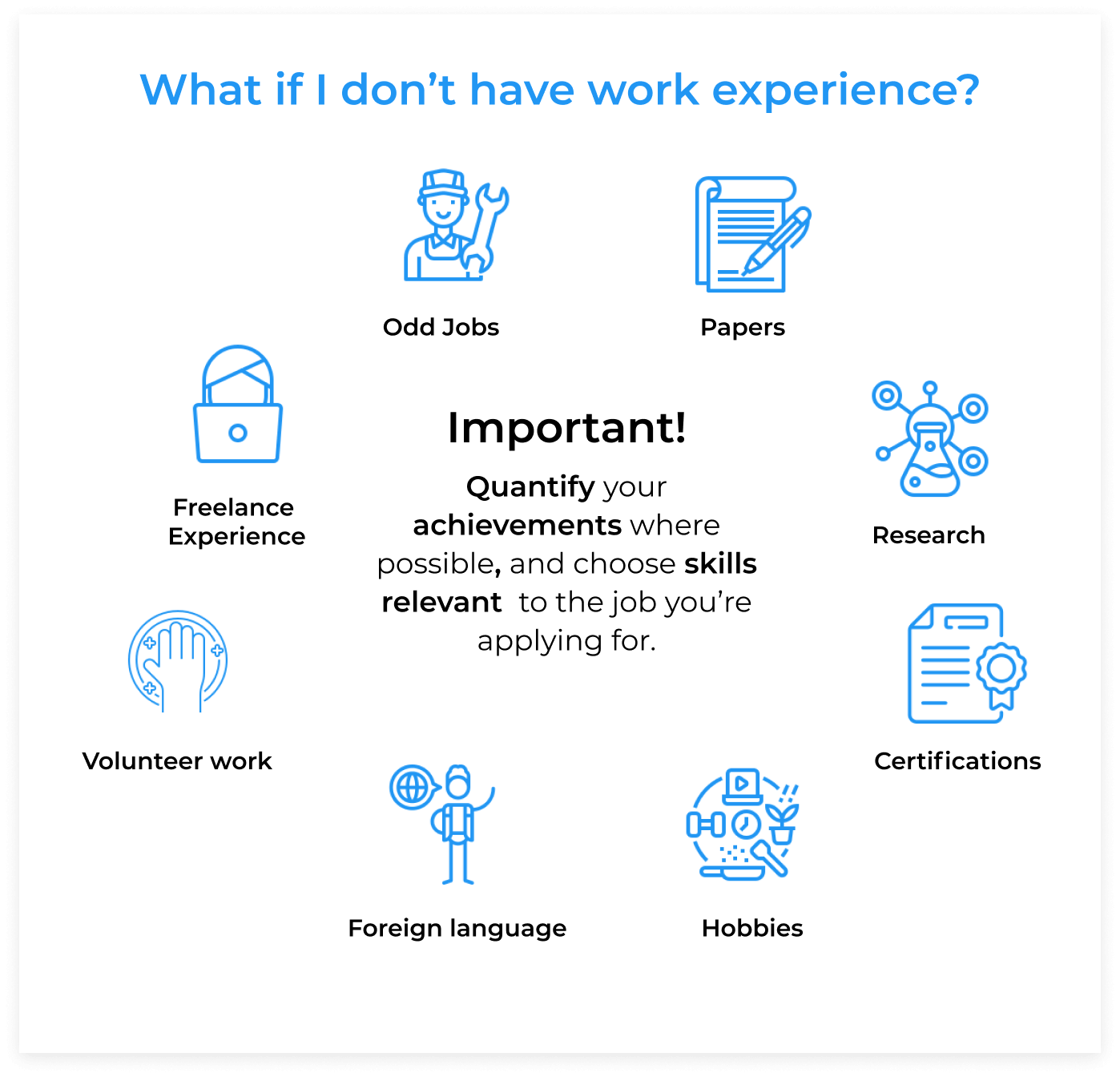
Volunteer work, freelancing, and odd jobs can be set up just like a paid position in reverse-chronological order along with any work history. Include the company name or use self-employed, the job title, dates of service and location.
Other activities or projects are a little trickier to add to the work experience section, so it’s important to include the appropriate information. Start with the project name, the company or who the activity was completed for and the date of the project. Use the list of bullets to describe the project and the role you played. As with other paid employment, quantifiable information stands out more than generalized statements.
Here are some examples: If you completed a successful project using software such as Java, SQL, or Python, you’ll want to describe this when applying for a technical position. Leadership skills are highly desirable and transferrable, so you’ll want to include any team projects that you spearheaded. If you excelled in a public speaking course, this could be relevant for a position where you’ll have a lot of face-to-face interactions with the public.
Begin by making a master list of your activities and projects. Now choose those that fit in with the job you’re applying for. You’ll go back to the master list to make it easier to find what you need when applying to other positions. Get inspired with more ideas by looking at resume samples like the one below that focus on projects and other types of experience.
Projects-based Resume Example

Step 6: Add Your Skills

The skills section lets you showcase the abilities that make you a perfect match for the job. When considering skills for your resume , only include those hard and soft skills that are relevant to the job position you’re applying for. The posted ad will most likely let you know at least some of the skills that the company is seeking in an applicant, so you can start with those. If there’s not enough information, look at similar job ads from other companies to fill in the gaps. Better yet, call the company and ask directly. Who knows? You may speak with the job recruiter, making a solid first impression through your initiative to do a little sleuth work.

Hard skills include your know-how and experience that are specific and quantifiable. Soft skills, on the other hand, are those you develop yourself through life experiences. Some hard skills you might want to include involve any software or technical skills you may have, such as bookkeeping, scheduling, content management systems, UX/UI design, foreign languages, data analysis, or even your typing speed. Soft skills employers find desirable consist of time management, leadership, active listening, communication, responsibility, and problem-solving.
Only include skills you actually have. For example, if the job ad states you must be proficient in Jira, don’t include this if you’ve only dabbled in it. You may have to complete a skills test as a part of the interview process, or you could be fired if you’re found out.
Rather than stretch the truth, consider taking online courses or refreshers to stay current with the latest trends. If you don’t have enough of the skills the company is seeking in the job posting, it’s probably wise to look for a position requiring more of the talents you possess.
Step 7: Include Your Education and Certifications
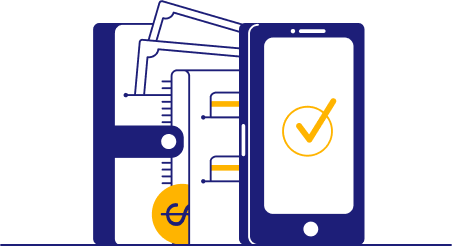
Your education and degrees should be listed in reverse-chronological order just like your work history. If you’ve completed higher education, there’s no need to add high school. Begin with the program name or degree obtained, followed by the name of the institution, the city and state where the institution is located, and the dates you attended. Alternatively, you can just use the year you graduated.
You can include your education even if you’re still in school. Follow the graduation date with “expected” or “anticipated” in parentheses. If you didn’t finish your education, whether high school or college, simply list “years attended” followed by the dates. College coursework you’ve completed that’s related to the position can be listed as well if you’re a recent grad.
Optionally, if you’ve recently graduated, you may wish to add a minor, your GPA if it’s 3.2 or higher, honors, achievements, projects, publications, or extracurricular activities if any of this information is relevant to the position or if you don’t have much in the way of work experience. This extra information gives recruiters more information on why they should choose you over other candidates.
Any certifications or licenses you hold should go in this section if they’re relevant to the job. This is a good opportunity to make sure your certifications and licenses are up to date. Because they vary from state to state and even between different companies within the same field, make sure you don’t disqualify yourself from the position by letting your certifications or licenses lapse.
Step 8: Decide Whether to Include an Objective or Summary
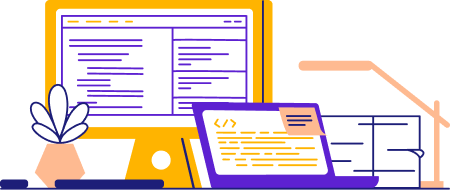
The resume objective or summary can either make the recruiter want to continue reading or pass you over for another applicant, so it’s important to capture employers’ eyes quickly with this section.

It’s best to save the objective or summary until after you’ve written your job bullet points, skills, and education sections, so you can draw information from these. Be sure to select appropriate keywords and phrases to use in the introduction to tie everything together into the position you want. Use the job description to decide on the specific wording combined with your expertise to make it easier for recruiters to make a match. Take a look at some resume objective examples or resume summary examples to inspire you.
Step 9: Decide Whether to Add Other Resume Sections

Now that you’ve completed the bulk of your resume, it’s time to really stand out. There are some additional resume sections you can add to emphasize your qualifications for the position.

You’ll want to include additional sections if you have limited work experience, are currently in school or recently graduated, are applying in a highly competitive field, or need to provide more information to show how you’re qualified for the job. Additionally, other sections can be used as a way to fill up excessive white space for a more balanced appearance for your resume.
While it can be tempting to include as much additional information as possible, you don’t want to stuff your resume with unnecessary information. Not only does this crowd your document and make it look messy, but it also makes it difficult for recruiters to sift through. Carefully work through any additional sections you’re considering when outlining your resume , so you can be sure you’ll strengthen what you’ve already included in as further proof that you deserve the position.
Step 10: Tailor Your Resume for the Job

It can’t be stated enough: You must tailor your resume to the specific position that you’re applying for. Don’t forget to search the job description for keywords that you can use in your previous employment bullet points, skills section, and resume objective or summary. You may even need to change your wording in the education and additional sections so they fit.
It’s important to write your resume for the position you want as listed in the job posting to make sure you pass through ATS and then draw the recruiter’s attention once the document reaches human eyes. Even if you’re applying for a single position across the board, you’ll need to create a new resume for each different company because they may all have different requirements and keywords. While this may seem like a lot of work, you don’t want it to look like you’re sending out mass-produced documents to just anyone and everyone.
At this point, you’ll also want to consider the type of field you’re in. If you’re applying to a highly professional position, you’ll want to keep your wording in line and focus on your expertise. Choose a traditional layout for your resume. However, if the position is with a casual startup in its early stages of operation, you can likely include more creativity because the recruiter may be looking for someone innovative and imaginative. In this case, choosing a more modern layout can help you stand out above other applicants.
Make sure your resume fits the bill by using our free resume checker . You’ll get valuable information and tips on how to improve your document to help you stand out.
Takeaway : Create multiple resumes. Since you’ll need a document that’s specifically tailored to get noticed, you’ll want a separate one for each position you’re applying for.
Step 11: Triple-Check for Spelling and Grammar

Your resume is a snapshot of you and your abilities. Make sure there are no errors. Proofread your document; then, do it again. Set it aside for a while or overnight, and come back to it to check for errors a final time. It’s wise to have a friend, coworker, or family member go through it as well. It’s hard to catch your own mistakes, especially after you’ve spent so much time writing and rewriting your document.
If there are errors, recruiters may assume you’ll make even more mistakes on the job. It’s imperative to put yourself in the shoes of hiring personnel. They have to look through potentially hundreds of resumes for each position, perhaps reading the same information over and over again. They’re looking for any reason to say no rather than yes just to reduce their workload. Don’t let spelling or grammatical errors give them that reason.
As an added benefit, you can choose one of our resume templates or use our resume builder to take the guesswork out of the format and layout for your document. You can easily make changes without messing up the appearance of your entire document. Once again, take advantage of our AI-powered resume tool to help you make the most of active voice, verb choice, quantifying your impact, and consistency, so you can quickly proofread your material.
How to Write a Resume in 2024

Writing a resume in 2024 is much different than in years past. Instead of creating a single document that you personalize with a cover letter, recruiters want to see that you have what they’re looking for with a quick skim. Additionally, ATS will search for relevant keywords, so it’s vital to tailor your resume to each specific position by looking at the job posting, similar positions, and completed resumes within your field.
Take a look at how to write each section of your resume, and be sure to include all of the necessary information. If anything is lacking, your resume could end up in the recycle bin before it’s even fully read by a recruiter. In the same manner, don’t add irrelevant information because it detracts from what’s important. Keep your resume to a single page.
Do your research. Specific keywords and phrases can determine if you get past the initial scan or not. The actual job posting contains valuable information that you should use to your advantage. Consider your experience that’s not related to paid employment for additional emphasis or if your work history is sparse. Always be honest with your abilities and what you’ve done because recruiters will check.
Find ways to stand out over other applicants with a simple resume design. You can use a premade template, but choose one that’s easy to personalize. To avoid layout blunders when making changes or passing through ATS, our resume builder will keep everything in its place. Finally, proofread your document. Get help from a third party, and use a resume checker .
[1] The Muse. (2016, August 10). 20 Basic Resume Writing Rules That’ll Put You Ahead of the Competition. Forbes .
[2] Caine, A., Gal, S. & Akhtar, A. (2020 November 19). We asked a career expert to build the perfect resume. Here’s a template you can use to update your CV and land a dream job. Business Insider .
[3] Gallo, A. (2014, December 19). How to Write a Resume that Stands Out. Harvard Business Review .
[4] Sweetwood, M. (2016 April 19). 13 Social Media Power Tips for Getting the Job You Want. Entrepreneur .
[5] Jackson, A. E. (2018 October 22). 21 Words to Never Include in Your Resume. Glassdoor .

How to Write Your First Job Resume [For 2024]

So there you are, sitting in front of a screen, staring at a blank Word page for hours, with one task at hand: writing your first job resume.
Where do you even start?
And most importantly: How do you fill those 1-2 pages when you have no work experience?
We feel your struggle and we’re here to help!
In this article, we’re going to guide you through the entire process of creating a first job resume from start to finish.
Let’s dive right in, shall we?
How to Write Your First Job Resume
- Pick the right resume template
- Write down your contact information (correctly)
- Include a resume objective
- List your education (in detail)
- Instead of work experience, focus on…
- Highlight your skills
- Mention optional sections
- Stick to the one-page limit
- Get inspired by a first-job resume example
Don’t worry, we’re going to cover all of the above in detail!
Starting with the first step:
#1. Pick the Right First Job Resume Format and Template
There are 3 main resume formats you can pick from. Each of them highlights a different part of your resume.
- Reverse-Chronological Resume - In this format, your work experiences and education are listed in reverse-chronological order.
- Functional Resume - Instead of work experience, this format focuses on your skills and achievements.
- Combination (or Hybrid) Resume - This format focuses on both your skills and work experience.
For 99% of job-seekers, we recommend sticking with the reverse-chronological format.
While a functional resume can sometimes help for career changers or recent graduates, it’s still nowhere near as common as the reverse chronological one.
Plus, recruiters world-wide are familiar with the reverse-chronological format, making it a safer bet.
A reverse-chronological resume looks as follows:

Once you’ve picked the format, the next step is to perfect your layout, font, and the like. Here’s what we recommend for that:
- Use a Two-Column Layout. A two-column resume layout allows you to fit a lot more content into your resume.
- Pick a Common Font. We recommend Ubuntu, Overpass, or Roboto.
- Use Bullets to Describe Your Experiences.
- Don’t Go Over One Page. Unless you’re a professional with a decade of work experience, we recommend sticking to the one-page resume limit.
Want to avoid all the hassle of formatting your resume layout? We don’t blame you - if you wanted to build a good-looking resume from scratch, it would take you hours before you could even start filling it in.
Thankfully, there’s an easier way out: using a resume builder.
With Novoresume, all you have to do is pick a template, and fill in the contents. It’s that simple.
And on top of that, Novorésumé resumes are ATS-friendly . Meaning, your resume won’t be swallowed up by an applicant tracking system just because it can’t read it.
Want to get started with Novorésumé? Browse our resume templates .

#2. Write Down Your Contact Information (Correctly)
It’s important for the recruiter to have at least two ways of reaching back to you.
Meaning, you should always provide your contact information in your resume . That includes:
- First and last name
- Phone number
Apart from these must-haves, you can also provide:
- LinkedIn URL - This is a good way to complement your resume. It also makes the recruiter’s life easier since they usually check your LinkedIn profile anyway. Make sure all information is updated and consistent with your resume, though.
- Relevant social media (like Quora or StackOverflow) - Any social media that is related to the job position and puts you in good light should be included in your resume. In most cases. If you’re a developer, it could be projects on GitHub. Writer? Personal blog.
- Website or blog - Again, this should be something related to the job. It shows your interest and dedication to the industry and how you spend some of your free time.
When it comes to your contact information, the key is to write everything correctly . Double-check you’ve spelled your name and email right, make sure the phone number you’ve listed can be reached, and that the accounts you have linked to are up to date .
Something else you should know regarding location is how much detail you should be providing.
The reason recruiters want to know your location is so that they have an idea of whether you’re in the vicinity of the company or not (and if you’ll need to relocate for work).
That means, providing the city and country where you live will be enough. No need for your full home address.
#3. Include a Resume Objective
Recruiters spend on average 7 seconds scanning each resume before deciding if it’s worth more consideration or not.
That means your resume has about 7 seconds to leave a great first impression and convince the recruiter you’re the person they’re looking for.
A good resume objective does that for you.
A resume objective is a 2-3 sentence snapshot of your skills, achievements, and career goals . Its purpose is to communicate your motivation for getting into the field and your interest in this particular position.
This makes it ideal for the first job resume of a recent graduate or somebody who’s changing careers. Basically, any resume with no work experience .
Your resume objective should be tailored to the position you are applying for and highlight skills that will help the company achieve its goal. Use as many facts and numbers as you can to back up any statements or achievements.
- Creative and motivated recent graduate with a B.A. in Marketing from the University of Michigan. Seeking permanent employment in the field of marketing after completing successful internships in 2 major media companies. Looking to further develop my market analysis skills and contribute to future marketing strategy developments at XY Company.
- I am looking to put my marketing skills into action by initially working for the marketing department of a well-known company until I can finally get to an executive position.
#4. List Your Education (In Detail)
For starters, you should know how to list your education entries correctly in the following format:
- Program Name e.g.: B.A. in Information Systems
- University Name e.g.: University of Chicago
- Years Attended e.g.: 07/2013 - 05/2017
- GPA (only if really high)
- Honors (If applicable) e.g. Cum Laude
Exchange Program (If applicable) e.g. Exchange program in Berlin, Germany
Apart from your skills, your education is the biggest selling point in your first job resume. This is not the place to be humble and play down your achievements!
Write down your GPA (if it’s something impressive), emphasize your honors, and most importantly, highlight your academic achievements by describing them in detail.
What you can also do is list specific courses that you have taken that are relevant to the position you are applying for.
Here’s an example of what an entry on the education section should look like:
B.A. in English Literature (Cum Laude)
Boston University
07/2014 - 05/2018
- Courses: Advanced Topics in Literature: Shakespeare’s Work
- Clubs: Boston University Drama Club
- Exchange program in London, UK

#5. Instead of Work Experience, Focus On This
As a recent graduate, the recruiter knows you don’t have any work experience - and that’s OK. As long as you’re applying for a junior or entry-level position, the experience isn’t something expected from you.
Instead, the recruiter will be looking for other experiences that enrich your profile, like:
- Internships
- Extracurricular Activities
When talking about these experiences, format them just like you’d format your work experience.
Business Analyst Internship
AAA Company
Milan, Italy
05/2019 - 12/2019
- Ran weekly and monthly analysis on diverse areas of the business
- Created insightful reports of the analysis to present to managers and teams
- Defined strategic KPIs, in order to monitor the efficiency of commercial operations
When possible, try to focus on listing your achievements and not your responsibilities. This will help you stand out from the rest of the applicants.
Haven’t done any internships? Include extracurricular activities.
More often than not, an applicant with extracurricular activities and an average GPA will impress the recruiter much more than a 4.0 GPA student with nothing else to show. When listing your extracurricular activities, each entry should have the following format:
Moot Court Club Member
2017 - 2019
- Participated for two years in a row at the Philip C. Jessup International Law Moot Court Competition, making it to the finals in 2019
- Researched and prepared written pleadings, called memorials addressing timely issues of public international law
- Helped train the new club members in topics of international law
Finally, you can also list independent projects, if you have any. Think, something you did on the side just for yourself. This can be a personal project, small business or startup, side-gig, blog, etc.
Amy’s Book Club Blog
2018 - Present
- Created my own book club website for reviewing and discussing the latest books.
- Curated a monthly book calendar for my followers to follow, combining trending, relevant, and classic books.
- Created over 40 book review articles.
- On average, received 2000 visitors per month to the blog.
#6. Highlight Your Skills
The two types of skills you can mention on your resume are soft skills and hard skills.
Soft skills are attributes that help you adapt to work environments, work in a team, and apply your hard skills effectively. They are related to your personality, social skills, communication, attitude, etc.
Hard skills refer to technical knowledge and specific tools. They are skills that one learns and applies directly to the job. Some examples of hard skills include:
- Financial accounting
- Adobe Illustrator
Although soft skills are becoming more and more in demand by employers , for your first job resume, we recommend sticking to hard skills.
Sure, attributes like “teamwork” or “critical thinking” are much appreciated by just about any employer.
The thing is, though, the recruiter can’t really tell if you actually have critical thinking skills, or just listed it on your resume to fill space.
Hard skills, on the other hand, are very easy to test.
Tailor Skills to the Job Ad
Not sure which skills to mention in your first job resume?
The simplest way to find the essential ones is to check the job ad.
The recruiter themselves mentioned the skills they’re looking for - the only thing you need to do is mention them in your resume (as long as you have them, anyway).
Let’s say you’re applying for a graphic designer position that wants the following qualifications and skills:
- Adobe Creative Suite proficiency, particularly InDesign, Illustrator, Photoshop and Acrobat; XD, Animate and/or After Effects are a plus
- Working knowledge of presentation software (Canva, PowerPoint and/or Keynote)
- Ability to work under pressure, manage work on multiple projects daily, manage a large workload and meet deadlines.
- Detail-oriented, highly organized
Based on that, your skills section should include the following:
- Adobe Illustrator, Photoshop, and Acrobat
- After Effects and Cinema4D
- Canva and Keynote
- Time management
- Detail-oriented
If the job ad isn’t too descriptive, you can also check out these 101+ most in-demand skills for 2024 .
#7. Mention Optional Sections
Still have some space on your resume?
That’s not a bad thing! You can use this space to your advantage and add some other useful sections.
Here are some ideas:
- Volunteering - If you have some volunteering experience, make sure to include it in your first job resume. Such a section shows commitment, dedication, and a sense of purpose, something most recruiters will appreciate.
- Languages - With companies becoming more and more international, additional languages are always appreciated.
- Hobbies - You can show your genuine interest in the industry or field by listing some relevant hobbies/interests.
- Awards & Certifications - Whether it’s an award from an essay competition in college or a certificate from an online course, anything that flatters your profile should be added.
#8. Stick to the One-Page Limit
“ How long should a resume be? ” seems like an eternal dilemma at this point.
Generally, the answer is: it depends.
Since you’re making a first job resume, the answer is: definitely one page .
Unless you have an extensive employment history that can’t fit into one page, there’s no need to go over that limit.
It’s unlikely that the recruiter will want to look at two pages of extracurriculars and hobbies.
#9. Get Inspired by This First-Job Resume
Need some inspiration for your resume? Check out the resume examples below.

First Job Resume FAQ
Still have some questions on how to write a convincing first job resume?
We’ll answer them here.
1. What do I put on my no-experience resume?
There’s plenty of other things you can include in your resume instead of work experience. For starters, you should:
- Focus on your education, making sure the entries are formatted correctly.
- Pick the right skills that match what the employer is looking for.
- Talk about internships, personal projects, or extracurricular activities. Describe your achievements in detail.
If you still have some space left, you could use it to your advantage and add extra sections like volunteer work, languages, awards & certificates, or hobbies.
2. Is a resume necessary for a first job?
Depending on the region, a resume or CV is always necessary for a job application, be it the first or the 20th.
Before deciding if they should call you for an interview, the recruiters need to have some insight into you and your skills.
3. Do I need work experience to land my first job?
Short answer: You don’t!
If you’re a recent graduate, it’s a given that you won’t have any work experience. Most employers don’t actually expect years of work experience for an entry-level or junior position.
Instead, they’ll be looking at your other types of experiences (internships, extracurricular activities, etc.) to decide on whether you’re a good fit for the job or not.
4. How do you write a resume for your first job?
The process is quite similar to the one for writing a regular resume, but with a few tweaks.
The exact steps for creating a first job resume are:
- Instead of work experience, focus on extracurricular activities, internships, projects, etc.
Key Takeaways
Writing your first job resume doesn’t have to be stressful!
Remember the following tips and you’ll do just fine:
- Pick the right format and template to avoid the hassle of formatting your resume. Make sure to pick an ATS-friendly resume template.
- Write a concise and attention-grabbing resume objective. Show the recruiter that you’re relevant for the role and that they should read the rest of your resume.
- Instead of work experience, include information on your internships, projects, and extracurricular activities.

To provide a safer experience, the best content and great communication, we use cookies. Learn how we use them for non-authenticated users.
Language selection
- Français fr
Name of Web application
How to write a good resume.
Your resume must clearly, concisely and strategically present your qualifications to get a recruiter interested in meeting you. It should convey your skills, work experience and assets. The resume is used to describe what you can accomplish professionally in a manner that also illustrates what you can do for an employer. Job opportunities can arise unexpectedly. An updated modern resume is the key to a successful job search. Here are some do's and don'ts of how to write a good resume and what to include.
Resume Writing Do's
An employer takes an average of 30 seconds to skim a resume. You want them to see right away that you are qualified for the position.
Be sure there are no spelling or grammar mistakes. Have someone else read it over as well. A simple spelling mistake on a resume can give a negative impression to the employer. It can even prevent you from getting the job.
Place the emphasis of your resume on your most recent experience. Older jobs and experience that are more than 15 years old should either be cut out or minimized. This way, the employer can focus on more relevant information.
Specify work experience or achievements that are related to the position you are applying to. This can be done by reviewing the job description or the employer website.
You want to be able to identify the best examples of where you demonstrated your skills. These examples should speak to what you achieved in your role, and should demonstrate what kind of employee you are. It is best to include this information in the "Work experience" section of the resume.
Lying on your resume is never a good idea. You don't want to overstate your skills or results as it will mislead the employer. Have confidence in what you have to offer.
Use firm numbers that the employer will understand and be impressed by. For example, how many people you supervised, how many products you sold, by what percentage you increased sales, etc.
The person reading your resume might not always be the employer. Resumes can be reviewed by recruiters or Human Resources specialists who may not be familiar with your specific field. Use simple and plain language, but also persuasive verbs such as handled, managed, led, developed, increased, accomplished, leveraged, etc.
If you have volunteered with a well-known organization or worked for an important cause, put it in your resume. You should include these experiences under the "Work experience" or the "Volunteer work" section, especially if they are related to the position you are applying for.
Your resume should list your name, address, email and phone number. This information should be placed at the top of the first page. Also, make sure this information is accurate. Otherwise, the employer won't be able to contact you.
Resume Writing Don'ts
Make sure your email is easy to read, easy to type, professional and non offensive. In general, your email address should be based on your name. Exclude any nicknames, numbers, or special characters.
It is best to leave out any personal details such as age, weight, height, marital status, religious preference, political views, or any other personal attributes that could be controversial. This will prevent any potential bias. Most importantly, never include your Social Insurance Number in your resume.
Although in some countries it may be acceptable to include a photo, it is not the norm in Canada. It can actually lower your chances of obtaining a position and divert the whole focus of your resume. You want the employer to focus on your skills and experience, not what you look like.
Make your resume easy to read by limiting each resume section or sub section to 5-7 bullet points. This will make it easier for the employer to scan your resume and identify your potential. Each bullet point should be used wisely by keeping the information relevant and concise.
Do not use "I," "my," or "me". Write your resume in the third person, as if it's being written by someone else.
Your job duties will be obvious from your job title. Instead, highlight your achievements by putting a personal spin on your job duties and providing specific examples.
Steer clear from vague statements that don't highlight your actual contribution. Unclear statements such as, "Responsible for improving efficiencies and making cost savings", does not provide any information to an employer. Personalize your experience!
The main purpose of your resume is to promote you, your skills, experience and achievements. It should be entirely positive, and therefore should not include reasons for leaving as it does not add any value to you as a candidate.
An employer only requires references if they are seriously considering hiring you. Keep references on a separate sheet and provide them only when they are specifically requested.
It is not recommended to mention hobbies because of the judgments potential employers can make. However, if your hobbies relate to the position, you may include them as they can demonstrate to the employer why you are a good fit.
Want to create a professional resume in a few minutes? Sign up for a Job Bank account to use our free Resume Builder tool.
It looks like you are visiting Job Bank from outside Canada.
If you are not legally authorized to work in Canada, you can’t apply for every job on Job Bank . Most Canadian employers will not hire you if you do not have a valid visa or work permit.
Visit Job Bank’s page for foreign candidates to review your options and find jobs from employers who are recruiting outside Canada.
How to Write a Resume for Today's Job Market
Posted on 03 sep 2024.
According to Gitnux, recruiters spend less than 15 seconds on 55% of job applications. This makes it crucial to build an eye-catching resume that effectively conveys your skills and qualifications to keep recruiters reading. This guide explores what to write in a resume to make it stand out, a resume sample, and additional tips.
How to Write a Resume for a Job
It's important to understand how to present yourself as the ideal candidate by highlighting key aspects of your professional background. Follow these eight steps to make a resume that stands out to hiring managers.
1. Gather the Relevant Information
Gathering information relevant to your desired job enables a smooth resume-writing process and the inclusion of all important details. Carefully review your qualifications and create a comprehensive list that includes:
- Soft skills, hard skills, and technical skills
- Job titles, dates of employment, and key duties
- Impressive measurable accomplishments
- Educational credentials that demonstrate your expertise
- Volunteer work that helped you develop skills and experience relevant to the job
- Notable awards and honors you received
Once gathered, you can sort through them and exclude information less relevant to your desired job.
2. Choose the Right Format
There are three different resume formats you might use, each organized differently to best highlight your selling points.
- Chronological : This resume format emphasizes an individual's work experience, making it ideal for those with a strong work history and professional achievements.
- Functional : The functional resume format focuses on the individual's skills, training, and education. It is an excellent formatting choice for those entering the workforce or changing careers.
- Combination : A combination or hybrid resume combines the functional and chronological styles to highlight your skills and work experience if you want to advance in your career.
3. Add Your Contact Information
Clearly display your name and contact information at the top of your resume so recruiters know exactly how to contact you for a job interview. Contact information should include your phone number and email address. Your name and job title should be in a bolder and larger font than the rest of the document text. You may also include a link to your professional online portfolio.
4. Write a Compelling Resume Summary
Write a concise and impactful resume summary that gives an overview of your skills, qualifications, and career goals and conveys your professional personality. Hiring managers may only review your resume briefly — display your most attractive qualities as a candidate so recruiters feel compelled to explore your resume further.
5. Add a Persuasive Work Experience Section
A persuasive work experience section should include a comprehensive summary of your past job roles. Each job role included in your work history section might include some of the following features:
- Dates of employment
- Company location
- Primary job responsibilities related to the job you're applying for
- Noteworthy work accomplishments during your employment
6. List Your Education History Accurately
If you have recent education credentials, you may also make a comprehensive and accurate education section. Each listing might include:
- The name of the school, college or university
- Location of the school
- Year and month of graduation or the expected graduation date
- Degree received
- Relevant coursework
- Relevant achievements, such as awards, scholarships, and honors
7. Use a Skills Section to Highlight Your Strengths
There are three categories of skills you might include on your resume, including:
- Hard skills : Hard skills are typically gained through coursework and work experience, such as computer forensics skills, email and social media marketing, or risk management and identification.
- Soft skills : These cannot always be taught and are generally traits that help individuals excel in the workplace. Examples include attention to detail, creativity, and adaptability.
- Technical skills : Technical skills include specialized knowledge and expertise in certain areas that allow you to perform specific tasks well. These skills may include using specific tools like Adobe Creative Suite or Java extremely well.
8. Highlight Accomplishments in Optional Resume Sections
If you have relevant accomplishments that might catch the recruiter's attention, include them in a section on certifications, licenses, and training. Specify its title, when you received it, and a brief description. You can also create an awards, honors, and volunteer work section if you have achievements relevant to the desired job.
Sample Resume Example
Here is one of the best sample resume examples following the combination resume:
Chanelle Cooper Certified Project Management Professional Los Angeles, CA 90058 555-555-5555 [email protected]
Highly reliable, result-oriented project manager with four years of experience in product and project management involving implementing, developing, and supporting complex infrastructures for fast-growing startups. As an eager and hardworking individual, I adapt to changing project requirements well and have a proven history of solution-oriented problem-solving.
Professional Experience
Project Manager
[Company name] 2022-Present | Los Angeles, CA
- Led a team of developers to build a proprietary CRM system
- Curated a $2 million business implementation project that helped save around $3 million in operational inefficiencies between the development and sales departments
- Optimized the company's sales process and increased sales revenue by 20%
Customer Success, Product Support
[Company Name] 2021-2022 | San Francisco, CA
- Streamlined post-sales support and increased customer retention rate by 28%
- Researched user behavior and led a strategic product roadmap across multi-functional teams
- Integrated a reporting system into BI sales workflow, increasing post-meeting inquiries for the technical sales department
- Technical skills: Tableau, SQL, JIRA and Python
- Hard skills: Process management, project initiation and planning, risk management, and documentation
- Soft skills: Critical thinking, leadership, prioritization, and coaching
University of California, Berkeley | 2016-2020 | Berkeley, CA Bachelor of Science, Industrial Engineering, 3.8 GPA
Resume Writing Tips to Help You Land the Job
Here are a few valuable resume-writing tips on how to put together a compelling resume.
- Include keywords related to your target job : Recruiters typically use applicant tracking systems (ATS) to filter through resumes and narrow them down to applicants that meet the job position's needs. To help ensure the hiring manager sees your application, include keywords related to your desired job , often found in the job description itself.
- Dedicate time to form and proofread your resume : You may make a good impression on the company by proofreading your work and dedicating time to tailor your resume for each job.
- Make the resume scannable and ATS-friendly : You can make it easier for the ATS to understand your resume by incorporating good formatting , such as using consistent spacing and alignment; avoiding complex headers, tables and graphics; and using words and headings that are easily recognizable to the ATS.
- Get help from a professional resume writer : If you lack time to work on a resume or need assistance forming a compelling one, professional resume writers may help you create one that accurately and appropriately outlines your professional background.
Leverage Resume-Writing Services From Resumeble
Do you need assistance writing a resume that portrays you as a reliable professional? Resumeble offers premium resume-writing services. Our certified resume writers work to understand your unique qualities, work background, and career goals and craft a personalized ATS-optimized resume that accurately reflects your specific skills and experiences. For more information, review the perks of our resume service and place an order today.
- 7 seconds: this is how long your resume has either to impress or be ignored by the recruiter
- 300+: average number of applications one corporate job opening posted online receives
- 3%: number of sent resumes that result in interviews
Transform your career and beat the odds!
Similar Articles
Posted on : 19 Jul 2024
Posted on : 09 Jul 2024
Posted on : 30 Jul 2024
Posted on : 26 Jun 2024

Protect your data
This site uses cookies and related technologies for site operation, and analytics as described in our Privacy Policy . You may choose to consent to our use of these technologies, reject non-essential technologies, or further manage your preferences.
- Resume and Cover Letter
- 27 Great Resume Summary...
27 Great Resume Summary Examples to Get Hired
20 min read · Updated on August 28, 2024

Your resume summary is the first impression you make on potential employers, so it's crucial to get it right
When it comes to job applications, your resume is often the first point of contact with prospective employers. It's essential to make a good impression right from the start, and that's where your resume summary comes in.
What is a resume summary?
How can you create one that will help your resume stand out from the competition?
In this article, we'll explain the resume summary and why it's so vital for job search success. We'll also teach you how to write a great resume summary that will grab any employer's attention and provide 27 fantastic resume summary examples that you can customize to fit your job search needs.
What is a resume summary?
To understand a resume summary, it's important to understand the challenge that good summaries are designed to overcome. Employers who are looking for new hires often need to compare many dozens or even hundreds of resumes to find the best candidates for the job. Few hiring personnel have the time needed to thoroughly examine every single resume that they receive.
Instead, employers typically spend no more than five or six seconds scanning any given resume. If a resume manages to capture their interest in those few seconds, they'll take the time to read it in greater detail.
However, if your resume doesn't grab their attention, it's likely to be rejected without any further examination. So, the challenge is to find a way to quickly earn the reader's interest and inspire them to read the rest of the document.
That's where a professional summary for a resume comes into play. As you'll see from our resume summary examples, a good summary is the resume equivalent of a salesperson's elevator pitch.
This brief statement should highlight your experience and job title, one or two key skills, and a couple of your most prominent achievements. When your summary is crafted well, it will provide the employer with a quick overview of your potential value as a new hire.
Once you've written your summary, you should place it right after your contact information and resume headline so that it's the first thing employers see. If you've done your job properly, that summary will be compelling enough to make the reader want to learn more about the type of value you can bring to the job.
How should you start a resume summary?
Since your summary is designed to capture the reader's attention, it's vital to start this paragraph off in a compelling way. While the statement should be brief, it should also clearly communicate your unique value proposition. Here are some examples of strong opening statements:
Innovative Marketing Manager with over five years of experience in developing and executing successful campaigns for Fortune 500 companies
Results-driven Sales Executive with a proven track record of exceeding revenue targets and building strong client relationships
Skilled Customer Service Representative with expertise in problem-solving, conflict resolution, and communication
Tips for writing a resume summary
To make sure that you create the most powerful resume summary possible, follow our top tips:
Be specific
When writing a resume summary, it's essential to be specific and quantify your achievements wherever possible. Instead of saying, "Experienced marketing professional," try saying, "Experienced marketing professional with expertise in managing successful social media campaigns, resulting in increases of up to 30% in website traffic."
This provides concrete evidence of your skills and demonstrates your value to potential employers.
Reflect on your career
When it comes to writing a strong resume summary, you should engage in some self-reflection. Before putting pen to paper (or fingers to keyboard), take some time to think about your key skills, experiences, and achievements. This will help you identify the most important information to include in your summary. Review your past roles, responsibilities, and accomplishments, and think about how they relate to the job you're applying for. Ask yourself:
What have I achieved in my career?
What skills have I developed?
What makes me stand out from other applicants?
Identify your key skills
One of the most important things to include in your resume summary is your key skills. These are the abilities that set you apart from other candidates and demonstrate your value to potential employers. Begin by making a list of your top skills, then prioritize them based on relevance to the job you're applying for.
Highlight your relevant experiences
Next, think about relevant experiences that you can include in your summary. This includes any previous jobs or internships, volunteer work, or extracurricular activities that have given you valuable experience. Consider what you've learned and achieved in each role and how that relates to the job you're applying for.
You should focus on what is most relevant to your target job. Here are some examples:
Proven ability to increase sales revenue by 20% year-over-year
Expertise in project management and team leadership
Proficient in Adobe Creative Cloud and Microsoft 365
Confident working with a diverse range of clients and stakeholders
Keep it concise
Remember, your resume summary should be concise and to the point. Stick to the most important information and avoid filler words or irrelevant details. A good rule of thumb is to keep your summary to 3-5 sentences.
Use action verbs
When describing your experiences and achievements, use strong action verbs and adverbs to convey a sense of accomplishment and momentum. For example, instead of saying, "Responsible for managing social media accounts," say, "Successfully manage 4 social media accounts, including Facebook, TikTok, LinkedIn, and Instagram."
Quantify your achievements
Wherever possible, use numbers and statistics to quantify your achievements. This provides concrete evidence of your skills and demonstrates your value to potential employers. For example, instead of saying, "Helped to increase sales," say, "Helped to increase sales by 20% in the first year."
Tailor it to the job
Make sure your resume's professional summary is tailored to the job you're seeking. This means highlighting the skills and experiences that are most relevant to the role. Look at the job description identify the key requirements, and then make sure your summary addresses these points.
Professional resume summary examples
Since there's nothing quite like seeing an example of a great summary, we've compiled twenty-seven great resume summary examples that you can use as inspirational templates for your own perfect resume . Below, you'll find summary examples for a variety of different job roles, including:
Customer Service Representative
Sales Representative
Marketing Manager
Project Manager
Software Developer
Human Resources Manager
Graphic Designer
Registered Nurse
Financial Analyst
Administrative Assistant
Data Entry Clerk
Business Analyst
Operations Manager
Mental Health Counselor
High School Teacher
Event Manager
Product Designer
Content Marketer
SEO Specialist
Bank Teller
Software Support Specialist
Data Scientist
Dental Assistant
1. Customer Service Representative resume summary example
"Highly motivated Customer Service Representative with 5 years of experience in delivering service excellence. Skilled in conflict resolution and problem-solving, resulting in a 95% customer satisfaction rate. Proven ability to multitask in fast-paced environments while maintaining accuracy and attention to detail."
Why it works : This summary highlights the candidate's experience and skills while also showcasing their relevant achievements in ensuring customer satisfaction. It mentions how much experience they have and highlights a measurable success.
2. Sales Representative resume summary example
"Dynamic Sales Representative with a track record of exceeding sales quotas by 20%+. Proficient in consultative sales techniques and relationship building. Exceptional communication and negotiation skills with the ability to close deals."
Why it works : This summary provides a quantifiable achievement to show the candidate's success in their previous sales roles while also highlighting their key skills in relationship building and communication.
3. Marketing Manager resume summary example
"Strategic Marketing Manager with 7+ years of experience in developing and executing successful marketing campaigns across multiple channels. Skilled in market research and analysis, campaign optimization, and team leadership. Proven track record of driving revenue growth and increasing brand awareness."
Why it works : This summary emphasizes the candidate's experience and leadership skills while also showcasing their ability to drive results through successful marketing campaigns. The candidate has also demonstrated their ability to grow revenues and raise brand awareness.
4. Project Manager resume summary example
"Accomplished Project Manager, with confidence in leading cross-functional teams and managing project timelines, budgets, and resources. Strong communication and collaboration skills, with the ability to build relationships with stakeholders. Proven track record of delivering projects on time and within budget."
Why it works : This summary highlights the candidate's extensive project management experience and emphasizes their ability to successfully deliver projects while working with multiple stakeholders.
5. Software Developer resume summary example
"Innovative Software Developer with 5+ years of experience in designing, developing, and implementing complex software applications. Skilled in programming languages including Java, Python, and C++. Demonstrated ability to work collaboratively in Agile environments to deliver high-quality code on time."
Why it works : This job seeker has taken the time to highlight some of the technical skills they possess while emphasizing their ability to work in Agile environments. They also call attention to the fact that they can manage and complete a software development project from design to implementation.
6. Human Resources Manager resume summary example
"Experienced Human Resources Manager specializing in talent acquisition, employee relations, and performance management. Skilled in developing and implementing HR policies and procedures that align with business objectives and values. Proven track record of building and managing high-performing teams."
Why it works : This summary highlights the candidate's experience in various HR functions and emphasizes their ability to build and manage teams. It also shows that they can perform managerial functions like developing policies and procedures.
7. Graphic Designer resume summary example
"Creative Graphic Designer with particular expertise in developing and executing visually stunning designs for print and digital media. Proficient in Adobe Creative Cloud, with a focus on typography and layout. Strong communication and collaboration skills, with the ability to work on multiple projects simultaneously."
Why it works : This summary works well because it showcases their technical skills and experience while also emphasizing creativity and an ability to work collaboratively.
8. Registered Nurse resume summary example
"Compassionate Registered Nurse with over 10 years' experience in providing high-quality patient care. Skilled at patient assessment, medication administration, and treatment plan development. Strong communication and interpersonal skills with the ability to build rapport with patients and their families."
Why it works : This summary emphasizes the candidate's clinical and patient care experience and highlights their key nursing and interpersonal skills.
9. Financial Analyst resume summary example
“Detail-oriented Financial Analyst with a strong background in financial modeling, data analysis, and forecasting. Combines advanced Excel skills with the ability to create and manage financial reports. Able to work collaboratively with cross-functional teams.”
Why it works : This summary showcases the applicant's specific skills and experience in financial analysis and highlights their proficiency in Excel, a crucial tool for the role.
10. Administrative Assistant resume summary example
“Skilled Administrative Assistant with 8 years of experience in administrative support and office administration. Resilient, detail-oriented, and able to work under extreme pressure in a team environment. Excellent interpersonal, client management, and interdepartmental liaison skills. Committed to successful management of multiple simultaneous projects, strict adherence to deadline requirements, and accurate maintenance of schedules, meeting obligations, and records.”
Why it works : An Administrative Assistant wears many hats and experiences many challenges. This resume summary covers a lot of ground to demonstrate that the candidate understands those obstacles and knows how to overcome them.
11. Data Entry Clerk resume summary example
“Task-driven and results-oriented professional with more than 10 years of experience in data entry, project coordination, and customer service. Uses interpersonal skills including effective communication to build rapport and positive relations with customers, gather vital information, and ensure rapid and accurate entry of data into designated software programs.”
Why it works : This resume summary is effective because it gets right to the heart of the job: dealing with customers and entering data into databases. The candidate also emphasizes their results-focused mindset, project skills, and key soft skills.
12. Business Analyst resume summary example
“Results-driven Business Analyst with a proven record in expanding profitability by 55% in the retail industry. Confident carrying out data-focused analysis that provides key insights and recommendations for growth strategies. Strong interpersonal and team building skills, innovative approach to problem-solving , and resolute commitment to efficiency and productivity.”
Why it works : Business analysis is all about using data and research to deliver key insights that result in improved operations and greater business success. This summary hits all the right notes as it focuses on key skills, a solutions-oriented mindset, and notable achievements that reflect real value for employers.
13. Operations Manager resume summary example
“Results-oriented Operations Manager with more than 10 years of supervisory experience in high-level operational environments. Adept at coordinating both large and small teams, outside consultants, and mid-level management personnel. Successfully introduced Lean manufacturing principles that reduced costs by 32% via waste elimination and process revitalization.”
Why it works : This candidate's summary emphasizes key skills that the employer wants to see in any managerial candidate's resume while also showcasing their knowledge of best operational practices and a commitment to cost reduction.
14. Mental Health Counselor resume summary example
“Compassionate Mental Health Counselor with more than a decade of experience addressing mental health issues and behavioral concerns. Proven success in both individual and group counseling environments, assisting clients in gaining insight and understanding of their unique conditions. Specialized focus on working with young adults and families, with an emphasis on addressing substance abuse root causes and other social factors involved in mental health.”
Why it works : This resume summary is notable for citing important skills like empathy and compassion. It also focuses attention on the candidate's experience in dealing with common mental health concerns and hints at their preferred approach to assisting patients.
15. High School Teacher resume summary example
“Dynamic high school teacher with 12 years of experience developing approved curricula for more than 500 students in grades 9-12. Proven track record of helping students to achieve a 98% passing rate in both Western Civilization and World History instruction. Actively engaged in every aspect of education, at the district, local, and parent-teacher level.”
Why it works : This candidate's resume summary highlights their vast experience while illustrating their success in ensuring that their students learn what they need to know to pass the class. They also demonstrate their commitment to the educational process by highlighting their involvement in every area of education.
16. Accountant resume summary example
“Diligent and detail-oriented CPA with seven years of experience in accounting, process improvement, and problem-solving. Skilled at identifying inefficiencies and using reporting to offer insights that can guide employers to better practices and greater profitability. At XYZ Corp., identified labor usage inefficiency that motivated management to introduce new scheduling that eliminated $300,000 in labor waste.”
Why it works : In addition to highlighting a wide range of valuable skills, this candidate also focused on a quantifiable achievement that illustrates real value. This type of summary would certainly capture a hiring manager's attention and make them want to read more!
17. Event Manager resume summary example
“Resilient and creative Event Manager with 6 years of corporate experience. Detail-oriented perfectionist with experience in project management, team leadership, and customer relations. Successfully organized and executed more than 40 major business conferences, hosting thousands of guests. Major clients have included three Fortune 500 firms with multi-million-dollar event budgets.
Why it works : As Event Managers go, this one has certainly made the rounds. That summary of achievements highlights their ability to manage even large-scale events, dealing with every aspect of the project. How could a serious hiring manager not want to learn more about this candidate?
18. IT Manager resume summary example
“Dedicated IT Manager with significant experience in an innovative and growing tech firm. Skilled leader with experience in systems analysis, database architecture, problem-solving, and troubleshooting. Superior client satisfaction rate of more than 99%. Created and implemented an IT troubleshooting process that reduced internal client service time by 30%.”
Why it works : This IT professional focuses attention on their key leadership skills , while also mentioning the hard skills that any hiring manager is likely to be looking for. There's also a nice nod to their history of satisfying clients, as well as a notable and measurable achievement.
19. Product Designer resume summary example
“Innovative Design Engineer with 5 years of experience in the development of products and packages. Skilled in market research, brand development and alignment, and design elements. Led team of seventeen Designers in the creation of industrial products that yielded $20 million in sales in the first month after launch.”
Why it works : This resume summary uses some important keywords, action verbs, and descriptive language to describe the candidate's key skills and experiences. It also cites an impressive product design achievement, along with real numbers that showcase value.
20. Content Marketer resume summary example
“Creative marketing professional with 7 years' experience as a Content Marketer. Skilled writer who understands how written communication empowers business growth and expansion. Expertise in development of compelling content that drives activities across multiple media channels. Adaptable , detail-oriented, and focused on a brand-building approach to content strategy that drives real results. Developed a cross-platform content strategy that boosted sales conversion rates by 37%.
Why it works : This Content Marketer focuses on their key skills and keen insights into how content impacts business profitability. They even included a measurable result that demonstrates their focus on adding value to their employer's bottom line.
21. SEO Specialist resume summary example
“Results-focused SEO expert with 6 years of experience in keyword mastery, the promotion of sustainable content, and growing organic website search engine rankings. Proven track record of SEO success, using content development and link outreach to expand website traffic activity from 10,000 daily visitors to more than 2,000,000 per year.”
Why it works : Many hiring managers may not fully understand SEO, but they will understand the need to get more eyes on their digital content. This candidate speaks to that need by focusing on website rankings, content, and overall web traffic - while including a quantifiable achievement that demonstrates their ability to make things happen.
22. Copywriter resume summary example
“Website Copywriter with 5 years of experience in developing content that creates real conversions. Cross-channel expertise, including website content, advertising, newsletters, press releases, email, and podcast/video scripts. Proven track record of increasing social traffic by 36% and driving a 22% boost in landing page conversions.”
Why it works : This candidate's summary is focused not only on the type of things they write but how those content pieces directly contribute to the company's online presence and sales conversion rate. This illustrates the writer's understanding of how their work aligns with their employer's business needs and goals.
23. Bank Teller resume summary example
“Empathetic and personable Bank Teller with more than 4 years of experience in client interactions at First Bank. Detail-oriented customer management approach, focused on superior customer experiences and client retention. Strict adherence to bank policy, including safety deposit guidelines, customer account security, and due diligence. Efficiently and effectively processed more than 200 client account interactions each day.”
Why it works : For a Bank Teller, much of the role's value lies in the employee's ability to serve as the face of the branch. This summary is effective because it showcases the Teller's knowledge of bank procedures while also highlighting their commitment to creating an excellent customer experience.
24. Software Support Specialist resume summary example
“Problem-solving Software Support Specialist with 8 years of experience in customer-facing user assistance. Provided key problem-resolution services for hundreds of customers, with a focus on maximizing their satisfaction with the company to increase loyalty and retention. Experienced in both customer and B2B interactions, with a specialized talent for explaining technical problems in language that is easily understood by the average layperson.”
Why it works : This resume summary focuses not only on the candidate's specialized skills in solving computer issues but also highlights their ability to simplify their explanations to customers.
25. Data Scientist resume summary example
“Committed Data Scientist focused on analytical insights that can drive company growth and development. More than eight years of experience providing data-driven analysis to Fortune 500 executives based on comprehensive statistical models and detailed historical data patterns. Successfully provided insights and recommendations used to increase company profits by 32% over a two-year period.”
Why it works : Data science may not seem like the most exciting field, but hiring managers are always on the hunt for candidates who understand why data matters. This candidate's focus on providing insights that can translate into real value for the employer is something that is likely to earn a hiring manager's interest.
26. Dental Assistant resume summary example
“Dental Assistant with 5 years of experience with patient preparation, processing, and administrative support. Keen attention to detail and a commitment to dental health and aesthetics. Skilled in dental impressions, hands-on assistance during procedures, x-rays, and record maintenance. Fully committed to developing rapport with patients that creates a welcoming environment and a joyful experience.”
Why it works : This candidate's resume summary not only highlights key Dental Assistant requirements, but also conveys their personal approach to teamwork and patient care.
27. Architect resume summary example
“Creative Architect experienced in high-end architectural design and development oversight. Ten years of proven success in creating sustainable designs that earn rave reviews and commendations from clients. Skilled in adapting to new challenges and working under pressure to achieve every client's vision. Consistently produces designs and project plans that come in on time and under budget, at 10%-30% less cost than industry competitors.”
Why it works : In this summary, the candidate highlights key skills that employers will want to see, while also emphasizing quantifiable results that demonstrate competitive value for the employer. They also showcase their ability to not only design architectural structures but to do so with a conscious awareness of critical factors like budgetary concerns, deadlines, sustainability and market competition.
Bonus: how to write a resume summary if you have no experience
Of course, it's also important to know how to write a resume summary if you have no experience. Here's a quick resume summary example that you can adapt if you are just entering the job market:
“Recent Marketing graduate, seeking an entry-level position to kickstart a career in the field. Demonstrated strong leadership and teamwork skills gained through involvement in various extracurricular activities, including volunteering at local events and leading group projects. Proficient in Microsoft 365 and Adobe Creative Cloud. Passionate about using marketing strategies to create engaging content and drive brand awareness.”
Why it works: This summary works because it highlights the candidate's relevant hard and soft skills and qualifications, even though they don't have direct career experience. The use of action words such as "demonstrated" and "proficient" shows the candidate's confidence in their abilities, which can be attractive to potential employers, showcasing the candidate's potential for success in an entry-level marketing role.
Key takeaways
A well-written resume summary can make a significant impact on a job application. A good summary should highlight relevant skills and experiences, use clear and concise language, and avoid unnecessary information. Feel free to customize any of the resume summary examples we've provided to help ensure that your resume captures the attention of potential employers.
We know it can be difficult to condense a whole career full of skills and achievements into a paragraph of only a few sentences. If you're unsure about the document you've crafted, why not send it for a free resume review by our team of expert resume writers?
This article was originally written by Ken Chase. It has been updated by Marsha Hebert and Ken Chase.
Recommended reading:
Ask Amanda: How Are a Resume Objective and a Resume Summary Different?
How to Write a Standout Career Summary
Business Acumen: What It Is and How You Can Showcase It On Your Resume
Related Articles:
Do Hiring Managers Actually Read Cover Letters?
How to Create a Resume With No Education
Why You Lose When You Lie on Your Resume: Learning From Mina Chang
See how your resume stacks up.
Career Advice Newsletter
Our experts gather the best career & resume tips weekly. Delivered weekly, always free.
Thanks! Career advice is on its way.
Share this article:
Let's stay in touch.
Subscribe today to get job tips and career advice that will come in handy.
Your information is secure. Please read our privacy policy for more information.
Effective Ways to Start a Resume: A Step-by-Step Guide
The beginning of your resume is crucial – it’s the first thing a recruiter sees, so it must concisely and accurately describe your skills, experience, and achievements. Whether you choose a summary or an objective, this professional description has to convince the hiring manager to continue reading your application. This guide teaches you how to start a resume and includes compelling tips and examples.
Types of resume introductions
There are multiple types of resume introductions and they all suit unique situations and job seekers. The four most common resume introductions include:
- Summary : Describes your career experience and achievements. Best for established professionals who have been in their industry for over two years.
- Objective : Explains your skills and career goals. This is ideal for recent graduates, junior professionals, or people changing careers.
- Qualifications summary : Details your most important skills and competencies in a bullet list. Perfect for people switching industries, who need to highlight transferable skills.
- Profile : Describes your career experience as well as your top skills. This is a combination of a resume summary and a qualifications summary and is useful for a wide range of professional levels.
Resume summaries and objectives are the two most common types of resume introductions. Our resume samples provide realistic examples of both and showcase many different professional levels.
Crafting a compelling resume introduction
A well-written resume introduction concisely communicates who you are and why you’re an excellent fit for their open role. Let’s explore two powerful ways to add depth and clarity to your resume intros, making them more compelling and impactful to each recruiter who reads them.
Tailor it to the job description
Carefully read the job description and make note of specific keywords, including skills, achievements, and even the job titles they use. For example, the same role can be referred to as both Web Developer and Full-stack Developer.
Using these terms in your resume introduction shows your direct relevance and positions you as a candidate with the exact qualifications the company is looking for. Hiring managers often sift through hundreds of resumes to fill one role, and they’ll be happy to see the required skills right in the introduction.
This practice also helps you build an effective ATS resume . The right keywords show applicant tracking systems that your resume is relevant and push them through for review.
Highlight relevant skills and achievements
Choose a handful of powerful skills and accomplishments and mention them right away. You’ll provide a more extensive list in your Work Experience and Skills sections, but your summary or objective is a great opportunity to introduce powerful statements early on.
The most impactful elements are achievements and hard skills, such as Python expertise or completing a successful project, but it’s also important to provide soft skills if they’re vital to the role. For example, emphasizing your patience and emotional intelligence is a good idea for registered nurses.
Expert Tip:
Include eye-catching information in your resume introduction, such as measurable metrics and relevant certificates and licenses. These powerful details clearly convey your qualifications and the impact you have on a company right at the start, encouraging hiring managers to continue reading your resume.
Writing your resume introduction
Now that you know what goes into a strong resume introduction, let’s take a closer look at writing one.
We recommend all intros be two- to four-sentence long descriptions. This gives you just enough space to discuss your primary skills and spark their interest but it doesn’t go on so long that the recruiter loses interest.
Start with your job title and how long you’ve been in that specific industry to give immediate context to your resume. If you’re new to the industry, start your introduction with your job title and relevant education, such as GPA or college degree.
After this, highlight a few essential skills throughout one to two sentences. Add a small description of how you use your skills for better context, such as: “ Expert in stakeholder management, contributing to the success of crucial projects and ensuring client satisfaction.”
End with a strong line describing a license or certification, or simply say you’re excited to bring your talents to their team. This is a great opportunity to use their company name and show you don’t just copy/paste your application between organizations.
Resume introduction examples
Now, we’ll review some realistic resume introduction examples to help inspire you. Choose which type of resume intro you need, and then study the structure to see how it applies to you and your skills.
Energetic Restaurant Manager with 8 years of experience handling a fast-paced five-star restaurant. Expertise in training staff in customer service techniques, leading to 97% customer satisfaction rate and a Best Service award. Excited to use powerful leadership skills to help The Black Rooster achieve higher profitability, efficiency, and performance.
Dedicated graduate with a Bachelor of Business Administration seeking a Human Resources Coordinator position. Eager to use emotional intelligence and business acumen to encourage a healthy work culture and build solid working relationships. Looking to grow my career by using my interpersonal skills and building my HR experience.
Qualifications summary
- Bilingual, comfortably conversing in fluent English and Mandarin Chinese.
- Expert stakeholder management, addressing concerns with ease and maintaining a 98% client satisfaction rate.
- Strong interpersonal skills, quickly building relationships with colleagues and clients.
- Winner of “Project of the Year” in 2018 and 2020
Passionate Web Developer with 7 years of experience managing website and application projects. Keen skills in JavaScript, CSS, jQuery, SQL, and HTML5. Adept in using UX/UI abilities to build a better customer experience. Excited to bring sharp programming skills to Mint Industries.
Tips when writing your introduction
Here are a few tips to help you get started writing your resume introduction:
- Choose an intro type that suits your experience level
- Highlight crucial soft skills like leadership, initiative, safety, and cost-saving skills
- Showcase your best, most relevant technical skills
- Start each sentence with an action word like “ Expertise in…” or “Keen skills in… ”
- Write your intro from the implied first-person perspective. This means writing in the first person but removing unnecessary, distracting words like “I” and “my.”
“A well-written resume introduction concisely communicates who you are and why you’re an excellent fit for their open role.”
Best practices for resume introductions
Lastly, we’ll cover the top do’s and don’ts for an impactful, meaningful resume introduction. Bookmark this page and keep this list in your back pocket – take it out whenever you’re building a resume, and you’ll have a quick reference.
Here are our best tips and tricks:
- Keep your resume introduction concise and informative. Hiring managers only spend a few seconds on each resume, and a lengthy summary may turn them off.
- Ask colleagues and friends for feedback and make adjustments where necessary.
- Use keywords from the job description, including skills and job titles, to help your resume get through applicant tracking systems.
- Take advantage of pre-made resume templates to ensure your introduction looks clean and professional.
- Don’t be afraid to add bits of your personality into your summary, especially if you’re applying to a more relaxed company. Many small companies appreciate this; it helps you stand out from hundreds of other applicants.
Learn how to start a resume the right way
An impactful resume introduction grabs the reader’s attention and immediately conveys your fit and relevance. Create an excellent intro using our top tips:
- Choose a type that suits your career level – recent graduates should opt for objectives, and experienced professionals are better off choosing summaries.
- Start sentences with strong words like Energetic, Dedicated, Experienced, Expertise, Adept in , and Expert in .
- Tailor it to the job description and use relevant keywords
- Keep it concise; quickly describe yourself in two to four sentences.
Ready to use these tips and build a winning resume today? Head over to CVwizard’s resume maker where you can easily use whichever resume introduction you want, flexing header titles and using bullets or plain text for the body.
Make an impression with your resume
Create and download a professional resume quickly and easily.

Optimize your Resume for ATS

The Ultimate Guide to Declaration in Resumes

Should You Include Nationality on Resumes?
How to Write a Resume Job Description (Examples Included!)

Hiring managers receive anywhere from dozens to even thousands of resumes and job applications daily. That's why a well-crafted resume is crucial to helping you stand out from the competition. And your experience section in particular—where your resume job descriptions live—really needs to shine.
This section highlights your previous experiences—whether in a formal job, internship , volunteer work , or other roles—demonstrating your achievements and capabilities.
To make an impact, you need to strategically tailor your experiences and skills to align with the job you’re applying for, showing recruiters that you’re a perfect fit for the role.
Below, you'll find key tips on how to write job descriptions for resumes and examples to guide you through it.
Get that resume out there! Browse open jobs on The Muse and find your dream job »
Job descriptions for resumes: Why does it matter?
When you apply for jobs , you'll see a description of the role and what the company is looking for. To really stand out, your resume should match those requirements as closely as possible. That’s where the job description section comes in handy. It’s your chance to highlight past experiences and make sure they align with the job you’re aiming for.
Your resume job description should include:
- Company name
- Date of employment
- Responsibilities and achievements
Of course, this section alone won't land you a job—your whole resume should be written to impress the recruiters. However, when you're an experienced professional, even if you're not a senior in your position yet, well-written job descriptions can at least guarantee you some interviews .
How to write a resume job description in 4 steps
The following tips will give you some insights into what this section of your resume should look like—and what hiring managers are looking for in candidates' resumes.
1. Start with a clear heading
If you're not new to resume building, you probably know that each section of the file should have a heading . It should be clear and concise, telling the recruiter exactly what they're going to read next.
Here are some examples:
Work Experience
- Professional Experience
2. Lay out basic info about your role
Next step is filling out the experience section —or whatever you decide to name it—with your professional background. You'll always start with basic information from each job (or internship, volunteer work, and such), like your title, the company name, location, and date of employment.
For example:
Sales associate
Orlando, FL
July 2022-August 2024
You can change the order as you see fit—for instance, putting the company name first and your title second. However, it's important to keep the same formatting throughout the resume, so be sure your choice works well for every experience.
There's no set amount of experiences you should include in your resume. But keep in mind that, ideally, it should only have relevant and recent experience, listed in reverse chronological order (from the most recent to the least recent). Additionally, most recruiters prefer a one- to two-page resume , max.
3. List achievements instead of tasks
Now, it's time to write the actual job descriptions. It's typically ideal to use bullet points and one to two sentences for each. As a standard, most resume templates have three to four bullet points for each experience, but you can use more (or less) as long as the information is relevant and you're not simply trying to fill out the page.
In describing your role, avoid falling into the trap of only listing job responsibilities. Muse career coach Andrea Gerson says that candidates should expand task-focused language into action-driven, accomplishment-oriented information.
For example, instead of writing “Performed X, Y, and Z,” try “Performed X, Y, and Z, which led to [achievements].” “This information showcases your capabilities—which is exactly what employers want to see,” Gerson says.
A commonly used formula to describe accomplishments within your roles is the context-scope-outcome strategy. You start with action verbs , show how you fulfilled each responsibility, and finish with an achievement that resulted from those actions. If possible, present your achievement with a quantifier , meaning metrics or numerical data that illustrates the impact of your work.
If you have a hard time identifying your impactful actions and accomplishments within your job responsibilities, Gerson suggests asking yourself these contextual questions:
- What was the setting I was working in?
- Was it a fast-paced pizzeria? If so, how many customers were served on a daily/weekly basis?
- If it's a smaller company that's not very well-known, what products or services did they provide?
- What was their scope of operations? Local, regional, global?
- Who was their target customer base?
4. Describe the company in the first bullet point
Your resume job description could also benefit from including some relevant context about the companies you previously worked for, such industry, size, or differentiating factors. You can add this info within the first bullet of a position—which is called an introductory bullet.
“These introductory bullets should highlight your most impressive or transferable responsibilities in the context of the company that you were working for,” Gerson says. The following job responsibilities templates show examples of introductory bullets you can adjust for your resume:
- “Contributed to [ achievement, outcome ] on behalf of [ company ]”
- “Managed key aspects of [ project responsibilities ] for [ company ]”
- “Assisted in [ a project ] on for [ company ]”
Here are examples of how these templates would look like filled out:
- “Billed 50 clients on behalf of the company's national and international enterprise clients ”
- “Managed key aspects of product development and management on for the national launching a hair care brand ”
- “Assisted in the development of the rebranding and repositioning of a dating app with 5+ million users for a international tech company ”
Bonus tip: Use keywords from the open job description
These days, most hiring managers use application tracking systems (ATSs) to segment and quickly scan resumes to select the best based on their similarity to the open job description. This similarity is determined by keywords .
Keywords are specific phrases or terms within a job description precisely used to describe or explain responsibilities, skills, abilities, and knowledge the employer is looking for. These terms usually repeat throughout the job listing, signaling their importance for that specific role.
For this reason, you should do your best to incorporate keywords from the open job description on your resume, wherever it accurately reflects your prior work experience. “It not only makes your resume stronger but encourages you to think deeply about what the position is asking for and how your skills match,” says Muse career coach Lauren Wethers .
Review the job description you want to apply for and segment phrases that explain the specific duties or skills required for the role, which could be technical skills or transferable skills. For example:
If the company's job description for an account manager says:
The employee responsibilities are:
- Creating a market specific sales plan that meets set sales goals
- Educate the community on the company's values
- Meeting regularly with sales market's customers to understand their needs
- Identifying local marketing needs to enhance presence and grow sales
You could write your job description like this:
- Created a market specific sales plan to meet company's set sales goals for a skincare brand
- Educated the community on the company's value by meeting regularly with customers to understand their needs
- Enhanced presence and sales by 20% by identifying local marketing needs and implementing a new sales strategy
Be sure to use the exact same language as is used in the open job description, because the ATS machine might not understand synonyms. “The computer doesn't know the difference between ‘coached’ and ‘advised’ on your resume—it's looking for one over the other,” Wethers says.
Resume job description: Examples
Here are some examples of job descriptions for resumes for different roles you can adapt for yourself:
Example #1: Cashier job description for resume
Head Cashier
Star Market
Oct 2021 - Jan 2024
- Streamlined checkout and return transactions on behalf of a multinational chain with 10+ locations in Florida working simultaneously
- Supervised and trained front-end cashiers for two consecutive years, enhancing 15% crew performance in PoS transactions and reducing shrink
- Provided excellent customer service and assistance to customers, processing 155+ transactions per shift while identifying selling opportunities for cross and up-sells
- Balanced cash drawers with a 98% monthly accuracy, handling $119,000 of annual revenue
Example #2: Server job description for resume
Restaurant Server & Crew Member
Blu Trattoria
Jan 2022 - February 2023
- Performed table management on behalf of a family-owned, award-winning Italian restaurant from downtown Denver
- Picked up and delivered patrons' orders from the bar and kitchen, satisfying +75 patrons per shift
- Collaborated with Head Chef to streamline order communication processes, inventory shortages, and event assistance, reducing 25% of overall waiting time
- Provided excellent customer service with a 96% NPS while calculating multiple patron’s accounts & payments through cash, PoS, and e-wallets
Example #3: Customer service job description for resume
Customer service representative
May 2017 - July 2022
- Responded to thousands of calls each month on behalf of one of the fastest-growing CMS companies worldwide, generating 15% in revenue or serving 5.000 customers each year
- Worked closely with the IT division to address and resolve a high volume of customer issues pertaining to software functionality and technical issues, achieving a 97% NPS score
- Contributed to the development and implementation of upselling and cross-selling strategies which led to over $35,000 in new annual revenue
- Leveraged CRM tools to improve response times by nearly 25%, impacting nearly 1.000 customers/accounts
Example #4: Sales associate job description for resume
Sales Associate
Blake Auto Co.
Portland, OR
Jun 2018 - April 2024
- Managed sales initiatives on behalf of Fortune 500 manufacturing companies generating over $12M in annual revenue, specializing in car sales
- Achieved 35% increase in lead conversion rates, working to qualify over 500 customers each month
- Negotiated contracts valued at up to $1 million, interfacing with 35+ major accounts
Example #5: Caregiver job description for resume
Senior Caregiver
Rainfall Care Nursing Center
Oct 2015 - March 2019
- Worked with over 50 adults on behalf of a specialized health center, focusing on cardiac patients
- Worked closely with patients and family members to ensure high quality of life, providing weekly reports on the patient's health status
- Contributed to 45% reduction in emergency room visits during tenure, closely monitoring patient conditions throughout short-term and long-term stays
Example #6: Housekeeping job description for resume
Apartment Housekeeper
Fresh Clean Agency
Raleigh, NC
Feb 2013 - Sep 2016
- Provided monthly housekeeping services on behalf of a specialized cleaning agency for apartments and small houses
- Cleaned over 150 apartments and houses resulting in a satisfaction rate of 97%
- Achieved a 95% rate of returning clients by performing cleaning and maintenance tasks, along with preferred requests solicited by clients
- Assured high-standard quality cleaning process on each property, decreasing by 15% the agency’s average apartment turnaround time
Bottom line
Writing resume job descriptions can seem difficult at first, but the key is going beyond responsibilities to list accomplishments , starting with a strong action verb (e.g. “implemented,” “created,” “managed”) and following up with quantifiable results. Remember to only include experiences that are relevant for the position you're applying for, use keywords from the job listing, and use a simple and clean formatting to make your resume ATS-friendly. That’s all there is to it—now go out there and get that dream job !
16 Videographer Resume Examples and Templates for Your Successful 2024’s Job Search
Our Resumes are featured in

- • Led a project to film and edit executive interviews, resulting in a 40% increase in internal engagement metrics.
- • Coordinated with IT and AV teams to ensure seamless execution of remote and on-site video shoots.
- • Managed Teams recordings to produce high-quality video content featuring senior leadership, ensuring timely and efficient delivery.
- • Created basic graphics to enhance video content, improving viewer retention by 25%.
- • Provided on-site support during corporate events, ensuring smooth video production and live streaming capabilities.
- • Implemented a new video project management system, reducing turnaround time by 15% for video deliveries.
- • Edited and produced over 50 executive video messages, maintaining a high standard of quality and professionalism.
- • Collaborated with in-house teams to add graphics and music that aligned with corporate branding.
- • Organized remote shooting schedules, resulting in a 20% increase in timely project completions.
- • Assisted in event production by coordinating with facilities and AV teams, ensuring smooth operation.
- • Utilized Adobe Premiere Pro and After Effects to enhance production value and increase video engagement.
- • Supported senior videographers in shooting and editing corporate video materials.
- • Assisted in setting up remote and on-site video shoots, ensuring adherence to company standards.
- • Edited training videos, leading to a 30% improvement in employee training completion rates.
- • Contributed to the development of video content specifically tailored for internal communications.
Videographers capture the magic of moments, transforming fleeting experiences into lasting memories. Their work shapes how we see the world, telling stories that words alone can't. By capturing the essence of events, they allow us to relive the past and anticipate the future.
A good videographer must wield a camera with skill and have a sharp eye for detail. You'll often see their expertise valued in film production, wedding videography, and corporate events. To land that dream job, your Videographer resume should highlight not just your technical ability but also your passion for storytelling.
Junior Videographer Resume Example

Junior Videographers have a key role in capturing, editing, and producing company videos for a variety of platforms. When you're crafting your resume, make it clear that your experience includes shooting footage, editing with software, and collaborating with creative teams. Highlight your prowess with tools such as Adobe Premiere, After Effects, and other video editing software. People will appreciate seeing your skills in areas like teamwork, communication, and time management. Always remember to showcase completed projects on your resume to give concrete examples of your work.
Freelance Videographer Resume Example

A Freelance Videographer is tasked with creating, editing, and producing visually compelling videos that meet a company's marketing or branding needs. On your resume, make sure to include responsibilities like filming events, handling post-production edits, and collaborating with the creative team. Highlight hard skills such as proficiency with Adobe Premiere Pro or Final Cut Pro, and experience with various types of cameras and lighting setups. Also, showcase soft skills like effective communication, problem-solving, and time management. Remember to carefully curate your reel to show off the very best of your work.
Aerial Videographer (Drone Videographer) Resume Example

An Aerial Videographer in your business captures stunning aerial footage using drones to support marketing, advertising, or documentation efforts. On your resume, be certain to list prior experience with drone operation, video editing, and collaborating with producers or directors on-shot planning. You need to clearly highlight hard skills such as proficiency with drone software, video editing suites like Adobe Premiere, and understanding safe drone operation regulations. Also, emphasize your ability to communicate well, give and take constructive feedback, and manage time effectively. Always remember that a good Videographer resume effectively showcases your unique creative vision and technical prowess.
Wedding Videographer Resume Example

Wedding videographers capture those special moments at wedding ceremonies and create lasting memories in video format for the clients. Make sure your resume includes a solid track record of projects, proficiency in video editing software, and strong portfolio links. Highlight your proficiency with cameras, lighting equipment, and video editing programs like Adobe Premiere Pro and Final Cut Pro. It's also important to showcase communication skills, the ability to work under pressure, and teamwork. Remember, the key to a great videography resume is showcasing your unique storytelling ability through visual media.
Commercial Videographer Resume Example

Commercial videographers are in charge of creating high-quality video content that aligns with a company's marketing and branding goals. On your resume, you should show extensive experience in video production, storyboarding, editing, and client collaboration. Make sure you highlight your expertise in using editing software like Adobe Premiere Pro and Final Cut Pro, as well as your ability to operate and maintain various types of camera equipment. Don’t forget to mention your interpersonal skills such as teamwork, communication, and time management. Remember that the key to a successful videographer resume is showcasing your ability to bring a client’s vision to life while meeting deadlines and staying within budget.
Senior Videographer Resume Example

Senior Videographers handle the creative and technical leadership of video projects, overseeing everything from concept to final edit. So, your resume should feature key responsibilities such as managing a team, planning shoots, operating cameras, and editing footage. Make sure to also list hard skills like expertise in Adobe Premiere Pro, After Effects, and proficiency with different camera equipment. Don't forget to highlight soft skills, such as communication, teamwork, and time management, which are essential for this role. Remember, your resume should tell a story of your experiences and accomplishments in video production clearly and concisely.
Underwater Videographer Resume Example

Underwater videographers are in charge of capturing stunning footage beneath the surface for a company’s projects. Your resume should list responsibilities such as equipment handling, video editing, and working within safety protocols to manage underwater shoots. Highlight hard skills like proficiency with underwater cameras, knowledge of video editing software like Adobe Premiere, and understanding lighting and shot composition underwater. Don't forget to include soft skills such as teamwork, communication, and adaptability, as working underwater often involves coordinating with a crew. Lastly, always remember to tailor your resume to each job application, focusing on relevant experience and skills.
Travel Videographer Resume Example

Travel videographers in a company are tasked with visually documenting and creatively capturing the essence of various destinations to support marketing and promotional efforts. On your resume, list responsibilities such as shooting and editing footage, collaborating with marketing teams, and scouting locations. Highlight hard skills like proficiency in video editing software, drone operation, and understanding of lighting techniques. Don't forget to include soft skills, such as being able to communicate effectively, work well in a team, and adapt to various environments quickly. Always remember that your resume should reflect your unique style and ability to tell a compelling story through video.
Event Videographer Resume Example

Event videographers are the go-to professionals for capturing a company's significant moments on camera. Your resume should detail past experiences, list references, specify your role in each project, and include examples of your best work. Make sure to highlight your abilities with video editing software, camera equipment, and sound gear. Just as critical are your interpersonal skills—be sure to mention your ability to work on a team, meet deadlines, and communicate effectively. Above all, remember that a strong portfolio can sometimes speak louder than any list of accomplishments.
Lead Videographer Resume Example

Lead Videographers oversee all video production projects, ensuring high-quality content from concept to final edit. On your resume, it should highlight your experience with camera operations, editing, directing, and managing production teams. Make sure you showcase technical skills such as proficiency in Adobe Premiere, Final Cut Pro, and various camera equipment. Soft skills like effective communication, teamwork, and time management are just as important. Remember, your resume should clearly show your ability to lead and produce captivating visual stories.
Music Video Videographer Resume Example

A Music Video Videographer is responsible for capturing and creating visually compelling videos that enhance a company's musical productions. Their resume should list experiences and responsibilities like filming, editing, lighting setup, and managing video shoots. Make sure to underline your proficiency in tools such as Adobe Premiere, Final Cut Pro, and various camera equipment. Demonstrate your capability to communicate well, manage time efficiently, and collaborate effectively by highlighting your interpersonal skills. Remember, a standout Videographer resume should reflect creativity, technical proficiency, and your passion for visual storytelling.
Sports Videographer Resume Example

In a company, a Sports Videographer captures and edits video footage of athletic events to create engaging content for promotions and documentation. Resumes for this role should clearly list responsibilities such as shooting video, editing footage, and coordinating with team members for media projects. You should highlight hard skills like proficiency in editing software (like Adobe Premiere Pro or Final Cut Pro) and experience with different camera equipment. Additionally, strong communication, teamwork, and time management abilities are key soft skills to include. Always remember to tailor your resume to the specific job description to showcase how your skills and experiences align with what the employer is seeking.
Documentary Videographer Resume Example

A Documentary Videographer in a company is responsible for creating compelling video content that captures real-life stories and events. When you're crafting their resume, make sure it includes responsibilities like shooting footage, editing videos, and collaborating with other team members to ensure high-quality production. Highlight any proficiency in hard skills such as camera operation, video editing software like Adobe Premiere Pro, and audio recording tools. Don't forget to showcase your soft skills like effective communication, strong interpersonal skills, and the ability to work under tight deadlines. Always remember, a great Videographer resume should blend both creativity and technical expertise seamlessly.
Assistant Videographer Resume Example

As an Assistant Videographer, you're responsible for supporting the main videographer with filming, organizing equipment, and sometimes handling post-production tasks. Your resume should highlight experience with camera operations, video editing, lighting setups, and project management to make it robust. You should also include key technical skills like proficiency in Adobe Premiere Pro, Final Cut Pro, and knowledge of various camera systems. Showcasing soft skills such as communication, teamwork, and adaptability can set you apart. And remember, your resume should clearly reflect your passion for visual storytelling and your ability to contribute meaningfully to creative projects.
Corporate Videographer Resume Example

Corporate Videographers bring your company's vision to life through the lens of a camera, crafting compelling visual content that engages audiences. Make sure your resume reflects experience with video production, editing, lighting, and sound, while also highlighting past projects and portfolios. Proficiency in software such as Adobe Premiere Pro, After Effects, and Final Cut Pro is vital, along with knowledge of camera equipment. You should also emphasize communication skills, teamwork, and the ability to work under deadlines. Always remember that showcasing creative projects and quantifiable results can set Videographers on the path to success.
Looking for more specific tips? Check all related jobs’ resume guides here:
- Aerial Videographer (Drone Videographer) resume
- Junior Videographer resume
- Senior Videographer resume
- Freelance Videographer resume
- Corporate Videographer resume
- Event Videographer resume
- Wedding Videographer resume
- Documentary Videographer resume
- Sports Videographer resume
- Travel Videographer resume
- Underwater Videographer resume
- Music Video Videographer resume
- Commercial Videographer resume
- Assistant Videographer resume
- Lead Videographer resume
The most important tips for Videographer resumes:
- Highlight your creativity: Employers look for a creative flair that sets your work apart. Showcase projects where your unique vision made a significant impact. Include any particularly successful video campaigns or innovative techniques you employed.
- Showcase technical proficiency: Detail the specific software and equipment you're experienced with. Mention any advanced skills in editing programs like Adobe Premiere Pro or Final Cut Pro. Employers appreciate knowing about your familiarity with industry-standard tools.
- Include a standout portfolio link: A well-curated portfolio is essential. Provide a direct, easy-to-access link to your online portfolio. This allows recruiters to view your best work immediately.
- List relevant certifications and training: Certifications can make your resume stand out. Include any formal training or courses you've completed. Highlight workshops or online courses that have enhanced your skills.
- Emphasize collaboration skills: Videographers often work as part of a team. Mention any collaborative projects, particularly those where you played a key role. Focus on examples that highlight your ability to work well with others.
- Tell a compelling story with your work experience: Go beyond listing your job responsibilities. Describe the impact your work had on previous projects. Use quantitative outcomes, like increased viewer engagement or successfully meeting tight deadlines, to demonstrate your effectiveness.
Must-Have Sections on a Videographer Resume:
Building a great resume as a videographer is a vital step to showcase your skills and experiences effectively. Here are some essential sections that need to be present on a videographer resume and why they matter:
- Contact information: Your contact details should be clear and easy to find. This section typically includes your name, phone number, email, and a link to your online portfolio. It helps potential employers reach out to you quickly.
- Professional summary: Provide a brief snapshot of your career highlights and specialties. This is usually a short paragraph summarizing your experience, technical skills, and what makes you suitable for the role. It grabs the reader's attention right away.
- Work experience: Highlight your most relevant work in a clear, chronological format. This section should detail your prior roles, responsibilities, and major projects done. It gives employers an understanding of your practical experience and the types of projects you've handled.
- Skills: List the key skills that make you a strong videographer, such as camera operation, video editing software proficiency, and expertise in lighting. Use bullet points for easy reading. This section helps to show you have the technical abilities needed for the job.
- Education: Include your educational background, especially if you have degrees or certifications related to video production. Mention the institution, degree, and graduation year. It provides proof of your training and formal education.
- Portfolio: Provide links to a portfolio showcasing your best work. Include various projects to show your range and versatility. It's important because nothing demonstrates your skills better than actual examples of your work.
Beyond the main sections, adding some extra sections can enrich your resume and make you stand out even more.
- Awards and recognitions: If you've received any awards or recognition related to your videography, list them here. This includes film festival awards, industry recognition, or honors from school. This section highlights your achievements and can make a strong impression.
- Technical certifications: If you have technical certifications related to videography, such as specialized editing software or camera handling courses, include this section. List the certifications and the institutions where you earned them. It shows that you're committed to continuous professional development.
- Volunteer experience: Including volunteer work where you've used your videography skills can be beneficial. Describe the organization, your role, and the types of projects you contributed to. This section offers additional proof of your commitment and capability in videography outside of paid roles.
How to Write Your Videographer Resume Experience Section
Creating a compelling videographer resume requires highlighting your unique skills and experiences in a clear and engaging way. It’s crucial to communicate what you bring to the table, showing not just your technical abilities but your creative flair. Your work experience section is where you can really shine, showing the impact you’ve made in previous roles. Practical tips can help you frame this experience most effectively, ensuring you grab the attention of hiring managers.
- Start each job entry with a strong action verb lower case and focus on what you did. Be specific about your role and contributions. Highlight your responsibilities, ensuring you are clear about what you achieved.
- Quantify your achievements where possible. For example, mention the number of projects you handled or the total budget of projects. This provides concrete evidence of your capabilities.
- Include the names of the companies you've worked for and the period you worked there. This adds credibility to your resume. Timeframes show your level of experience and longevity in roles.
- Mention particular projects that were successful or innovative. Talk about any awards or recognition you received. This shows your potential employer that you are highly skilled and rewarded for your efforts.
- Focus on relevant experiences that match the job description. This makes your resume more appealing to the hiring manager. Tailor your experience section to align with what the company is seeking.
- Showcase your technical skills with specific software or equipment you’ve worked with. Include anything from editing software like Adobe Premiere Pro to camera operations. This shows you have the technical know-how to get the job done.
- If you have led a team or trained others, mention it clearly. Leadership skills are valuable even in creative roles. It indicates that you can guide projects and mentor colleagues, ensuring high-quality results.
- Include any freelance work or personal projects if they are substantial. This can fill potential gaps in employment and show initiative. Freelance work demonstrates your ability to manage multiple projects independently.
- Mention the diverse types of videos you have worked on, from commercial shoots to documentaries. Variety in projects can display your versatility. It highlights your ability to adapt to different styles and requirements.
- For those without much experience, focus on internships, volunteer work, or projects during studies. Discuss what you learned and how you contributed. Even if it’s not paid work, relevant experience is still valuable.
Now, let’s explore how to quantify your experience, understand the common responsibilities HR managers look for, and tailor your resume to specific job descriptions more effectively. If you’re aiming for an entry-level or internship position, we’ll also discuss strategies to make your resume stand out despite a limited work history.
Examples of How To Quantify Your Experience
- Increased client satisfaction rates by 25% through consistently delivering high-quality videos, adhering to deadlines, and surpassing client expectations.
- Managed and executed over 50 video projects annually, resulting in a 30% increase in company revenue by attracting new clients and retaining existing ones.
- Reduced editing time by 40% by implementing new software and streamlined workflows, allowing for faster turnaround times on projects.
- Enhanced social media engagement by 50% through the creation of compelling video content that resonated with target audiences across various platforms.
- Produced and delivered over 100 promotional videos, contributing to a 20% sales growth for client products and services over the past fiscal year.
- Collaborated with cross-functional teams on 25 major projects, generating over 1 million views and significantly boosting brand visibility and recognition.
- Trained and mentored a team of 5 junior videographers, improving overall team productivity by 35% and ensuring consistent quality across all video outputs.
- Optimized video production costs by 15% through strategic sourcing of equipment and materials without compromising on quality or project deliverables.
- Produced award-winning videos that received 3 industry accolades, elevating the company's reputation and attracting high-profile clientele.
- Developed and executed a video marketing strategy that increased website traffic by 45% and improved lead generation by 30% within six months.
- Facilitated a 25% improvement in internal communication and training efficiency by creating clear and engaging instructional videos for employees.
- Produced 10 high-impact video testimonies and case studies that played a key role in closing 15 new client deals, contributing to a revenue increase of $200,000 annually.
- Generated an additional 500,000 views on client YouTube channels through optimized video content and effective use of SEO techniques.
- Successfully planned and executed live streaming of 20 major events, attracting an average online audience of 10,000 viewers per event.
- Increased donation rates by 50% for non-profit organizations through the creation of emotionally compelling video campaigns that highlighted their missions and impact.
Job Description Bullet Points on Videographer Resumes:
- Coordinate with the creative team to understand project requirements and deliver high-quality video content that meets the desired objectives.
- Operate professional video cameras, lighting equipment, and sound recording devices to capture video footage for various projects.
- Edit raw video footage using industry-standard software to create polished, final video products ready for distribution.
- Ensure the proper setup and maintenance of filming equipment to avoid technical issues during shoots.
- Collaborate closely with clients to discuss their vision and provide guidance on the best visual approaches to achieve their goals.
- Incorporate visual effects, graphics, and special effects to enhance video content and create a compelling viewing experience.
- Prepare shooting schedules, storyboards, and shot lists to organize video production workflows effectively.
- Manage file organization, ensuring all video clips, project files, and final outputs are properly stored and backed up.
- Stay updated with the latest trends in video production, editing techniques, and industry standards to maintain a competitive edge.
- Review script content and provide input on visual storytelling to ensure alignment with the client's objectives and content strategy.
- Conduct pre-production activities such as location scouting, talent coordination, and obtaining necessary permits for on-location shoots.
- Perform color correction and sound mixing to ensure high-quality video production with professional-grade visual and audio fidelity.
- Track video project progress and provide regular updates to clients and stakeholders, ensuring timelines and deliverables are met.
- Oversee and direct post-production workflows, including reviewing edits, making revisions, and finalizing versions for delivery.
- Implement feedback from clients and team members efficiently, adjusting video elements as needed to meet the project’s requirements and standards.
How to Tailor Your Videographer Resume To the Job Description:
- Focus on the job description and mirror its language. Highlight your expertise in specific areas mentioned. This will demonstrate your alignment with their needs.
- Include key projects that illustrate your ability to handle tasks outlined in their requirements. Use concrete examples that show your skills. Employers appreciate proof of your capabilities.
- Mention software tools and equipment listed in the job ad. Show you have worked with those or similar tools. This tells recruiters you won’t need much training.
- Highlight any collaboration or team-based projects. If the job mentions working in teams, describe your experience in such settings. Teamwork skills can set you apart.
- Showcase relevant achievements that match their criteria. Did you win awards or achieve notable outcomes? Highlighting your successes catches attention.
- Discuss your role in projects that match their industry or type of media. If they are in marketing, talk about your marketing videos. This can make you seem like a perfect fit.
How to Write Your Resume Summary/Objective Section
For an entry-level Videographer position, your resume objective is the first thing potential employers will read. It's your opportunity to highlight your career goals and emphasize the foundational skills you bring. Being clear and concise will help you make a strong first impression. Aim to showcase your enthusiasm and willingness to grow within the industry.
Understanding the difference between a resume summary and an objective can help you decide which one to use. A resume summary focuses on your skills and experiences, giving a snapshot of your professional background. In contrast, an objective highlights your career goals and the position you're aiming for. As a budding Videographer, crafting a compelling objective can effectively convey your passion and readiness to contribute to the team.
- Showcase your readiness by stating your keen interest in videography and creative storytelling. Your goal is to let employers see your dedication to producing high-quality visual content. Be sure to express how eager you are to apply your skills in a professional setting.
- Highlight any relevant academic achievements or coursework. Mention specific projects or experiences where you used videography tools and techniques. This demonstrates your foundational understanding and hands-on experience in the field.
- Express your interest in continuous learning and improvement. Employers value candidates who show they are committed to growing their skills. Mention any aspirations to learn new software or techniques relevant to videography.
- Discuss any internships, part-time jobs, or freelance work you've completed. Real-world experience, even if minimal, sets you apart from competitors. Be sure to highlight any positive feedback or accomplishments during these roles.
- Include soft skills that are integral to a successful videographer. Creativity, attention to detail, and good communication are vital in this field. Make sure you highlight these skills succinctly within your objective.
- Convey your enthusiasm for collaboration and working within a team. Videography often requires working with others, such as directors or editors. Show that you are a team player who values collaboration and joint creative efforts.
Next, we'll take a closer look at some practical examples to illustrate these tips.
Resume’s personal statement examples:
- Result-driven videographer bringing over 5 years of experience in crafting compelling visual stories, proficient in the use of industry-standard software including Adobe Premiere Pro and Final Cut Pro. Adept at managing end-to-end video production processes, ensuring alignment with client objectives and project deadlines.
- Adept videographer with a robust portfolio showcasing a diverse range of projects from corporate videos to special events. Skilled in planning, shooting, and editing high-quality videos, with an eye for detail and a knack for capturing the perfect moment.
- Experienced in creating engaging and creative visual content, I am a videographer with a track record of transforming client visions into captivating videos. Expertise includes camera operation, post-production editing, and motion graphics. Passionate about innovative storytelling and visual aesthetics.
- As an entry-level videographer, I am eager to apply my academic training in digital media and video editing to real-world projects. My experience includes internships where I assisted in filming, editing, and producing short films and promotional videos. Committed to honing my skills and contributing to high-quality video production.
- Dynamic and creative videographer specializing in social media content creation. Proven ability to produce high-impact videos that drive engagement and brand awareness. Offers strong collaboration skills and a passion for delivering visual content that resonates with audiences.
- As a junior videographer, I bring hands-on experience from internships focused on all aspects of video production. Strong foundational skills in camera operation, lighting, and video editing, coupled with a keen interest in evolving technologies and techniques in videography.
Top Resume Skills for Videographer
Creating beautiful, compelling visual content is at the heart of a videographer's craft. Top-tier videographers excel in not only capturing but also editing footage to tell a captivating story. Understanding light, camera angles, and sound are indispensable skills that elevate their work. Effective communication and a keen eye for detail serve as the backbone of a successful project.
Practical tips for your resume’s skills section
- Highlight your proficiency in various video editing software like Adobe Premiere Pro or Final Cut Pro this shows your versatility and ability to work with industry-standard tools.
- Mention your experience with camera equipment including different types of cameras and lenses this conveys your adaptability and technical knowledge.
- List your skills in sound recording and mixing because audio quality can make or break a video and shows you understand every aspect of video production.
- Include any experience with storyboarding and scriptwriting as this showcases your capability to plan and execute a project from start to finish.
- Emphasize your ability to work under tight deadlines and manage multiple projects simultaneously it highlights your organizational skills and reliability.
- Detail your expertise in using lighting equipment such as softboxes or LED panels this demonstrates your ability to creatively solve lighting challenges on set.
Now, let’s show you a list of specific skills that can make your resume stand out.
Top Hard Skills for Videographer Resumes
- Video Editing
- Cinematography
- Color Grading
- Storyboarding
- Motion Graphics
- Sound Design
- Lighting Techniques
- Camera Operation
- Digital Imaging
- Video Production
- Live Streaming
- Post-Production
- Visual Effects
- Script Writing
Top Soft Skills for Videographer Resumes
- Attention to Detail
- Communication
- Collaboration
- Time Management
- Problem Solving
- Organizational Skills
- Adaptability
- Critical Thinking
- Project Management
- Interpersonal Skills
- Flexibility
- Negotiation
Include a Videographer Cover Letter for a Stand-Out Application

Cover Letter Writing Tips for Videographer Applicants
Writing a compelling cover letter is significant for any videographer seeking new opportunities. It's your chance to make a strong first impression and set yourself apart from the competition. A well-crafted cover letter can highlight your technical skills, creativity, and passion for storytelling. Ensuring clarity and relevance in your application gives you a better shot at getting noticed by potential employers.
Practical advice for your cover letter
- Introduce yourself with a brief and engaging summary of your professional experience as a videographer. Mention how many years you've been in the industry and the types of projects you've worked on. Highlight one or two significant achievements to draw interest.
- Customize your letter for each job application by carefully reading the job description and incorporating relevant keywords. This shows that you are not sending a generic letter but are genuinely interested in the specific position. Point out how your skills and experiences align with what the employer is looking for.
- Discuss your proficiency with various video editing software and tools. Mention specific programs you are adept at, such as Adobe Premiere Pro, Final Cut Pro, or DaVinci Resolve. Explain how these tools have been instrumental in your previous projects.
- Include a brief anecdote or story about a project you are proud of. Explain the challenges you faced and how you overcame them. This can demonstrate your problem-solving skills and artistry.
- Mention any relevant education or certification that enhances your qualifications. Detail any formal training, workshops, or online courses that have advanced your skills. This shows a commitment to continuous learning and improvement.
- Showcase your understanding of the latest video trends and technologies. Mention any new techniques you've adopted or are excited about. This shows that you stay current with the industry.
- Explain your ability to work both independently and as part of a team. Provide examples of how you’ve collaborated with others to achieve a common goal. Mention any specific teamwork strategies you employ to ensure successful completion of projects.
- Reflect on your organizational skills and how they help you manage multiple projects simultaneously. Describe your approach to prioritizing tasks and meeting deadlines. Emphasize any tools or methods you use to stay organized and efficient.
- Discuss your storytelling abilities and how you use video to convey compelling narratives. Give examples of projects where your storytelling skills made a significant impact. Highlight any audience engagement or client feedback that underscores your narrative skills.
- End your letter with a confident and polite call to action. Express enthusiasm for the role you are applying to and mention your eagerness to discuss your application further. Provide the best way for the employer to reach you, making it easy for them to contact you.
To pitch yourself most effectively, align your cover letter with the key components of your resume.
Frequently Asked Questions
Should my videographer resume be one page or longer.
For a videographer with less than ten years of experience, keeping your resume to one page is typically recommended. Hiring managers often glance at resumes briefly, so it's important to present your most relevant information concisely. If your experience spans more than ten years or includes a broad range of significant projects and accomplishments, extending to two pages can be acceptable. Still, focus on summarizing your most impactful work to maintain the reader's interest.
What is the best format for a Videographer resume?
A reverse-chronological format is highly effective for a videographer resume. This format emphasizes your work experience and showcases your career progression clearly. By listing your most recent positions first, you allow potential employers to see your latest and often most relevant skills and achievements. This method works particularly well for videographers because it highlights your evolving expertise and showcases the most current technologies and techniques you've mastered. It also helps to underline the diversity in your projects and roles, providing a comprehensive view of your capabilities.
What should I highlight on my Videographer resume to stand out?
To stand out, emphasize your technical skills, creative abilities, and any notable projects you've worked on. Showcase your proficiency with various types of equipment and software, such as cameras, editing software, and lighting setups. Include specific instances where your creativity led to unique or highly successful video projects. Highlight your ability to manage the entire video production process, from concept development to final editing. Mention any awards, recognitions, or major companies you've worked with, as these can further underscore your professional credibility.
What are some action verbs I should use on my Videographer resume?
In your resume, consider using dynamic action verbs that convey your role and impact clearly. Words like 'created,' 'directed,' 'produced,' 'filmed,' and 'edited' can effectively showcase your involvement in various stages of video production. Verbs such as 'collaborated,' 'designed,' 'managed,' 'implemented,' and 'optimized' also demonstrate your teamwork, leadership, and technical efficiency. These powerful verbs help paint a vivid picture of your capabilities and the contributions you've made in your videography career.
For more inspiration, why not check out our free resource of job-focused resume examples?

UX Research
UX Research specialists are the unsung heroes behind seamless digital experiences. They bridge the gap between human behavior and design, translating complex user needs into intuitive interfaces. Without them, even the most visually appealing sites and apps could flounder in usability. To excel in this field, you must have a knack for empathy and analytical skills, deciphering user pains and gains effectively. Employers value activities such as conducting user interviews, analyzing behavioral patterns, and creating user personas. Your UX Research resume should spotlight these skills and activities to showcase your capability to turn user insights into actionable design improvements.

Facilities Engineer
When it comes to creating a resume for a facilities engineer position in 2024, there are a few key formatting guidelines to keep in mind. First and foremost, keep it concise. Recruiters and hiring managers are often inundated with resumes, so it's important to make yours easy to read and digest with a maximum length of two pages. Additionally, consider using a modern and clean design that is visually appealing while still maintaining a professional look. When it comes to the format of your resume, organize it into clear sections that highlight your relevant skills and experience. This will help the reader quickly and easily navigate your resume and find the information they're looking for. Pay attention to the following sections: Contact Information Include your name, phone number, email address, and LinkedIn profile at the top of your resume. Make sure this information is up to date and professional. Summary or Objective Statement Consider including a brief summary or objective statement that provides an overview of your qualifications and career goals. This can help grab the reader's attention and quickly showcase your value as a candidate. Work Experience This is a crucial section for a facilities engineer resume. Use the Context-Action-Result framework to describe your experience effectively. For example: Context: Reduced energy consumption in a commercial building by implementing energy-efficient HVAC systems. Action: Conducted thorough analysis of the existing HVAC systems, identified inefficiencies, and recommended and implemented improvements. Result: Achieved a 20% reduction in energy consumption, leading to significant cost savings and improved sustainability. Using this framework, highlight your accomplishments, problem-solving skills, and the impact you made in your previous roles. Education and Certifications List your relevant educational background and any certifications or licenses you hold. Include the name of the institution, degree or certification earned, and the year of completion. Skills Include a bulleted list of your relevant technical and soft skills. Be sure to tailor this section to match the specific requirements and responsibilities outlined in the job description. Keep your resume concise and visually appealing to capture the reader's attention. Organize your resume into clear sections such as contact information, summary/objective statement, work experience, education, and skills. Use the Context-Action-Result framework to highlight your accomplishments and demonstrate your problem-solving abilities. By following these formatting guidelines and including the recommended sections, you'll create a compelling facilities engineer resume that effectively showcases your qualifications and stands out from the competition. Good luck with your job search!

Elementary Teacher
Elementary teachers light the path for young minds to learn and grow. They create a safe and nurturing environment for children to discover their talents and develop critical skills. Your role shapes future generations, making you indispensable. To excel, you need patience, creativity, and a solid grasp of educational techniques. Employers value those who can engage students through interactive lessons and manage diverse classroom needs. Highlighting your achievements and experiences will make your Elementary Teacher resume stand out.

IMAGES
VIDEO
COMMENTS
Related: Resume samples and templates to inspire your next application. 2. Include your name and contact information. Your resume should begin with your name and contact information, including your professional email address and phone number. You have a choice about whether or not to include your mailing address.
17+ Resumes for Different Jobs. Knowing how to write a resume is one thing, but making a resume that stands out is something entirely different. Without inspiration, even top career experts might stumble on a roadblock or two. Check out the following effective resume examples for specific jobs to get a better sense of what a good resume looks ...
5. Don't Forget Your Education. If you're still in school or just graduated, your education can go at the top of your resume, but for pretty much everyone else, this goes near the bottom. Most people include their school, graduation year (for folks less up to about a decade out of school), major, and degree.
One of the most convenient ways to make a resume is to download a free resume template. To get started, download the template below and fill in each section as you follow our simple writing steps. Download This Free Template. 2. Enter your contact information.
If you can't see the templates, change your display language to English: Go to "Manage Your Google Account" → "Personal Info" → "General Preferences for the Web/Language.". Click "Edit" and select English. Choose a Google Docs resume template to build a simple resume.
1. Choose a format. The first step in writing the perfect resume is choosing the best format for you. Templates and online resume-building tools can be helpful at this stage. Search for resume examples and samples to discover which format best suits your career. The ideal format is simple and easy to read.
First things first: let's define a resume. A resume is a summary of your work history, skills, and education. In this respect, a resume is different than a curriculum vitae — more commonly called a CV. A CV is a complete look at your career, covering every aspect of your education, work and experience without the restriction of length.
Use a standard layout, whether you are writing your first resume or 50th. Use action words to make your resume stand out. Quantify your achievements to prove that you have what it takes to succeed in a new role. Tailor your new resume to each job. Double and triple-check for errors, typos, and grammar mistakes.
1) Always use an online resume builder, instead of Microsoft Word. It's always better to use an online tool instead of Microsoft Word. Creating a resume template on Easy Resume will allow you to access your resume at any time. And access to unlimited resumes and a great selection of professional design templates.
General Resume 5+ Resume Examples by Career Level #1. No Experience Resume #2. College Freshman Resume #3. Graduate Resume #4. Career Change Resume #5. Manager Resume #6. Executive Resume The Perfect Resume Structure 3 Examples of Resume Formats #1. Reverse Chronological Resume Format #2. Functional Resume Format #3.
Image description. Follow these steps to build your resume: 1. Add your contact information. The first item on your resume should be your first and last name, a phone number and an email address. Consider also including additional contact information so potential employers have several ways to reach you.
Here's a formula you can use to write your summary, followed by an example: Copy to Clipboard. Resume summary formula. [Your Professional Title] with [Years of Experience] years of experience. Proven track record in [Top Achievement 1] and [Top Achievement 2]. Skilled in [Skill 1], [Skill 2], and [Skill 3].
Provides examples of quantifiable achievements. Throughout the experience section, this example uses specific numbers and percentages to demonstrate the candidate's impact. For example, "Create 10+ financial reports per week," "Manage a $350,000 budget, with a reduction of costs totaling 15% over 2 years," etc.
40. Proofread, proofread, proofread. It should go without saying, but fully edit your resume and make sure it's free and clear of typos. And don't rely on spell check and grammar check alone—step away for a few hours, then read your resume closely again, and ask family or friends to take a look at it for you. 41.
Step 10: Tailor Your Resume for the Job. It can't be stated enough: You must tailor your resume to the specific position that you're applying for. Don't forget to search the job description for keywords that you can use in your previous employment bullet points, skills section, and resume objective or summary.
Top ↑ How to Write Your First Job Resume #1. Pick the Right First Job Resume Format and Template #2. Write Down Your Contact Information (Correctly) #3. Include a Resume Objective #4. List Your Education (In Detail) #5. Instead of Work Experience, Focus On This #6. Highlight Your Skills Tailor Skills to the Job Ad #7.
Limit your resume to two pages. Place the emphasis of your resume on your most recent experience. Older jobs and experience that are more than 15 years old should either be cut out or minimized. This way, the employer can focus on more relevant information. Tailor your resume to suit the position you are applying for.
4. Write a Compelling Resume Summary Write a concise and impactful resume summary that gives an overview of your skills, qualifications, and career goals and conveys your professional personality. Hiring managers may only review your resume briefly — display your most attractive qualities as a candidate so recruiters feel compelled to explore ...
Focus on your resume as a summary of your qualifications and experience for the job you are applying for. Use an easily readable standard font with formatting that takes advantage of white space and bullet points. Proofread carefully. Make sure you do not have spelling or grammatical errors and your content is written clearly and concisely.
10 Resume Profile Examples (And How to Write ...
27 Great Resume Summary Examples to Get Hired
Set up your page: 1-inch margins all the way around the page and 1 to 1.15 line spacing will do just fine. Choose a professional, clear resume font (or font pairing). Set font size to 11 to 12 points for the body and 13 to 14 points for section headings.
To start an effective resume, follow these steps: Gather your information. Create a header. Choose a resume introduction. Determine your resume format. Choose a font and size. Be consistent. Use industry-specific keywords. Focus on value.
Write your intro from the implied first-person perspective. This means writing in the first person but removing unnecessary, distracting words like "I" and "my." "A well-written resume introduction concisely communicates who you are and why you're an excellent fit for their open role." Best practices for resume introductions
Hiring managers receive anywhere from dozens to even thousands of resumes and job applications daily. That's why a well-crafted resume is crucial to helping you stand out from the competition. And your experience section in particular—where your resume job descriptions live—really needs to shine.
How to Write Your Resume Summary/Objective Section. For an entry-level Videographer position, your resume objective is the first thing potential employers will read. It's your opportunity to highlight your career goals and emphasize the foundational skills you bring. Being clear and concise will help you make a strong first impression.